Chapter 13: Flowers, Butterflies, and Ecoscapes
The poets and artists featured “Flowers, Butterflies, and Ecoscapes” have made important observations about the world of nature and its impact on the emotional and spiritual landscapes of individuals.
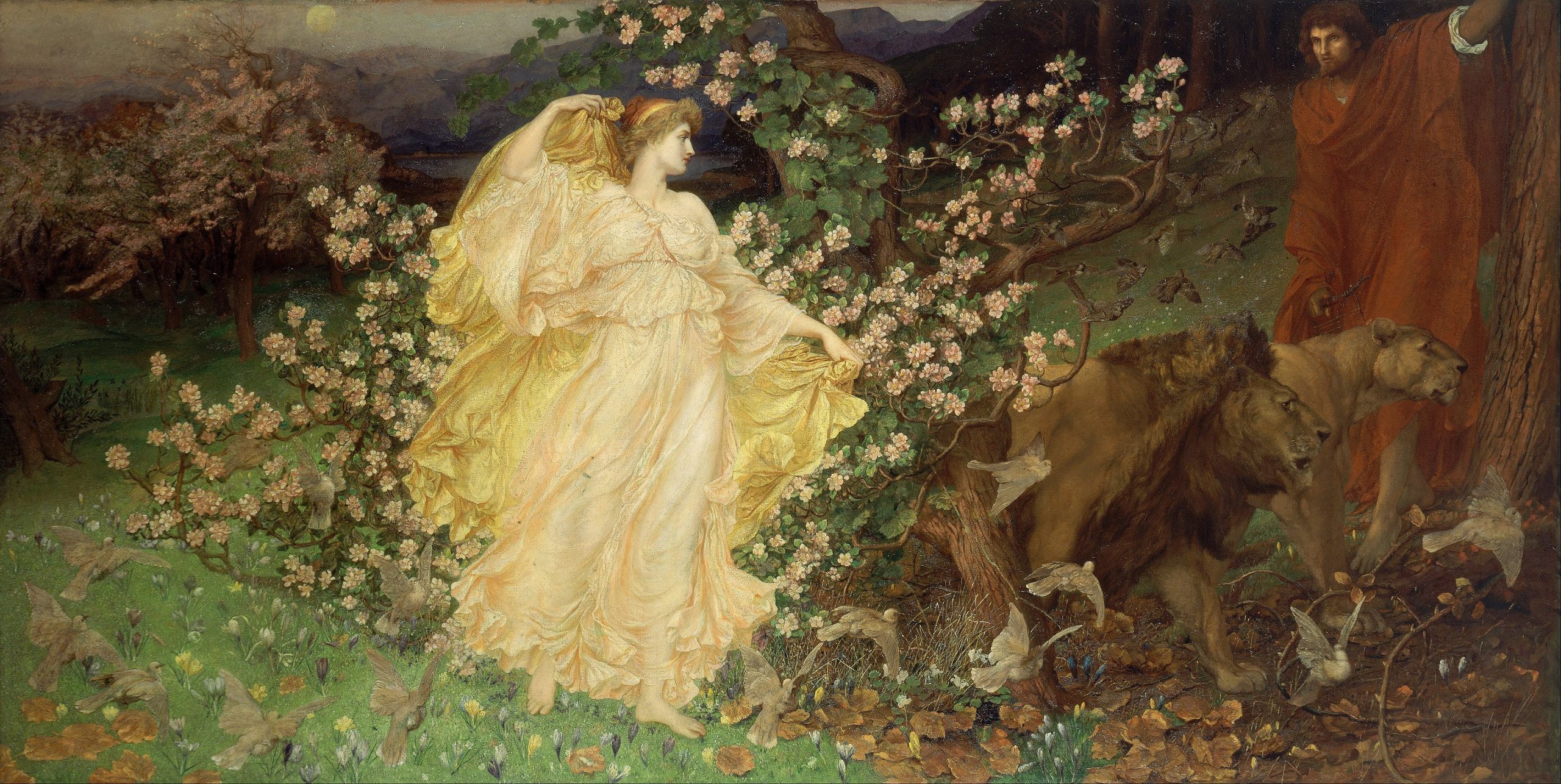
Courtesy: By William Blake Richmond – NwFx7tib70X5aQ at Google Cultural Institute maximum zoom level, Public Domain, https://commons.wikimedia.org/w/index.php?curid=21878516
“The Rose of the World” by William Butler Yeats
Who dreamed that beauty passes like a dream?
For these red lips, with all their mournful pride,
Mournful that no new wonder may betide,
Troy passed away in one high funeral gleam,
And Usna’s children died.
We and the labouring world are passing by:
Amid men’s souls, that waver and give place
Like the pale waters in their wintry race,
Under the passing stars, foam of the sky,
Lives on this lonely face.
Bow down, archangels, in your dim abode:
Before you were, or any hearts to beat,
Weary and kind one lingered by His seat;
He made the world to be a grassy road
Before her wandering feet.
For the writer, Ralph Waldo Emerson (1803-1882), the flowers, animals, mountains, rivers, and indeed, all of of the natural world reflected the wisdom of the Creator. Each part of nature represents a divine harmony that reflects larger universal truths about life and the mysteries of the universe. In this excerpt his 1836 book Nature, he connects art and nature to existential themes. Nature can be viewed as a grand work of art:
“A work of art is an abstract or epitome of the world. It is the result or expression of nature, in miniature. For, although the works of nature are innumerable and all different, the result or the expression of them all is similar and single. Nature is a sea of forms radically alike and even unique. A leaf, a sun-beam, a landscape, the ocean, make an analogous impression on the mind. What is common to them all,—that perfectness and harmony, is beauty. The standard of beauty is the entire circuit of natural forms,—the totality of nature; which the Italians expressed by defining beauty “il piu nell’ uno.” Nothing is quite beautiful alone: nothing but is beautiful in the whole. A single object is only so far beautiful as it suggests this universal grace. The poet, the painter, the sculptor, the musician, the architect, seek each to concentrate this radiance of the world on one point, and each in his several work to satisfy the love of beauty which stimulates him to produce. Thus is Art, a nature passed through the alembic of man. Thus in art, does nature work through the will of a man filled with the beauty of her first works.” (Emerson, Chapter 3, “Beauty” in Nature, 1836).
Where pine-trees plume the sky,
Where snowy peaks salute the sea
When herald winds pass by.
Wah ho! the day is blue,
The night with stars aglow;
And all the dreams come true
Up there—wah ho!
The meadows flush with flowers.
The gay birds sing a roundelay
Through all the crystal hours.
Wah ho! the sky is blue,
The world is soft as snow;
And all the dreams come true
Up there—wah ho!
Our stately house shall be.
Our feet shall tread beyond the pale
Of dull mortality.
Wah ho! the world is new,
And heaven is all aglow!
And every dream comes true
Up there—way ho!
Learning Objectives
- Discover and make connections between art and nature-themed poetry.
- View botanical paintings and illustrations as a way to further explore your thoughts, feelings, and ideas about the role of nature in your own life.
- Identify and explore the way poets and visual artists describe flowers, garden, and varied ecoscapes.
- Consider the way in which poets create visual images through words by using imagery and symbolism.
- Consider the way artists create visual images using color, line, shape, texture, form, and space.
- Essential Questions
How might we describe humankinds’ relationship with nature? How can destruction continue to take place, given the fragility of our planet? A warming planet has made forest fires a tragic reality on a regular basis; deforestation, species extinction, and the loss of vast habit for flora and fauna continue to threaten. How do we restore the balance, repair, and protect what is left of nature? The visual art and literature in this module intersect in multi-sensory and multi-modal ways that might encourage a new empathy and awareness of our natural environment where planetary protection can be a focus. In a world that for too long has been governed by a profit motive and rapacious capitalism, there is a renewed urgency to realign values and lifestyles so that a “new balance” might work to restore and repair collapsing ecosystems. As you read various sections of this module and view some of the art images and related links, consider ways that we can restore the grandeur of nature.
The art images, poems, and related texts throughout this chapter highlight the beauty, uniqueness, and intricacy of nature. The poems and art works The writers and artists that are highlighted in this chapter collectively challenge the reader to think about cosmic forces and the vast and varied landscapes of the world. Poems about birds, mammals, floral, and vast forests encourage readers to think about the meaning of life. Paintings and photographs can be a catalyst for contemplative reflection and awareness. Selected animal paintings, for example, that highlight the way animal mothers take care of their young can challenge viewers to think about the way humans treat each other.
-
It is also important to consider the positive steps that are being taken to restore the grandeur of nature. For example, a small community in Nepal worked collectively to grow back its forests. Barren mounds of red mud 15 years ago are now replaced with healthy trees. Karan Deep Singh and Bhadra Sharma (2022) write that thanks to innovative policies adopted by the government more than 40 years ago and millions of volunteers, large sections of land were revitalized and tree seedings planted. While human-animal conflict is a concern, overall the community’s efforts have been praised by environmentalists worldwide. Singh and Sharma (2022) write:
In the early 1980s, the government couldn’t persuade people to stop cutting trees for farmland and firewood the deforestation made floods and landslides more frequent, alarming the country’s leaders.
What followed was an enormous replantation effort that was bolstered by foreign aid. Villagers such as Karki planted seedings of rosewood on barren hills. Then they organized themselves in groups, each tasked with protecting the saplings in a designated spot and preventing locals from cutting grass for feed.
The challenge now is to sustain this fragile recovery. For the community foresters, that involves guarding their forests from the timber mafia, from poachers and from nature itself….Many community forests are adjacent to national parks, and their revival has allowed endangered plant and animal species, including the tiger, the one horned rhinoceros and the gharial, a crocodilian reptile, to thrive… (The New York Times)
- Explore Essential Questions
- What is missed when individuals are disconnected and removed from nature?
- How important is nature to you?
David Attenborough (2018) explains that most widespread and insidious dangers that have impacted the natural world are not only those that humanity deliberately inflicted, but those they have caused inadvertently. People did not fully understand the impact that coal production and the Industrial Revolution would have had on the natural world and subsequent habit and species destruction. Currently and in your view, what efforts are being made to restore the environment ?
- As you read some of the work by writers such as W.B. Yeats, William Wordsworth, Emily Dickinson, John Keats, Ralph Waldo Emerson, Henry David Thoreau, and Theodor Roethke, can you find common themes about nature and individuals’ relationship with nature? To what extent do you believe the poems (or other writing) by these writers can inspire awareness and an appreciation of nature?
- To what extent are the themes found in these poems and in the art images relevant today in terms of the importance of individuals’ interrelationship with nature? How do modern writers describe nature and our relationship with the natural world? Explore some of the work of one of the following contemporary poets and writers identified below:
- Wendell Berry,
- A.R. Ammons
- Ted Hughes
- Seamus Heaney,
- Joy Harjo
- Zakiya McKenzie
- Diane Beresford Kroeger
- Robert MacFarlane and Jackie Morris
To read more about Poetry and the Environment please open the Poetry Foundation link here
To read about Flowers and Flower Gardens by David Lester Richarson please open the link here.
There are also links connected to valuable articles on the natural environment and ecology.
- Additional Questions for DIscussion and Reflection
- Which art images and poems do you find most compelling? Which themes resonate with you
- Are there landscapes of nature that are “beyond man’s footsteps”? Even with resources, are there areas of nature where individuals should not go? If so, where?
- Photograph elements of nature and find or write poems that best describe the nature photograph. You can also collate a collage of art images found in magazines or online and create a photo-essay or poetry and pictures compilation.
- To what extent do geography and the climate influence individual personality traits, values, and attitudes?
- How have humans “shaped” the natural world in ways that have been harmful to all living things?
- In your view, what are the “wonders of nature”?
- How can the grandeur of nature be restored? How can hope be restored to the grandeur of nature?
- Using any poetric style, write your own poem (or poems) inspired by nature.
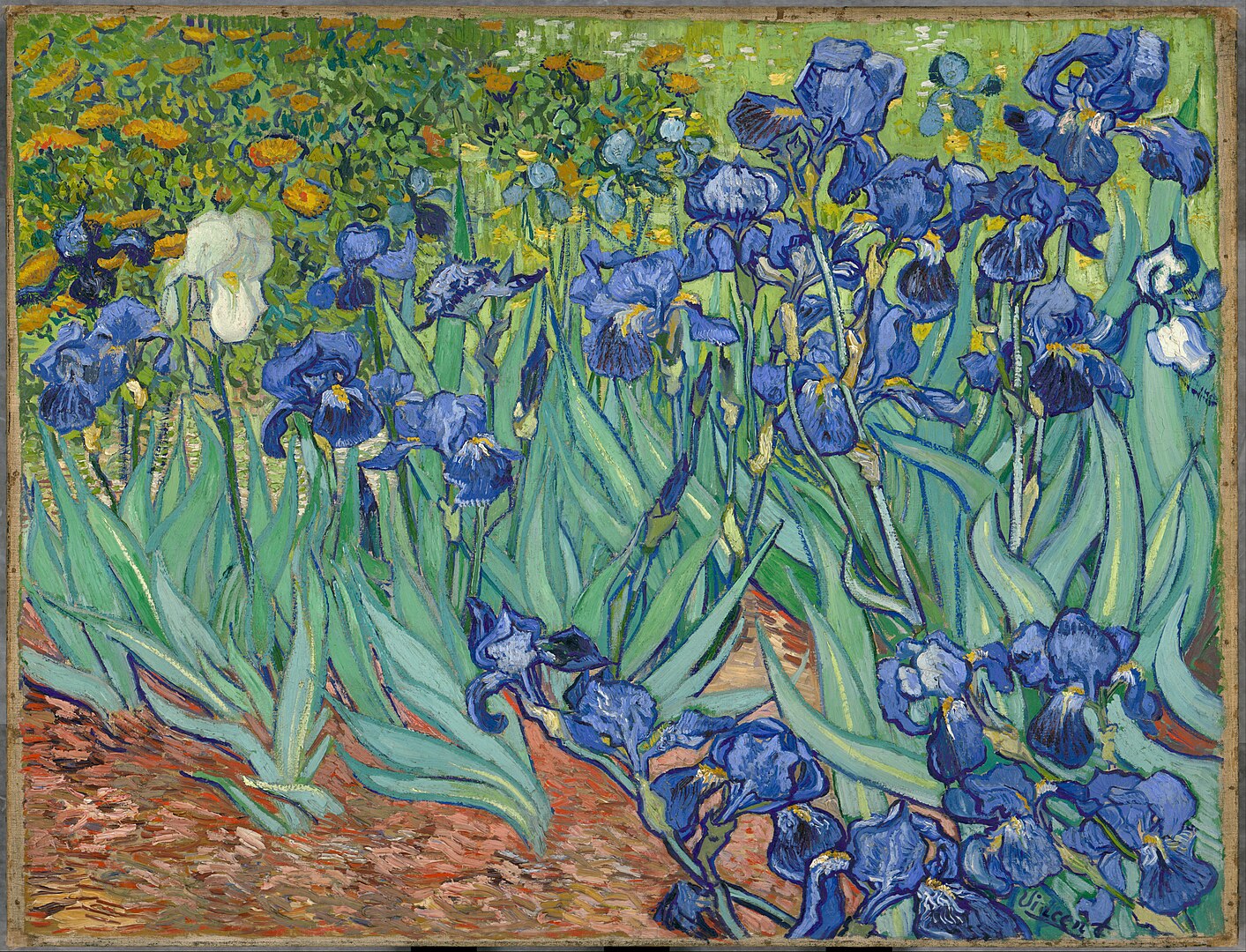
Courtesy: “https://www.getty.edu/art/collection/object/103JNH” is licensed under CC0 1.0.
“White Iris” by Bliss Carman
White Iris was a princess
In a kingdom long ago,
Mysterious as moonlight
And silent as the snow.
She drew the world in wonder
And swayed it with desire,
Ere Babylon was builded
Or a stone laid in Tyre.
Yet here within my garden
Her loveliness appears,
Undimmed by any sorrow
Of all the tragic years.
How kind that earth should treasure
So beautiful a thing—
All mystical enchantment,
To stir our hearts in spring!
The Beauty of Flowers
Exploring Flowers: American Museum of Natural History, New York City, New York.
“Think of some places near your home where you might find some flowers. Try to find at least three different flowers and draw a picture of each one. As you are drawing, you might want to think about these questions:
- Where did you find each flower?
- How would you describe it? (Colours, size, shape, etc.).
- How would you describe its stem? petals? leaves?
- Is this flower part of something else or is it growing by itself? (for example, is it part of a tree? a bush?)
- Are there more flowers like this one nearby?”
Additional Questions:
- Which flowers are your favourite? Why? Do you associate the flower with a particular memory/experience?
- Do you connect the flower with particular emotions—sadness, relief, happiness, etc.?
- Where did the flowers originate? (For example, Hollyhocks are well-known to North American gardeners but their origins are in Egypt and other part of the Middle East).
- Find artistic images of your favourite flower. Describe two-three of the art images. How close to the actual flower are the image? What can you discover about the artist who painted the flowers?
- Is the flower a native species or did the flower originate in another place and in a different temperature zone?
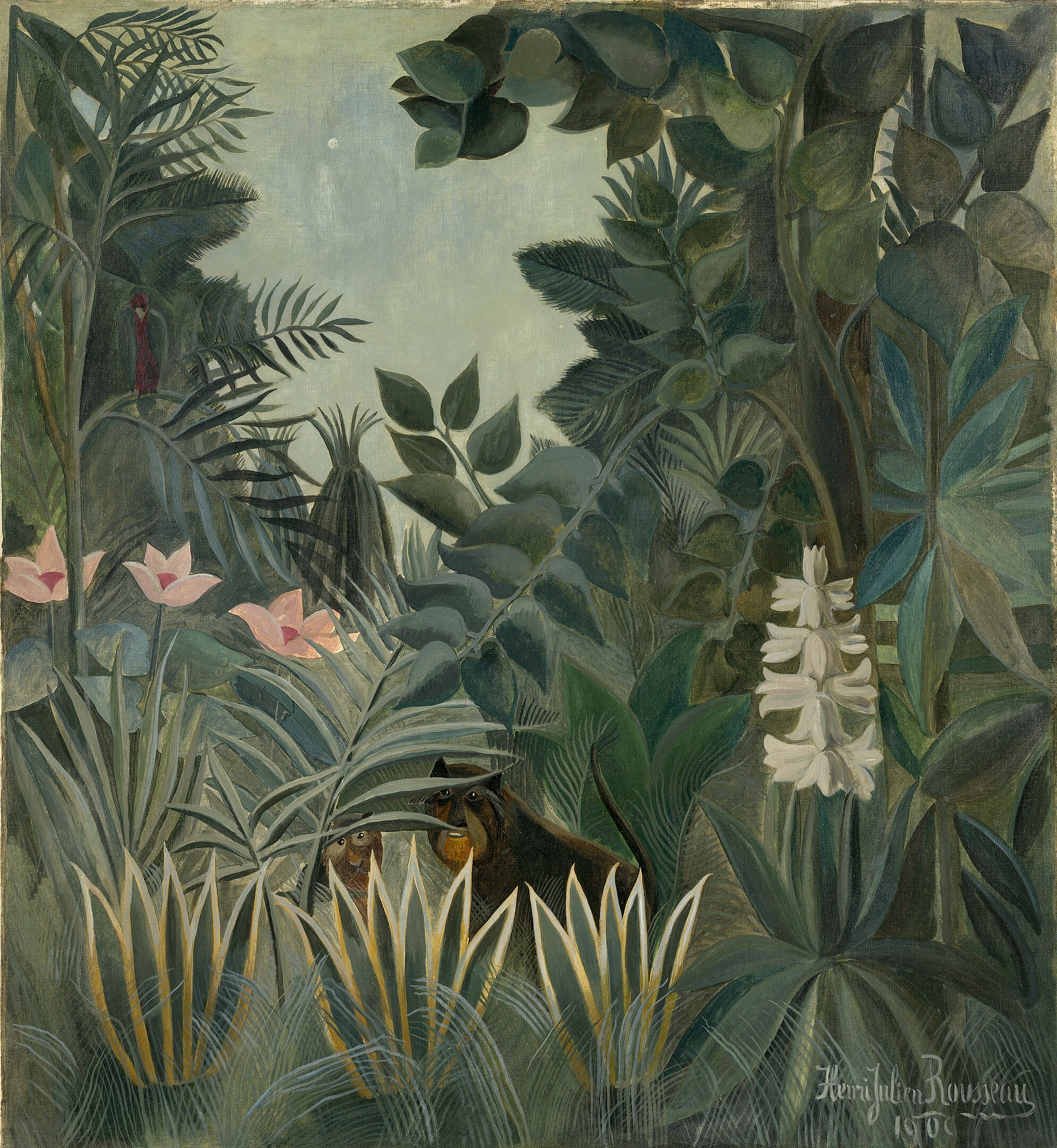
Courtesy: Chester Dale Collection. “https://www.nga.gov/collection/art-object-page.46688.html#inscription” is licensed under CC0 1.0.
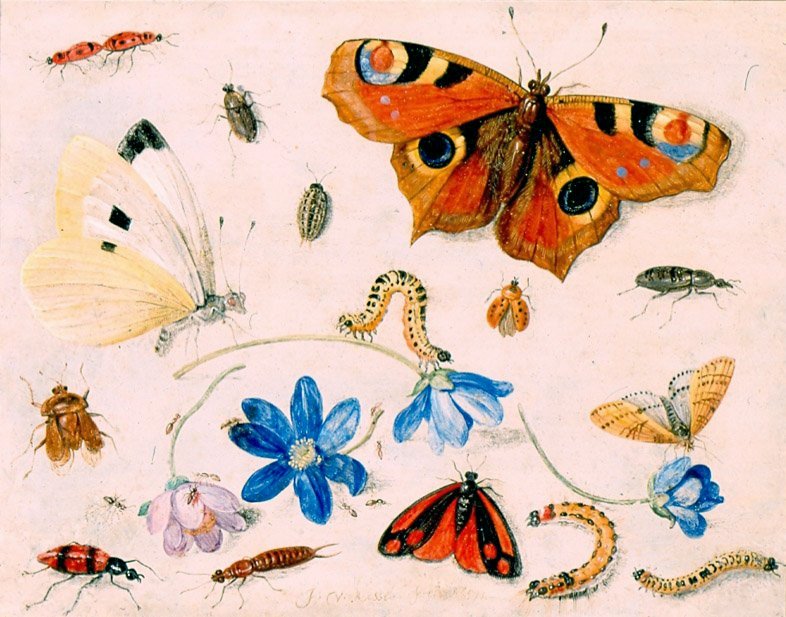
Courtesy: By Jan van Kessel (1626–1679) – High Museum of Art, Public Domain, https://commons.wikimedia.org/w/index.php?curid=28861422
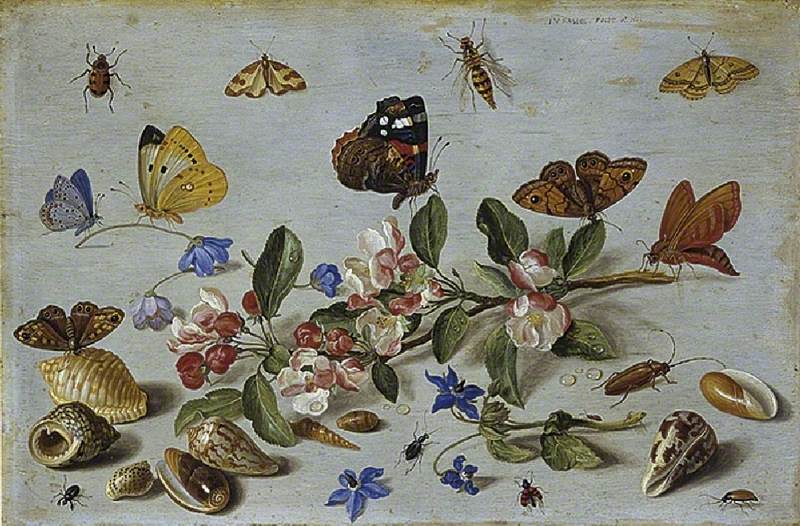
Courtesy: By Jan van Kessel the Elder – Art UK, Public Domain, https://commons.wikimedia.org/w/index.php?curid=91872292
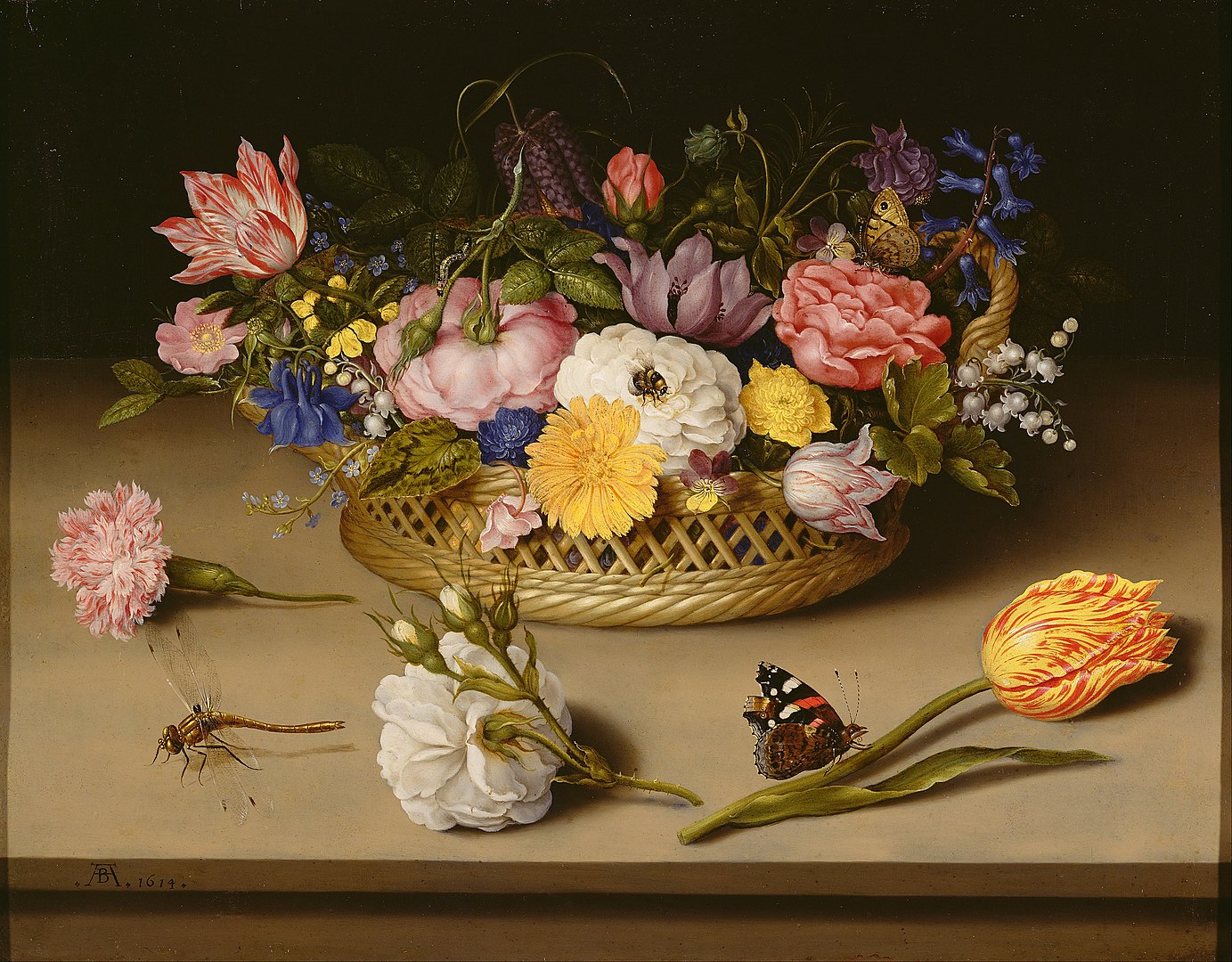
Courtesy: “https://www.getty.edu/art/collection/object/103RFM” is licensed under CC0 1.0.
“A pink carnation, a white rose, and a yellow tulip with red stripes lie in front of a basket with flowers, that would not bloom together: roses, forget-me-nots, lilies-of-the-valley, a cyclamen, a violet, a hyacinth, and tulips. Insects, short-lived like flowers, remind of the brevity of life and the transience of its beauty”.
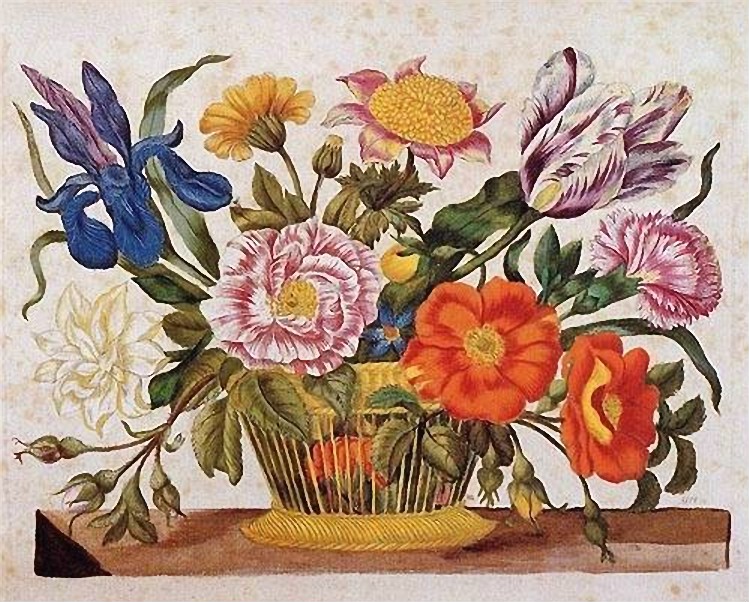
Courtesy: By Maria Sibylla Merian (1647-1717) – www.awg.musin.de/facharbeiten/merian/Facharbeit.htm, Public Domain, https://commons.wikimedia.org/w/index.php?curid=3354843
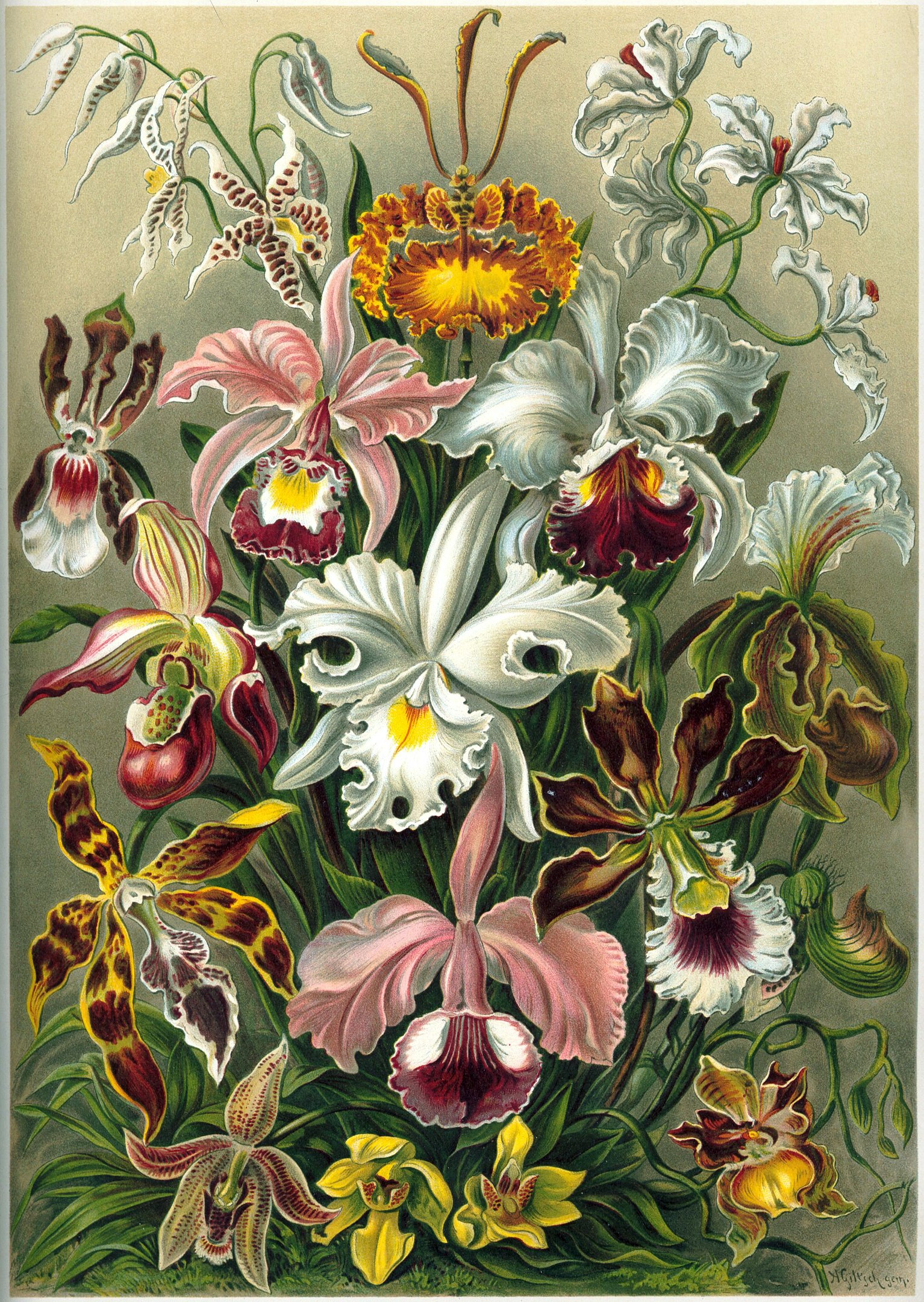
Courtesy: By Ernst Haeckel – Kunstformen der Natur (1904), plate 74: Orchidae (see here, here, here and here), Public Domain, https://commons.wikimedia.org/w/index.php?curid=536977
“The flower that smiles to-day” by Percy Bysshe Shelley
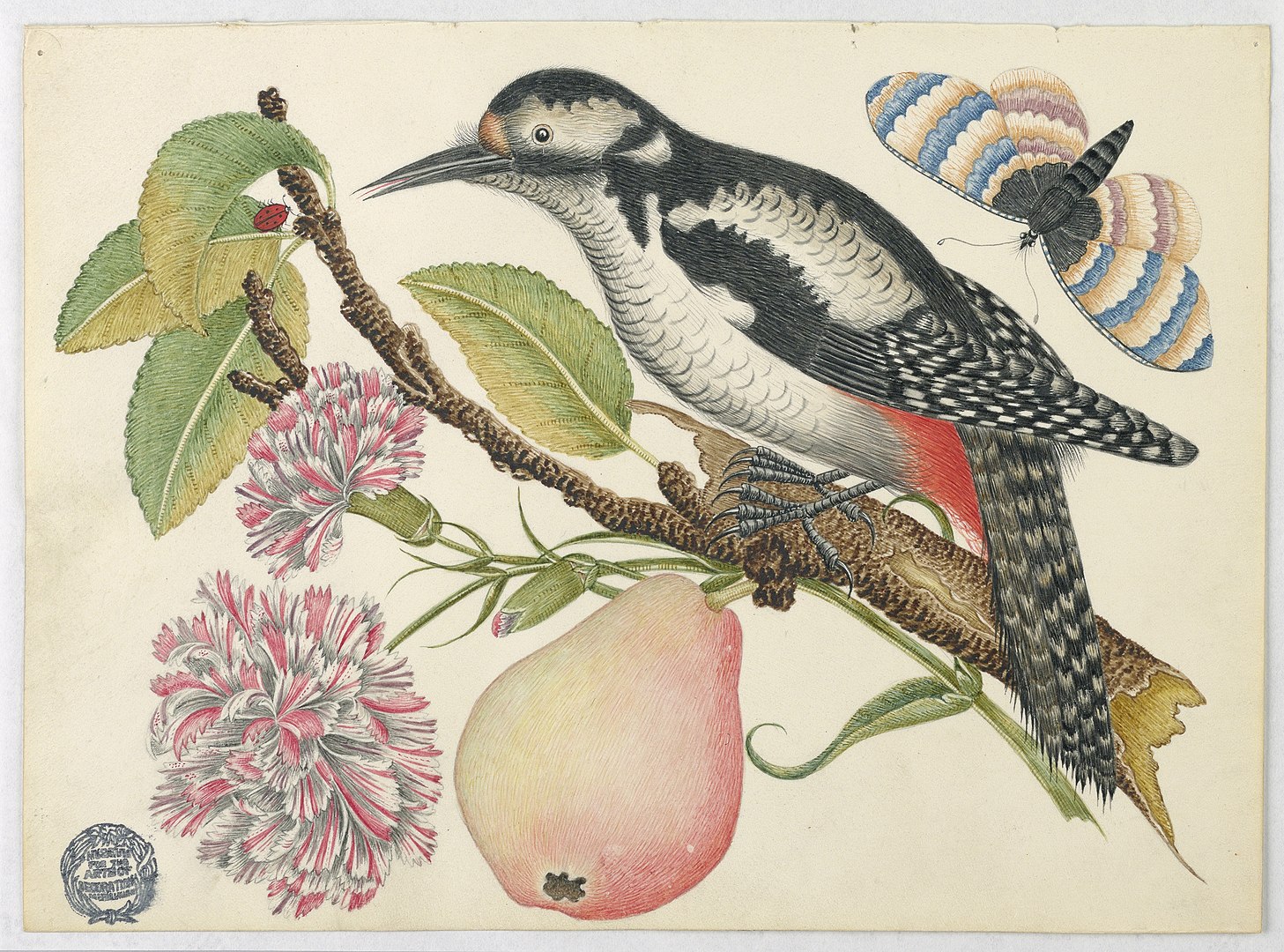
Courtesy: By Unknown artist – Catalog Photo, Public Domain, https://commons.wikimedia.org/w/index.php?curid=64600477
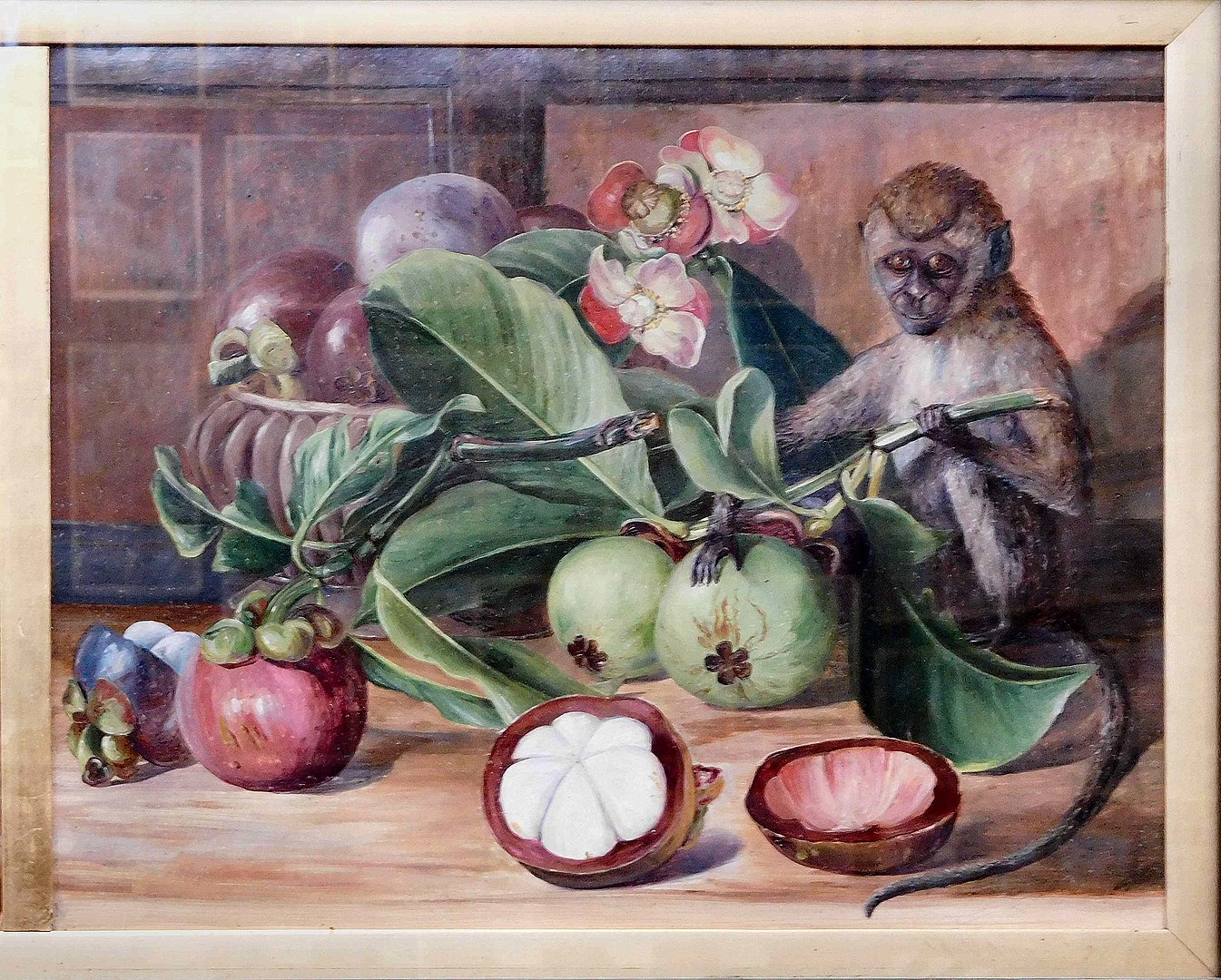
Courtesy: By User:Chiswick Chap – Own photographs of paintings, Public Domain, https://commons.wikimedia.org/w/index.php?curid=65572819
Examples of Flowers and their Symbolic Meaning
| Apple Blossom | Preference |
| Anemone | Forsaken |
| Amaryllis | Pride |
| Baby’s Breath | Eternal Love |
| Blue Bell | Humility |
| Carnation | Love |
| White Carnation | Innocence |
| Calla Lily | Beauty |
| Columbine (Purple) | Resolution |
| Crocus | Cheerfulness |
| Daffodil | Unequaled Love |
| Edelweiss | Promise of Dedication / Devotion |
| Forget-me-not | True Love/ Memories |
| Gladiola | Strength: Flower of the gladiators |
| Iris | Faith; Hope; Wisdom; Trust |
| Marigold | Grief |
| Mint | Virtue |
| Maltese Cross | Heroism / Courage |
| Lily | Purity |
| Pink Rose | Happiness |
| Rosemary | Remembrance |
| Sunflower | Positivity and Strength / Longevity |
*To read more about flower symbolism and the language of flowers, please open the links here, here,
and here.
Additional References:
Flower Symbolism of the Great Masters by Elizabeth Haig
Video: The Magic of the Night Blooming Cereus Flower
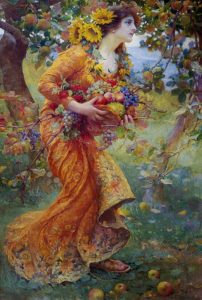
Courtesy: By František Dvořák (1862-1927) – http://www.pinterest.com/8andyyang8/franz-dvorak/, Public Domain, https://commons.wikimedia.org/w/index.php?curid=29668053
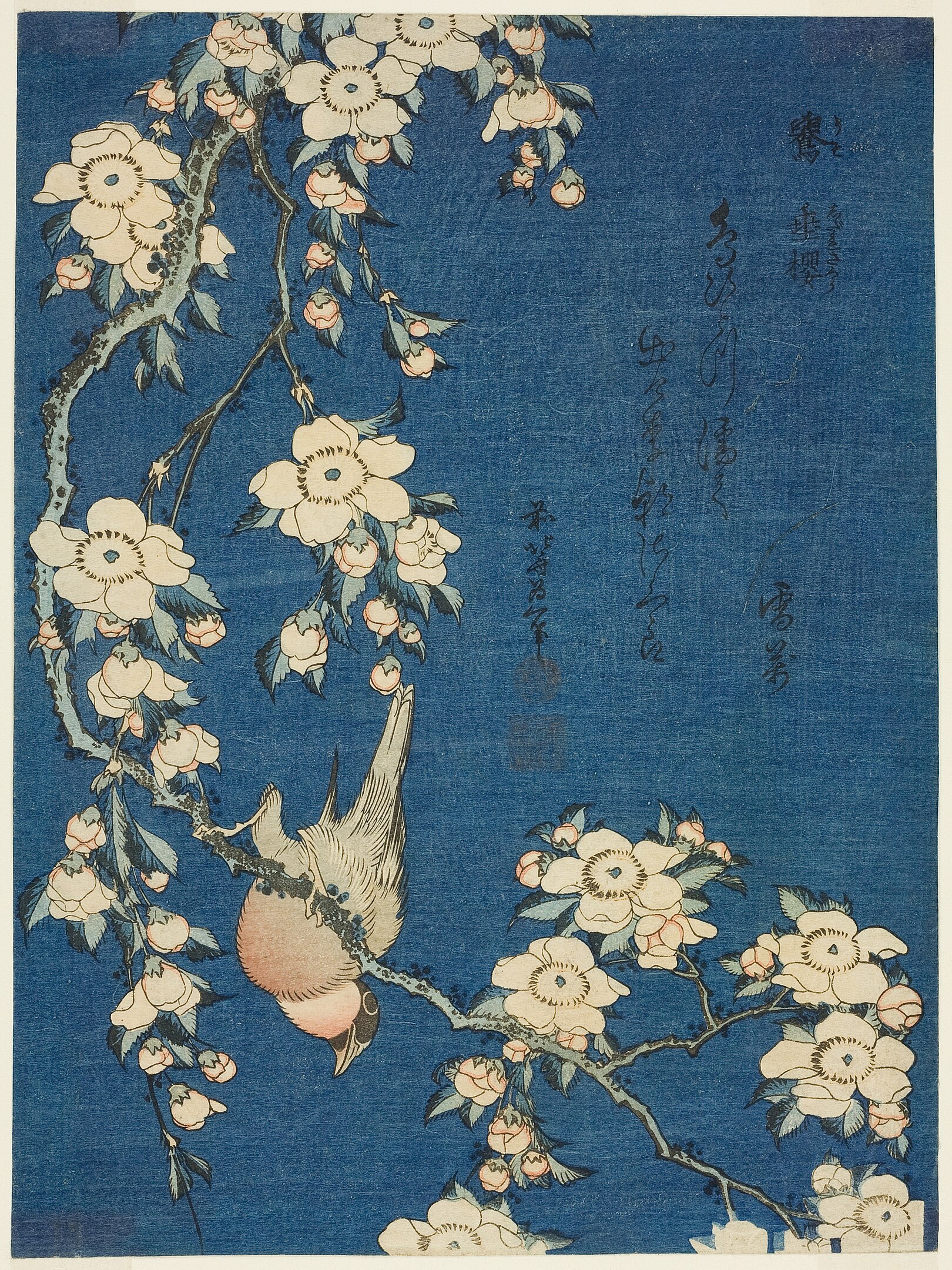
Courtesy: Clarence Buckingham Collection. “https://www.artic.edu/artworks/25093/bullfinch-and-weeping-cherry-uso-shidarezakura-from-an-untitled-series-of-flowers-and-birds” is licensed under CC0 1.0.
“The Cherry Blossoms” by Tanehiko
The cherry blossoms,
Return at dawn from the Yoshiwari
Was it the goddess of Mt. Katsuragi?
Source: R.H. Blyth (1949/1981). Haiku (Volume 1) Eastern Culture. p. 99. The Hokuseido Press, Tokyo, and Heian International (S. San Francisco).
“Lay cherry blossoms” by Saigyō Hōshi
Lay cherry blossoms
Before the Buddha,
Should you wish to pray for my soul.
In the world to come.
(Saigyō Hōshi (西行法師, 1118 – March 23, 1190), translated by R. H. Blyth (1894-1964) in Blythe, R.H. (1949). Haiku, Volume I Eastern Culture. The Hokuseido Press and Heian International (p. 112).
To read more about the life and scholarly contributions of Reginald Horace Blyth and his expertise on Japanese culture and the art of Haiku, please open the link here.
For more information about Haiku poems please access this link here.
“In the cherry blossom’s shade” by Kobayashi Issa
(English version by Robert Hass. Original Language Japanese)
In the cherry blossom’s shade
there’s no such thing
as a stranger.
Additional Reference
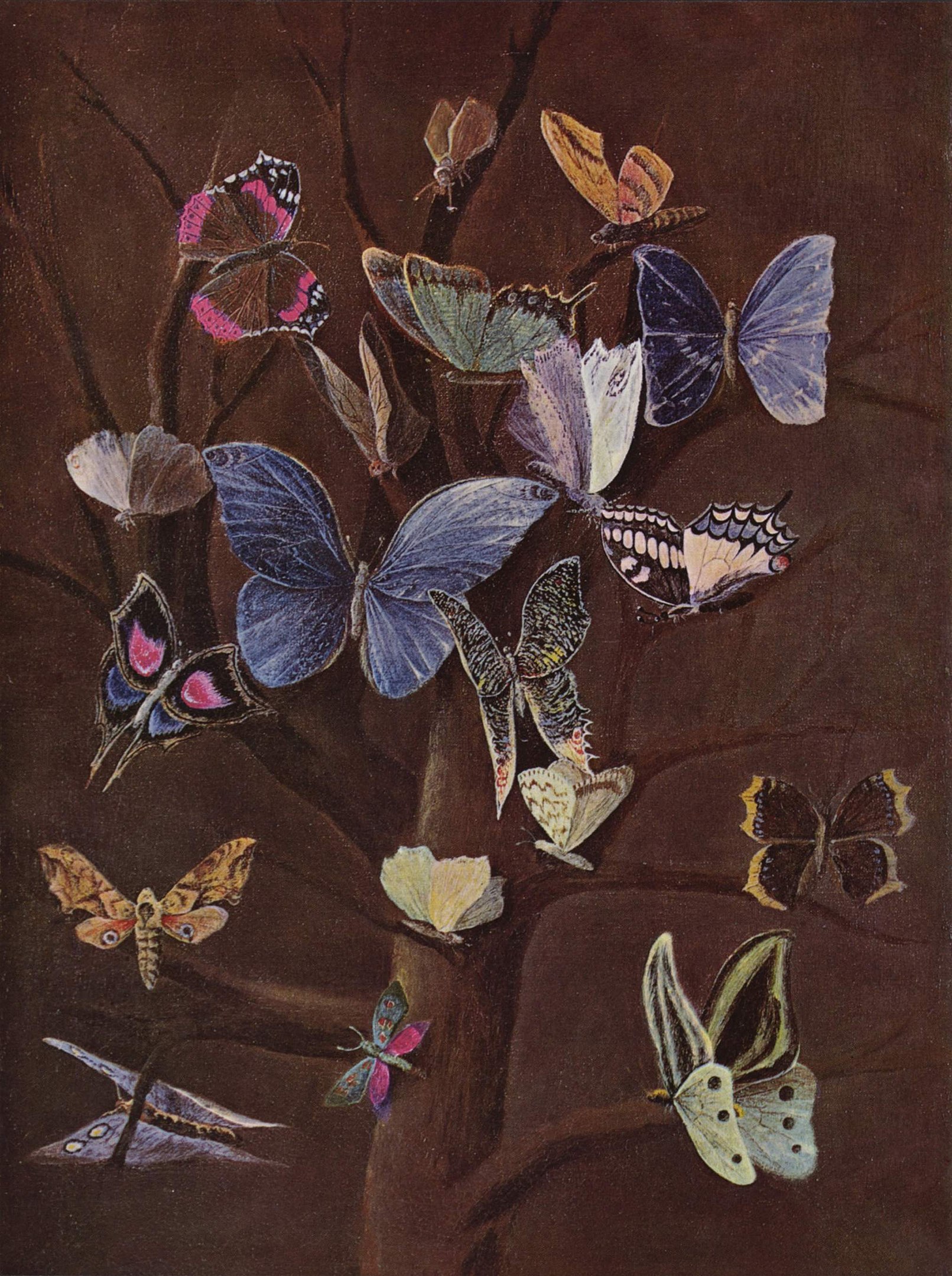
Courtesy: By Wilhelm von Kaulbach – The Yorck Project (2002) 10.000 Meisterwerke der Malerei (DVD-ROM), distributed by DIRECTMEDIA Publishing GmbH. ISBN: 3936122202., Public Domain, https://commons.wikimedia.org/w/index.php?curid=153371
“Two Butterflies went out at Noon— (533)” by Emily Dickinson
Two Butterflies went out at Noon—
And waltzed above a Farm—
Then stepped straight through the Firmament
And rested on a Beam—
And then—together bore away
Upon a shining Sea—
Though never yet, in any Port—
Their coming mentioned—be—
If spoken by the distant Bird—
If met in Ether Sea
By Frigate, or by Merchantman—
No notice—was—to me.
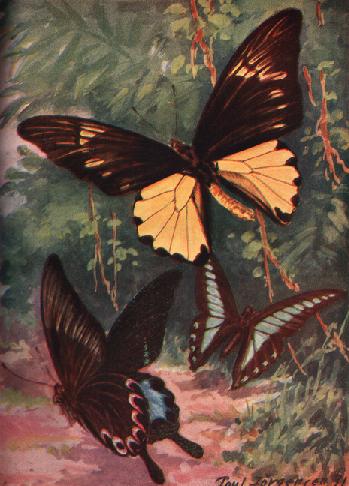
Courtesy: By Alfred Brehm ; Paul Jorgensen ? – Brehm.Till vänster en färgillustration (=målning) kallad Tropiska fjärilar. Ur Brehm: Djurens liv, Malmö1931, Public Domain, https://commons.wikimedia.org/w/index.php?curid=2209401
- To view more illustrations from the books of Alfred Brehms, please open the link here.
- Brehm’s Life of Animals: Biodiversity Heritage Library and Internet Archive
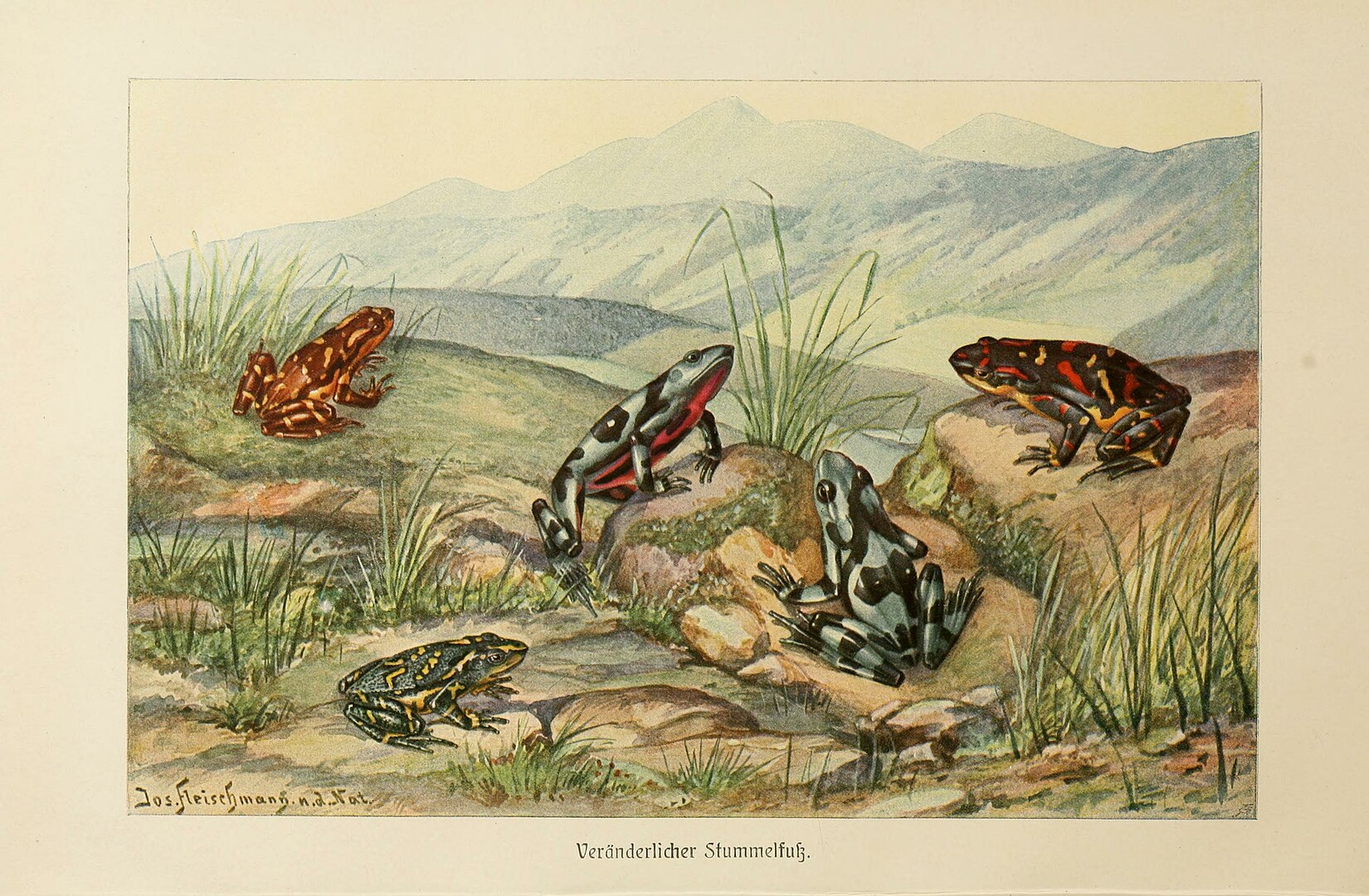
Courtesy: By Bibliographisches Institut Leipzig.; Brehm, Alfred Edmund; Heck, Ludwig; Hempelmann, Friedrich; Heymons, Richard; Marshall, William; Werner, Franz; Zur Strassen, Otto – https://www.biodiversitylibrary.org/pageimage/2977719, Public Domain, https://commons.wikimedia.org/w/index.php?curid=44641563
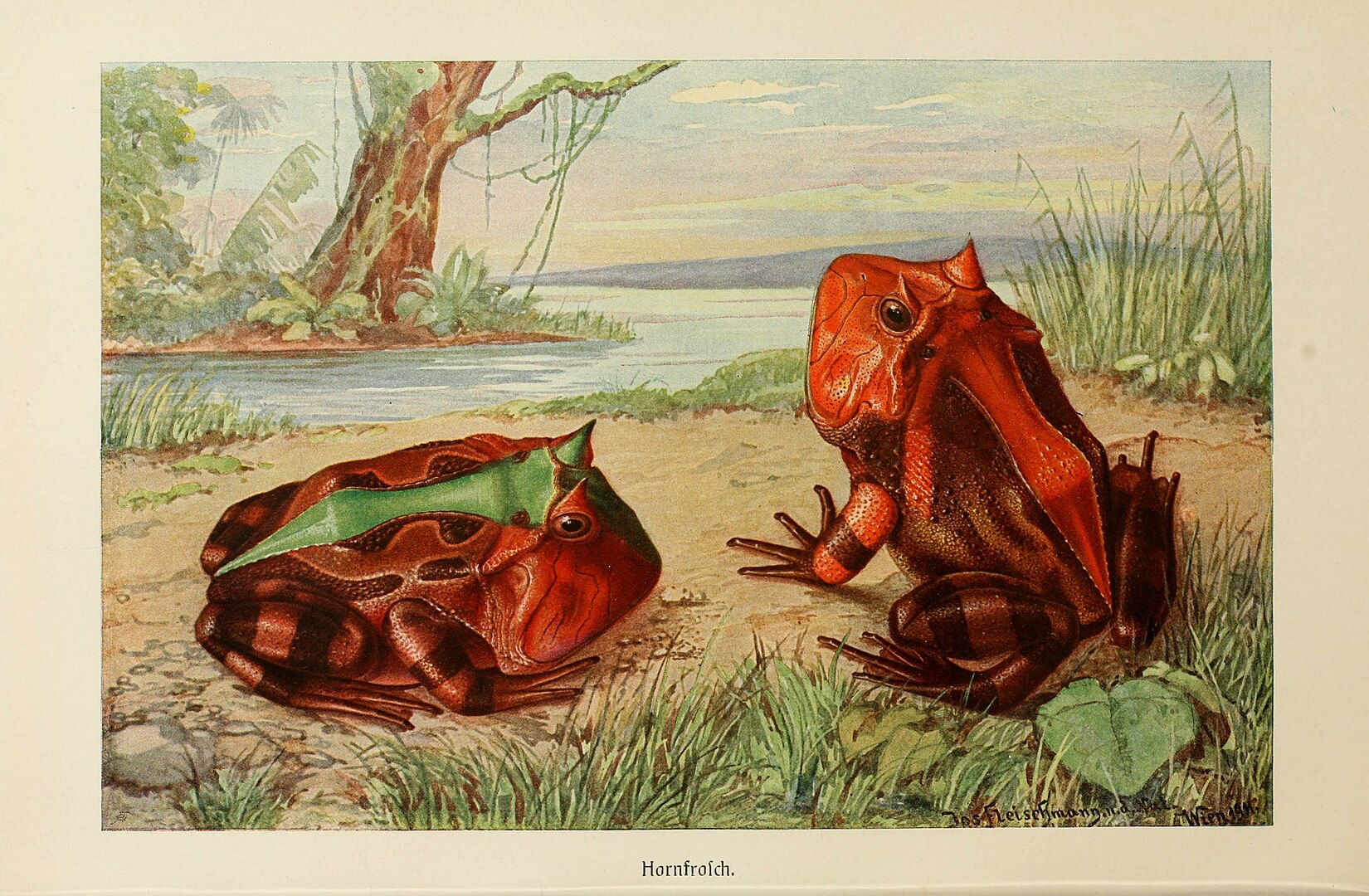
Courtesy: By Bibliographisches Institut Leipzig.; Brehm, Alfred Edmund; Heck, Ludwig; Hempelmann, Friedrich; Heymons, Richard; Marshall, William; Werner, Franz; Zur Strassen, Otto – https://www.biodiversitylibrary.org/pageimage/2977699, Public Domain, https://commons.wikimedia.org/w/index.php?curid=44641428
Learning Objectives
- Discover more about the transcendentalist movement in poetry by reading and reflecting on their poetry.
- Explore deeper connections between poems and visual images.
- Discover and make connections between the themes in transcendentalist poems with your observations and insights into nature today.
- The Transcendentalist Movement in Poetry: The Universal Being in Nature
- A group of poets that included Ralph Waldo Emerson, Bronson Alcott Henry David Thoreau, Emily Dickinson, and Margaret Fuller developed a literary and philosophical movement in New England in the early and middle part of the 19th century.
- “The poetry of the Transcendentalist movement is characterized by its focus on the individual, the natural world, and the search for truth and meaning. Transcendental poetry has a lyrical and straight-forward style; nature and the individual’s search for existential meaning in the cosmos is explored. Poetry and art were vehicles of self-expression and an exploration of the inner landscape of the psyche. Collectively these artists’ works affirmed the goodness of people and the importance interrelationship between humankind and the natural world. Inspired by the Romantic poets such as Alfred Lord Byron, John Keats, and William Wordsworth, these poets viewed the divine in nature. Artistic works from this time period also highlight the grandeur and beauty of nature. The ideas of these writers are relevant today in a time of climate crises, deforestation, marine life depletion, and species extinction. In reading their work and in viewing paintings from this time period from a 21st century lens, new insights can emerge that shed light not only on past actions but creating a pathway forward that protects, cherishes, and repairs the natural world.The pressure to exploit and commodify nature to suit the growing demands of the “machine age” and the industrial revolution in the 19th century was met by opposition by many, including artists and writers like Thomas Hardy, the Bronte sisters, and Charles Thomas Carlyle. In their view, individuals were increasingly becoming alienated and disconnected from nature. Spiritual awareness and a communion with the divine could be found if one connected in profound ways with nature. Writers like Ralph Waldo Emerson wrote that humans for the most part did not appreciate or cherish nature’s beauty and miracles. Nature can be a guide and important life lessons can be learned from an exploration of nature. This fracture and disconnect needs to be restored and regenerated. The disconnection between the individual and nature has “disrupted” the intricate interconnection that individuals should have with the natural world. Rather than view nature as a commodity to be exploited, a reverence for the beauty of the natural world could heal, inspire, and unify. Solitude and contemplation in natural settings would help individuals connect with transcendent realms of the divine.
Ralph Waldo Emerson and Nature
Waldo Emerson’s book Nature was written in 1836. Emerson writes that nature can be a guide, an inspiration, and companion. Nature is viewed as the harmony the exists between the natural world and individuals. Many nature poets and writers like Emerson lived at a time where there was easy access to the natural environment. His writing challenges individuals to think about what is missed or lost when communion with nature does not exist. For Emerson, daily contact with nature became essential to fulfilling spiritual, physical, cognitive, and emotional needs, as essential as water and food. Reciprocal relationships between individuals and nature should lead to sustainable and healthy outcomes. Both the romantic and transcendental poets re-imagined and reconceptualized the divine as something all encompassing and universal. Nature was viewed as a “universal being” that could help individuals connect with higher spiritual realms of existence. Through awareness and empathy, destructive tendencies could be transformed into peaceful ways of being. Nature can inspire curiosity and a quest for learning about spiritual dimensions of life. Emerson’s “Nature” focuses on eight dimensions of nature and the relationship individuals have with nature: Nature, Commodity, Beauty, Language, Discipline, Idealism, Spirit, and Prospects. Intuition, individual experience, self-expression, self-awareness, a belief in spiritual values, and empathy took precedence over reason, logic, control, and detachment. In the following excerpts, Emerson (1836) further writes about the power of nature to serve as a guide, inspiration, and companion:
- “But if a [person] would be alone, let [her/him] look at the stars. The rays that come from those heavenly worlds, will separate between him and what he touches. One might think the atmosphere was made transparent with this design, to give man, in the heavenly bodies, the perpetual presence of the sublime. Seen in the streets of cities, how great they are! If the stars should appear one night in a thousand years, how would [individuals] believe and adore; and preserve for many generations the remembrance of the city of God which had been shown! But every night come out these envoys of beauty and light the universe with their admonishing smile…” (Emerson, 1836, Chapter 1, Excerpt from “Nature)
- “Nature is a setting that fits equally well a comic or a mourning piece. In good health, the air is a cordial of incredible virtue. Crossing a bare common, in snow puddles, at twilight, under a clouded sky, without having in my thoughts any occurrence of special good fortune, I have enjoyed a perfect exhilaration. I am glad to the brink of fear. In the woods too, a man casts off his years, as the snake his slough, and at what period soever of life, is always a child. In the woods, is perpetual youth. Within these plantations of God, a decorum and sanctity reign, a perennial festival is dressed, and the guest sees not how he should tire of them in a thousand years. In the woods, we return to reason and faith.” (Emerson, 1836, Chapter 1, Excerpt from “Nature”).
-
- “But in other hours, Nature satisfies by its loveliness, and without any mixture of corporeal benefit. I see the spectacle of morning from the hill-top over against my house, from day-break to sun-rise, with emotions which an angel might share. The long slender bars of cloud float like fishes in the sea of crimson light. From the earth, as a shore, I look out into that silent sea. I seem to partake its rapid transformations: the active enchantment reaches my dust, and I dilate and conspire with the morning wind. How does Nature deify us with a few and cheap elements! Give me health and a day, and I will make the pomp of emperors ridiculous. The dawn is my Assyria; the sun-set and moon-rise my Paphos, and unimaginable realms of faerie; broad noon shall be my England of the senses and the understanding; the night shall be my Germany of mystic philosophy and dreams. ” (Emerson, 1836, Chapter One in Nature).
- Emerson (1836) writes that the multimodal sensory experiences nature provides that cannot be communicated through words alone. In Emerson’s writing, He comments on the importance of writers being able to convey the living forces of nature through descriptive words:
-
- The poet, the orator, bred in the woods, whose senses have been nourished by their fair and appeasing changes, year after year, without design and without heed,—shall not lose their lesson altogether, in the roar of cities or the broil of politics. Long hereafter, amidst agitation and terror in national councils,—in the hour of revolution,—these solemn images shall reappear in their morning lustre, as fit symbols and words of the thoughts which the passing events shall awaken. At the call of a noble sentiment, again the woods wave, the pines murmur, the river rolls and shines, and the cattle low upon the mountains, as he saw and heard them in his infancy. And with these forms, the spells of persuasion, the keys of power are put into his hands. (Emerson, Chapter 4, “Language” in Nature, 1836).
-
- To read Ralph Waldo Emerson’s please click here “Nature”.
Alex McGraw (2020) explains that transcendentalism could be viewed as a movement, a way of being and a view of life that that inspired nonconformity and independence. There were three major tenets of transcendentalism: one was a belief that God was reflected in all dimensions of nature, and that through contemplation and intuition everyone is a capable of learning about the existence of the divine in nature; and, there was the belief that all of nature symbolized the spirit and that the world was basically good. The ideals of transcendentalism have found new meaning in the some of the environmental movements of today.
Click on the links below for more information about Transcendentalism in Poetry.
- Transcendentalism in Poetry
- McGraw, A. (2020). Transcendentalism: Transforming the Literary Terrain. Retrieved October 17, 2022.
- Transcendentalism, Native American Theology, and Sámi Worldview. Slaton, A (2020).
- Tapestry Institute and Indigenous World Views
- Communing with Nature through Solitude
- To read Ralph Waldo Emerson’s please click here “Nature”.
-
Teaching and Learning Resources
PBS Learning Media:
United Nations Educational, Scientific, and Cultural Organization (UNESCO):
- World Earth Day: Planning Education, Protecting our Planet
- UNESCO and Sustainability in Classrooms
- Earth Day: We must reconcile humans with nature
Poems by W.H. Davies (1871-1940) – Welsh Poet
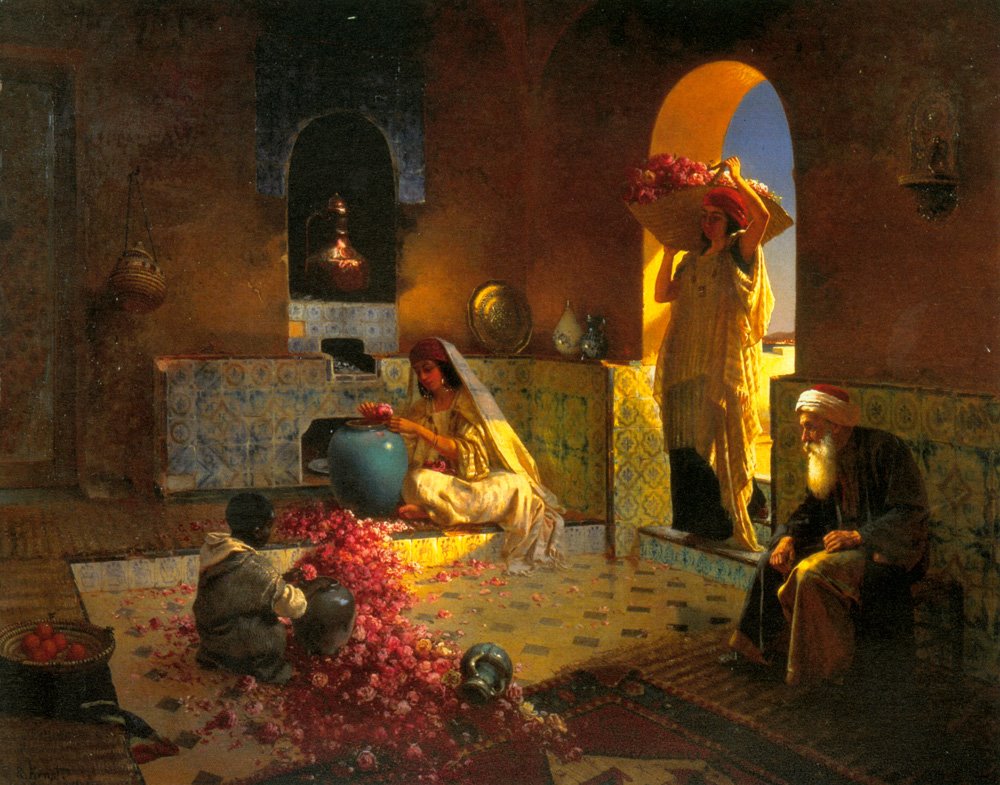
Courtesy: By Rudolf Ernst – http://bp0.blogger.com/_mX94yVHB_CI/R9sVhMe7fAI/AAAAAAAAC30/YOmpsDwmewY/s1600-h/The_Perfume_Maker_Oil_On_Panel.jpg, Public Domain, https://commons.wikimedia.org/w/index.php?curid=6879871
A Rose Has Thorns As Well As Honey
by Christina Rossetti
I’ll not have her for love or money;
An iris grows so straight and fine,
That she shall be no friend of mine;
Snowdrops like the snow would chill me;
Nightshade would caress and kill me;
Crocus like a spear would fright me;
Dragon’s-mouth might bark or bite me;
Convolvulus but blooms to die;
A wind-flower suggests a sigh;
Love-lies-bleeding makes me sad;
And poppy-juice would drive me mad: –
But give me holly, bold and jolly,
Honest, prickly, shining holly;
Pluck me holly leaf and berry
For the day when I make merry.
Resources and References
Audio Recording of Henry David Thoreau’s Nature Poems (Internet Archive)
Ecosystem collapse ‘inevitable’ unless wildlife losses reversed
Nature Poems of Henry David Thoreau (1817-1862)
News Article: Urgency is Needed to Restore the Grandeur of Nature
The Transformative Power of Nature Poetry and Art
Artists and poets throughout time have revered the beauty of nature and expressed their feelings in their work. Romantic poets such as John Keats, William Wordsworth, and William Blake wrote about the majestic quality of the landscape and the transformative power of nature to inspire. Great 19th century poets such as Emily Dickinson, Christina Rosetti, Sara Teasdale, Henry David Thoreau, and Walt Whitman wrote transcendental and metaphysical poems about nature as a reflection of a higher power. We can revisit these poems to discover new meaning and relevance for 2023-a time where, more than ever, empathy and care for non-human beings and the environment are urgently needed. Collectively, these poems highlighted individual experience, intuition, the presence of a higher power/order found in nature, and the essential interconnection between humans and nature. There is a lyrical and straightforward style to their poems that make them accessible for readers today. In art, the paintings of Rosa Bonheur, Vincent Van Gogh, Albert Bierstadt, Caspar David Friedrich, and Johann Christian Dahl exemplify the mystical beauty of landscapes and non-human life.
You can select the poems and art images that you find most compelling and further research their origins and relevance for today. You can find other art images (classic and contemporary) that would best complement the poems you found or created yourself.
“The Tables Turned” by William Wordsworth
Up! up! my Friend, and quit your books;
Or surely you’ll grow double:
Up! up! my Friend, and clear your looks;
Why all this toil and trouble?
The sun above the mountain’s head,
A freshening lustre mellow
Through all the long green fields has spread,
His first sweet evening yellow.
Books! ’tis a dull and endless strife:
Come, hear the woodland linnet,
How sweet his music! on my life,
There’s more of wisdom in it.
And hark! how blithe the throstle sings!
He, too, is no mean preacher:
Come forth into the light of things,
Let Nature be your teacher.
She has a world of ready wealth,
Our minds and hearts to bless—
Spontaneous wisdom breathed by health,
Truth breathed by cheerfulness.
One impulse from a vernal wood
May teach you more of man,
Of moral evil and of good,
Than all the sages can.
Sweet is the lore which Nature brings;
Our meddling intellect
Mis-shapes the beauteous forms of things:—
We murder to dissect.
Enough of Science and of Art;
Close up those barren leaves;
Come forth, and bring with you a heart
That watches and receives.
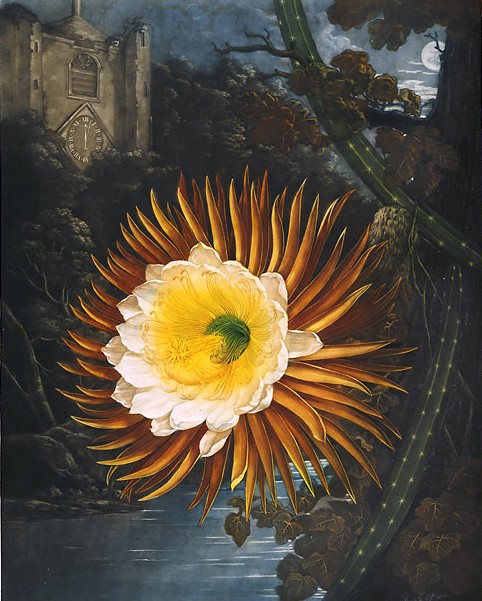
Courtesy: By Robert John Thornton (1768-1837) – Botanicus http://www.botanicus.org “Temple of Flora”, Public Domain, https://commons.wikimedia.org/w/index.php?curid=3622566
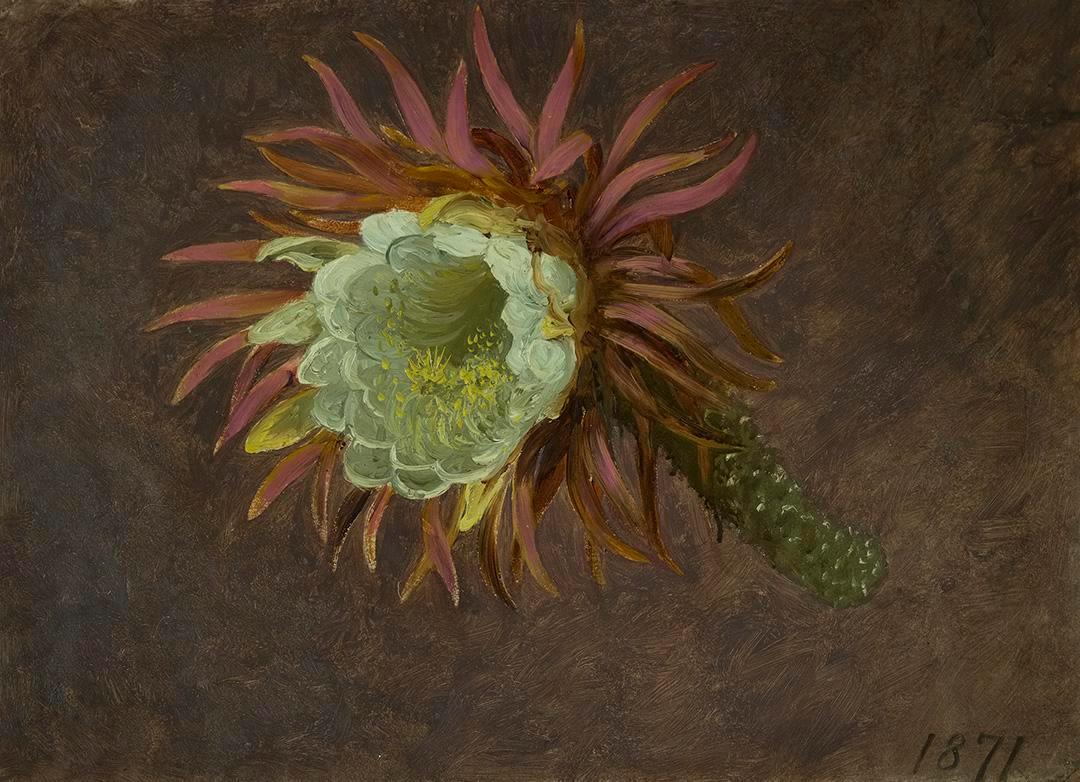
Courtesy: By Martin Johnson Heade – Crystal Bridges Museum of American Art, Public Domain, https://commons.wikimedia.org/w/index.php?curid=97450718
“The Night-Blooming Cereus” by Harriet Monroe
FLOWER of the moon!
Still white is her brow whom we worshiped on earth long ago;
Yea, purer than pearls in deep seas, and more virgin than snow.
The dull years veil their eyes from her shining, and vanish afraid,
Nor profane her with age—the immortal, nor dim her with shade.
It is we are unworthy, we worldlings, to dwell in her ways;
We have broken her altars and silenced her voices of praise.
She hath hearkened to singing more silvern, seen raptures more bright;
To some planet more pure she hath fled on the wings of the night,—
Flower of the moon!
Yet she loveth the world that forsook her, for, lo! once a year
She, Diana, translucent, pale, scintillant, down from her sphere
Floateth earthward like star-laden music, to bloom in a flower,
And our hearts feel the spell of the goddess once more for an hour.
See! she sitteth in splendor nor knoweth desire nor decay,
And the night is a glory around her more bright than the day,
And her breath hath the sweetness of worlds where no sorrow is known;
And we long as we worship to follow her back to her own,—
Flower of the moon!
“The Night is Darkening Round Me” by Emily Brontë
Excerpt from David Attenborough, Life on Earth: The Greatest Story Ever Told. William, Collins (2018) (First Published in 1979).
“Species are not eternal. They come into existence as one kind of animal evolves a particular way to collect food, defend itself, and reproduce. But the world around them may change. Rivals may evolve that have new and more efficient ways of feeding. Enemies may appear that are more powerful and dangerous. If such things happen, a species must respond either by abandoning some of its territory and living only in an unchanged part of it, or evolving more effective ways of defending itself and gathering its food. If it does the first it may survive for a very long time indeed. If it does the second, it will, over generations, change and eventually become a new specieis. If it fails to do either, it becomes extinct…
The vast number of of species that exist today, which we still have not completely catalogued, has come into existence. Its complexity, its vast web of interrelationships and dependencies, is almost beyond comprehension. So complex it is, that we cannot predict with any certainty or accuracy the effects of damage to any one part of it. But that complexity is something we must do our utmost to product, for it is that which enables it to absorb the worst effects of damage and to heal itself.
Human beings are part of this complex community. We depend on the natural world for every mouthful of food we eat and evey lungful of air we breathe. Our health depends on its health. We are now by far the most powerful single species that has ever existed on earth. That power brings great responsibility.
It is a now up to us to care for the planet and for all the other creatures for whom it is home” (p. 329- 333).
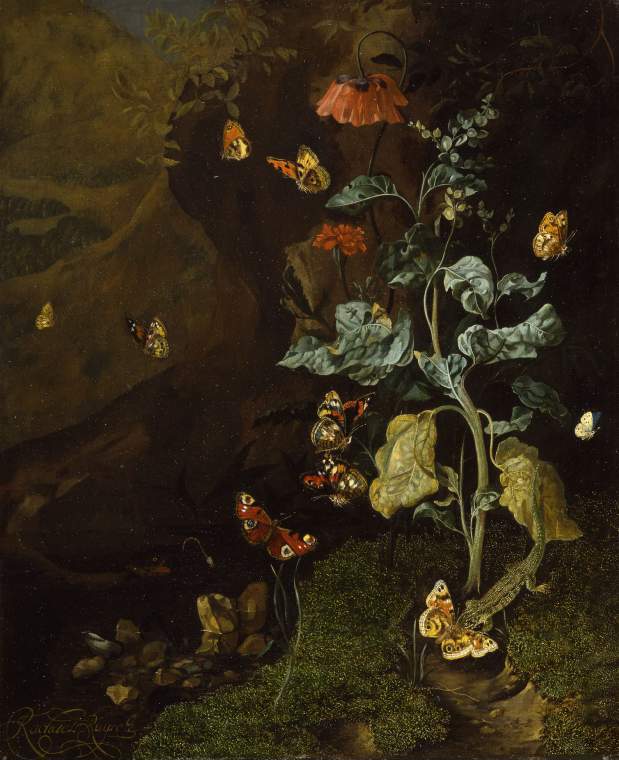
Courtesy: By Rachel Ruysch – http://www.fitzmuseum.cam.ac.uk/, Public Domain, https://commons.wikimedia.org/w/index.php?curid=38421469
Note about the artist Rachel Ruysch
“Rachel Ruysch (3 June 1664 – 12 October 1750) was a Dutch still-life painter from the Northern Netherlands. Ruysch’s still life paintings reflect her brilliant attention to detail and close observation of nature. She specialized in flowers, inventing her own style and achieving international fame in her lifetime. Ruysh’s father was a professor in anatomy and botany; he was also an amateur painter. He encouraged his daughter’s talents. Ruysch had a long and distinguished career that spanned over six decades. Her work reflected some of the best art from the Dutch Golden Age.”
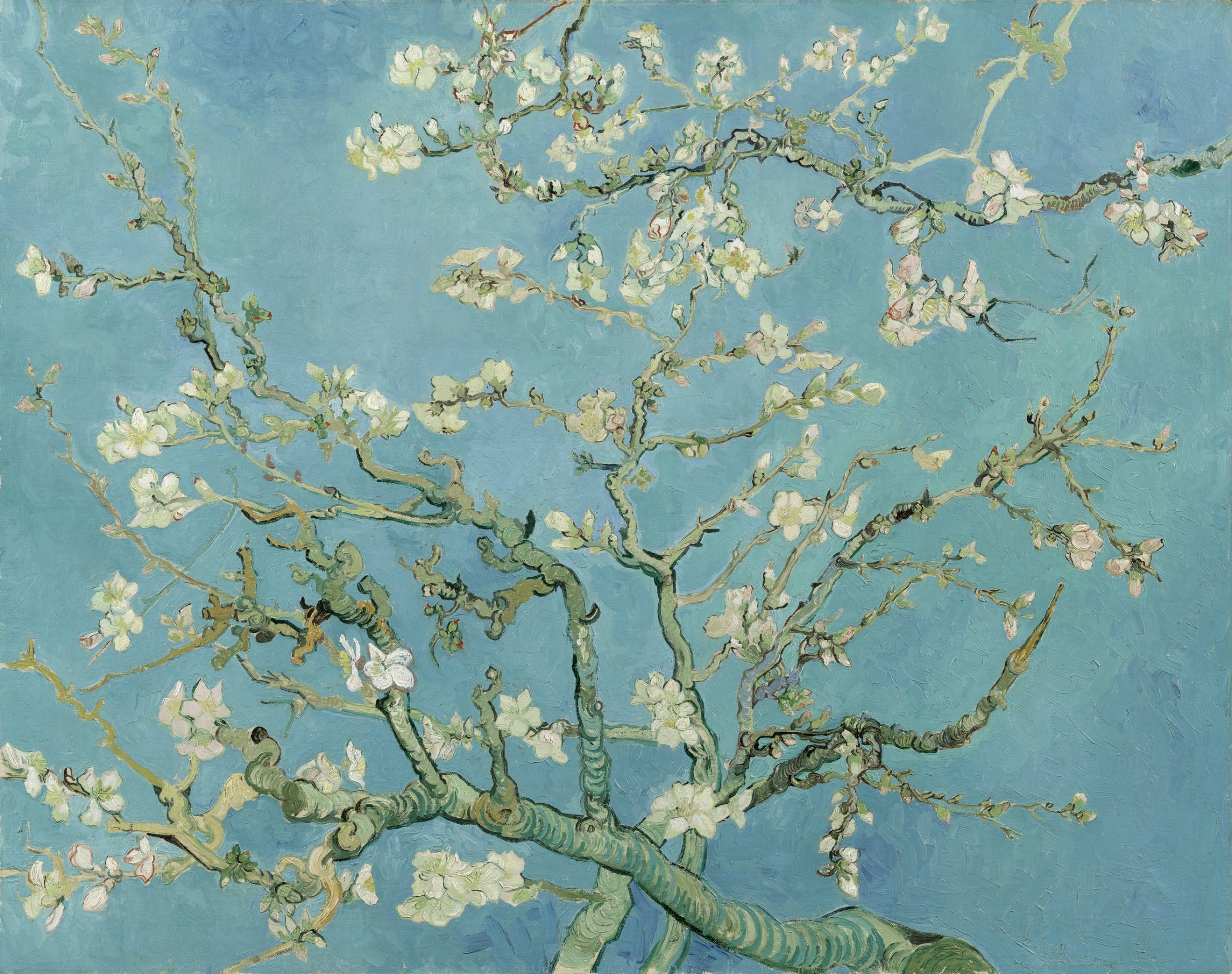
Courtesy: By Vincent van Gogh – dAFXSL9sZ1ulDw at Google Cultural Institute maximum zoom level, Public Domain, https://commons.wikimedia.org/w/index.php?curid=21977493
“Letter from Town: The Almond Tree” by D. H. Lawrence
You promised to send me some violets. Did you forget?
White ones and blue ones from under the orchard hedge?
Sweet dark purple, and white ones mixed for a pledge
Of our early love that hardly has opened yet.
Here there’s an almond tree—you have never seen
Such a one in the north—it flowers on the street, and I stand
Every day by the fence to look up for the flowers that expand
At rest in the blue, and wonder at what they mean.
Under the almond tree, the happy lands
Provence, Japan, and Italy repose,
And passing feet are chatter and clapping of those
Who play around us, country girls clapping their hands.
You, my love, the foremost, in a flowered gown,
All your unbearable tenderness, you with the laughter
Startled upon your eyes now so wide with hereafter,
You with loose hands of abandonment hanging down.
J.P. Getty Art Museum Notes on Vincent Van Gogh’s Irises
“In May 1889, after episodes of self-mutilation and hospitalization, Vincent van Gogh chose to enter an asylum in Saint-Rémy, France. There, in the last year before his death, he created almost 130 paintings. Within the first week, he began Irises, working from nature in the asylum’s garden. The cropped composition, divided into broad areas of vivid color with monumental irises overflowing its borders, was probably influenced by the decorative patterning of Japanese woodblock prints.
There are no known drawings for this painting; Van Gogh himself considered it a study. His brother Theo quickly recognized its quality and submitted it to the Salon des Indépendants in September 1889, writing Vincent of the exhibition: “[It] strikes the eye from afar. It is a beautiful study full of air and life.”
Each one of Van Gogh’s irises is unique. He carefully studied their movements and shapes to create a variety of curved silhouettes bounded by wavy, twisting, and curling lines. The painting’s first owner, French art critic Octave Mirbeau, one of Van Gogh’s earliest supporters, wrote: “How well he has understood the exquisite nature of flowers!” (J.P. Getty Museum of Art, Los Angeles, California)
Gardens of Contemplation and Imagination
In Andrew Marvell’s 1681 poem “The Garden,” a contrast is made between the quiet of contemplation and inner peace and the active world of work, ambition, and worldly acquisition. How important is contemplation, inner peace, and reflection today? Through the garden imagery, Marvell is analyzing different emotional and cognitive states. In 2023, Marvell’s message takes on a new meaning. Following the poem are different artistic representations of gardens, landscape scenes, and related nature images. How connected are you to nature? Do you have a garden? Do you grow flowers, vegetables, and herbs? How disconnected, in your view, are people to nature? What are the benefits of nature? As educators, how can we encourage an awareness of the interconnectedness of ecosystems locally and globally? How can we make both a self-directed and collaborative effort to reverse planetary devastation and restore natural landscapes, water, natural wildlife, flowers, and fauna? What steps have been taken and what more steps need to be taken to activate personal and social change? Will the “grandeur of nature” become a distant memory and a “quaint artifact” of the past? In Last child in the woods, Richard Louv writes:
Within the space of a few decades, the way children understand and experience nature has changed radically. The polarity of the relationship has been reversed. Today, kids are aware of the global threats to the environment—but their physical contact, their intimacy with nature, fading. That’s exactly the opposite of how it was when I was a child.
As a boy, I was unaware that my woods were ecologically connected with any other forests. Nobody in the 1950s talked about acid rain or holes in the ozone layer or global warming. But I knew my woods and my fields; I knew every bend in the creek and dip in the beaten dirt paths. I wandered those woods even in my dreams. A kid today can likely tell you about the Amazon rain forest—-but not about the last time he or she explored the woods in solitude, or lay in a field listening to the wind and watching the clouds move….(Louv, pp.1-2, 2005).
Indigenous knowledge keeper, war veteran, and Grandfather/Elder Wanbdi Wakita’s words of warning are a plea for greater ecological awareness and empathy for all living things:
Yesterday I made ceremony for the lightening, the thunder, the rain, the wind. I offered them food. I offered them water. I offered them tobacco. So I don’t know if you know this or not, we’re in deep trouble with this land. This planet Deep trouble. I used to say 30 years from now, but I see it’s moving very fast that all people are going to suffer. We’re not listening, that’s why. We’re not listening to Creator. We’re not listening to our ancestors. We’re not listening to Mother Earth. We’re not listening to Grandmother Earth. -Wandbi Wakita, August, 5, 2022.
Retrieved August 10th, Winnipeg Free Press. Arts & Life, Section C, p.1.
Reflections
As you read the following poems and prose and view the art images, jot down your thoughts and feelings that may arise. Which texts do you find more compelling? Why? Are there other texts that come to your mind as you read and view the following?
“The Garden” by Andrew Marvell
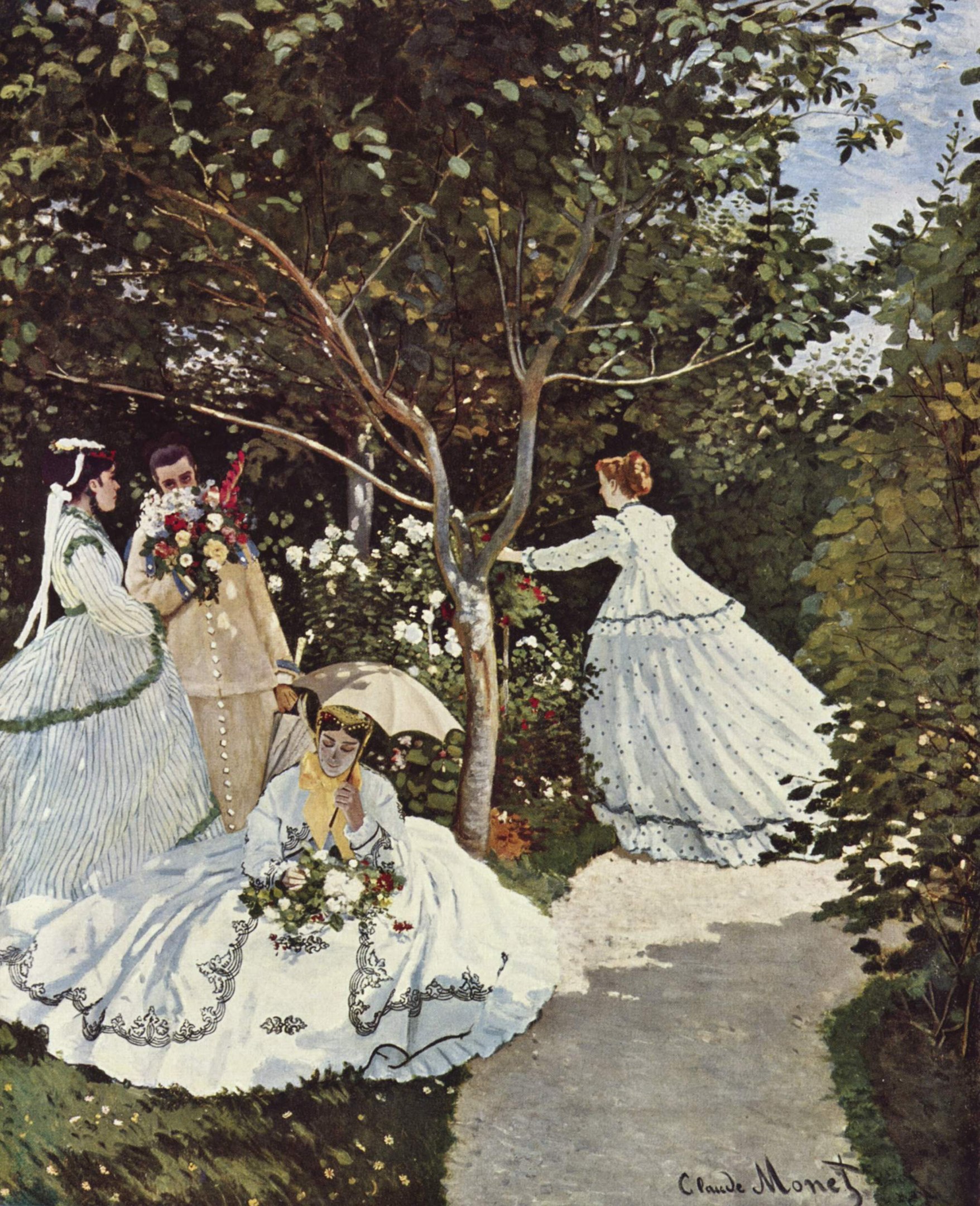
Courtesy: By Claude Monet – The Yorck Project (2002) 10.000 Meisterwerke der Malerei (DVD-ROM), distributed by DIRECTMEDIA Publishing GmbH. ISBN: 3936122202., Public Domain, https://commons.wikimedia.org/w/index.php?curid=155852
“An October Garden” by Christina Rossetti
In my Autumn garden I was fain
To mourn among my scattered roses;
Alas for that last rosebud which uncloses
To Autumn’s languid sun and rain
When all the world is on the wane!
Which has not felt the sweet constraint of June,
Nor heard the nightingale in tune.
Broad-faced asters by my garden walk,
You are but coarse compared with roses:
More choice, more dear that rosebud which uncloses,
Faint-scented, pinched, upon its stalk,
That least and last which cold winds balk;
A rose it is though least and last of all,
A rose to me though at the fall.
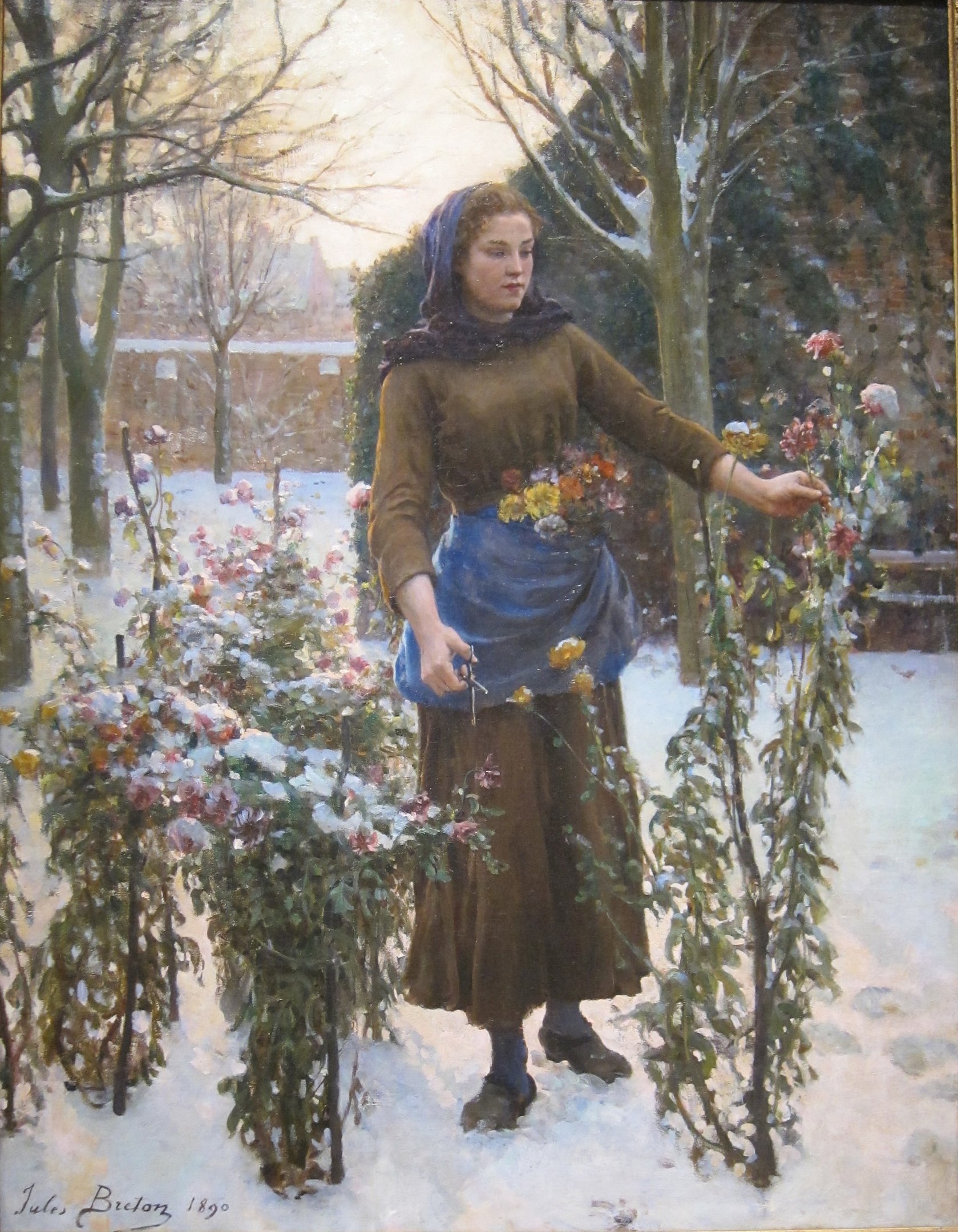
Courtesy: By Jules Breton – Own work, Public Domain, https://commons.wikimedia.org/w/index.php?curid=21545542
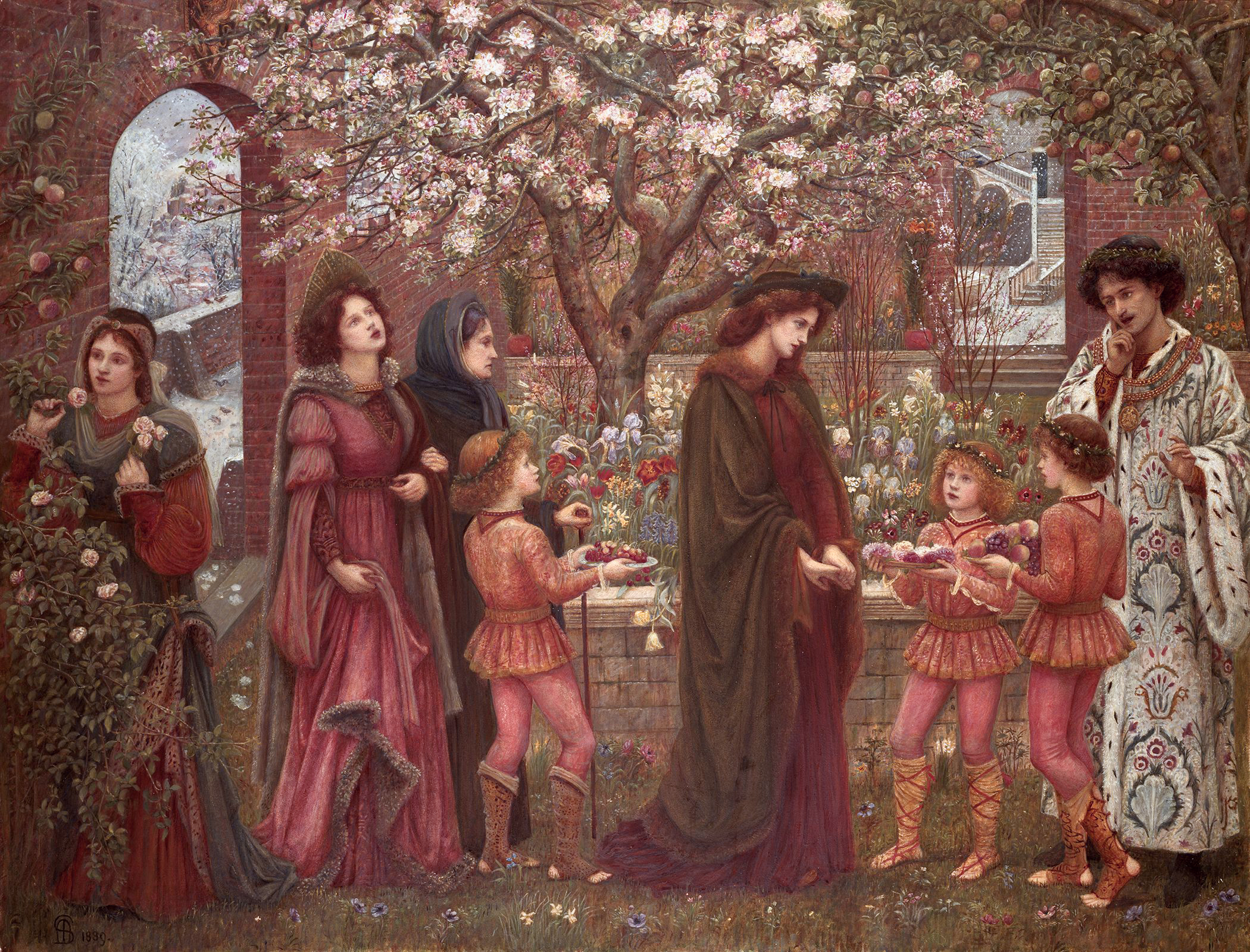
Courtesy: By Marie Spartali Stillman – Pre‑Raphaelite Inc., by courtesy of Julian Hartnoll, Public Domain, https://commons.wikimedia.org/w/index.php?curid=50983208
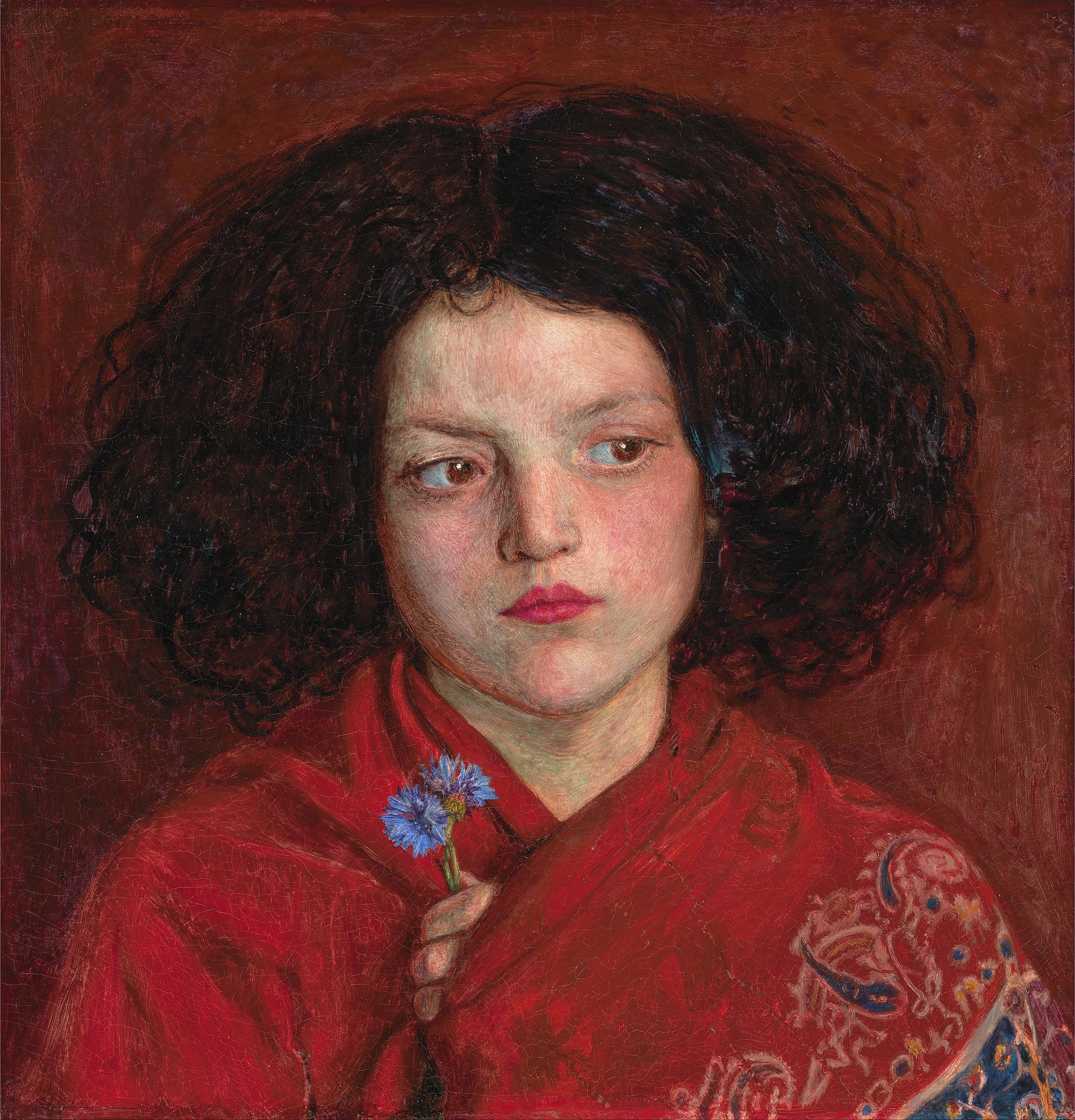
Courtesy: Yale Center for British Art, Paul Mellon Fund. “https://collections.britishart.yale.edu/catalog/tms:5062” is licensed under CC0 1.0.
“Flower” by Rabindranath Tagore
Pluck this little flower and take it, delay not! I fear lest it
droop and drop into the dust.
I may not find a place in thy garland, but honour it with a touch of
pain from thy hand and pluck it. I fear lest the day end before I am
aware, and the time of offering go by.
Though its colour be not deep and its smell be faint, use this flower
in thy service and pluck it while there is time..
“An April Morning” by Bliss Carman
ONCE more in misted April
The world is growing green.
Along the winding river
The plumey willows lean.
Beyond the sweeping meadows
The looming mountains rise,
Like battlements of dreamland
Against the brooding skies.
In every wooded valley
The buds are breaking through,
As though the heart of all things
No languor ever knew.
The golden-wings and bluebirds
Call to their heavenly choirs.
The pines are blued and drifted
With smoke of brushwood fires.
And in my sister’s garden
Where little breezes run,
The golden daffodillies
Are blowing in the sun.
Symbolism and Meaning of Flowers
You can explore the rich symbolism of flowers throughout the ages. What are your favourite flowers? What does each flower represent to you?
The Lotus Flower:
In Buddhist mythology, the lotus flower symbolizes purity, inner strength, and enlightenment in a world of despair and tumult. Despite growing out of heavy mud, it arises beautiful and clean. The petals of the lotus symbolize the Buddha’s teachings and the multi-layered meaning of these teachings (Xueting C. Ni, Chinese myths, pp. 101-102 Amber Books).
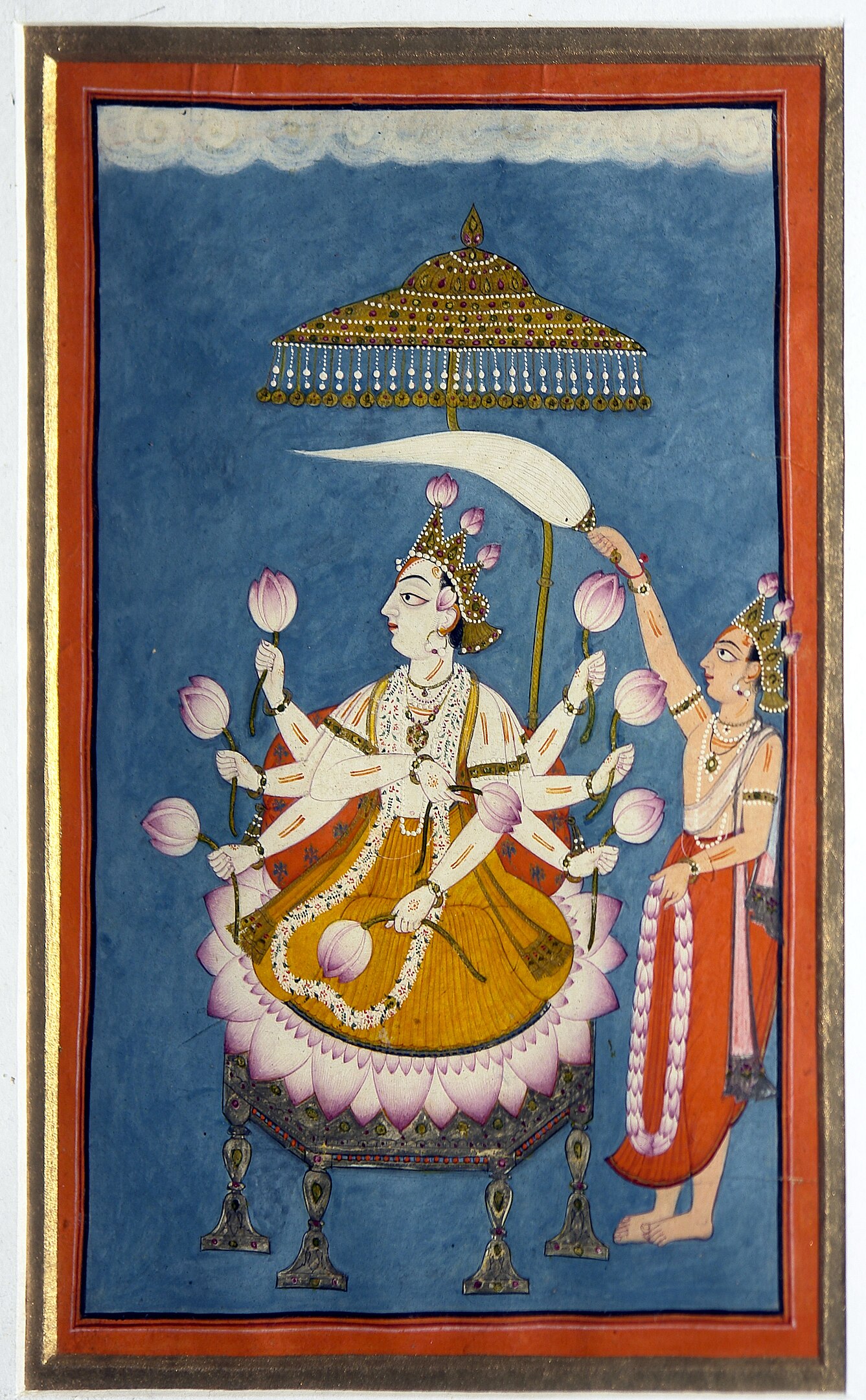
Courtesy: By Yann (talk) – Own work, Public Domain, https://commons.wikimedia.org/w/index.php?curid=15653652
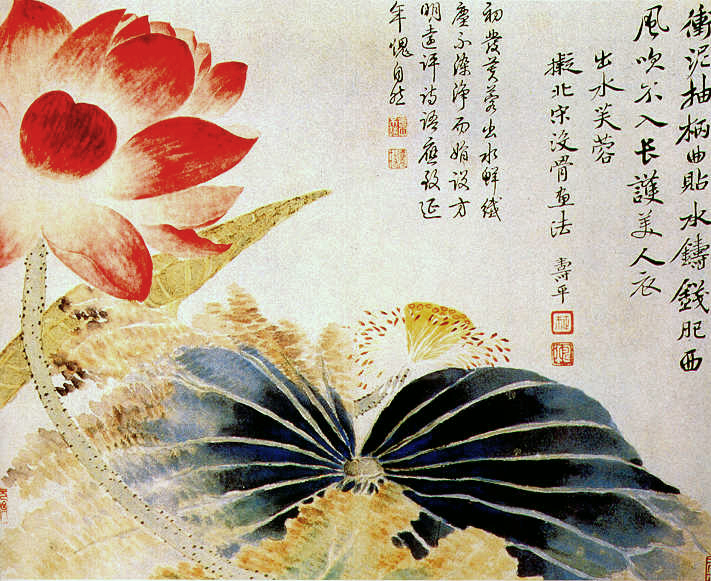
Courtesy: By Yun Shouping – http://www.yasue.cc/a26.jpg, Public Domain, https://commons.wikimedia.org/w/index.php?curid=4125685
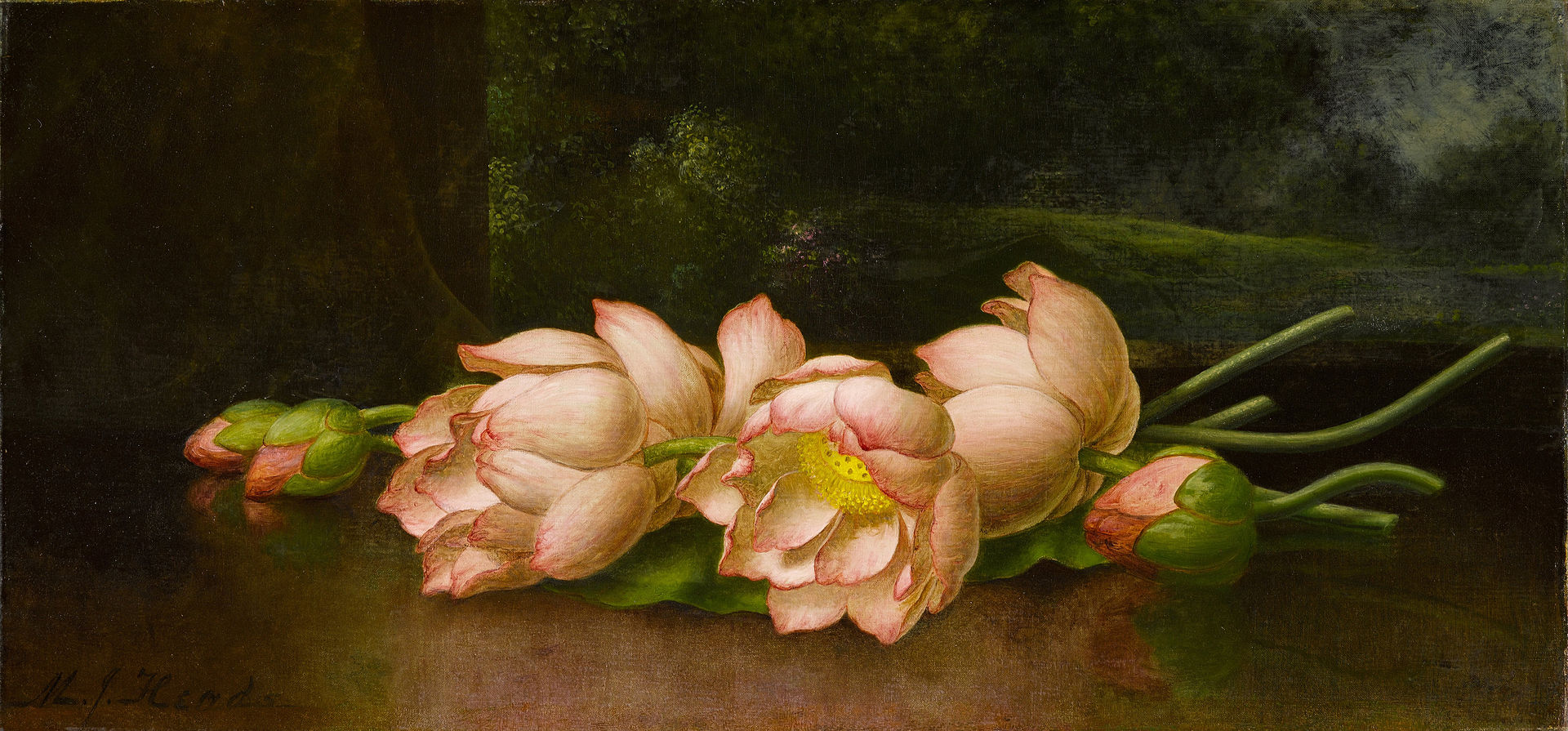
Courtesy: By Martin Johnson Heade – Google Art Project, Public Domain, https://commons.wikimedia.org/w/index.php?curid=41102013
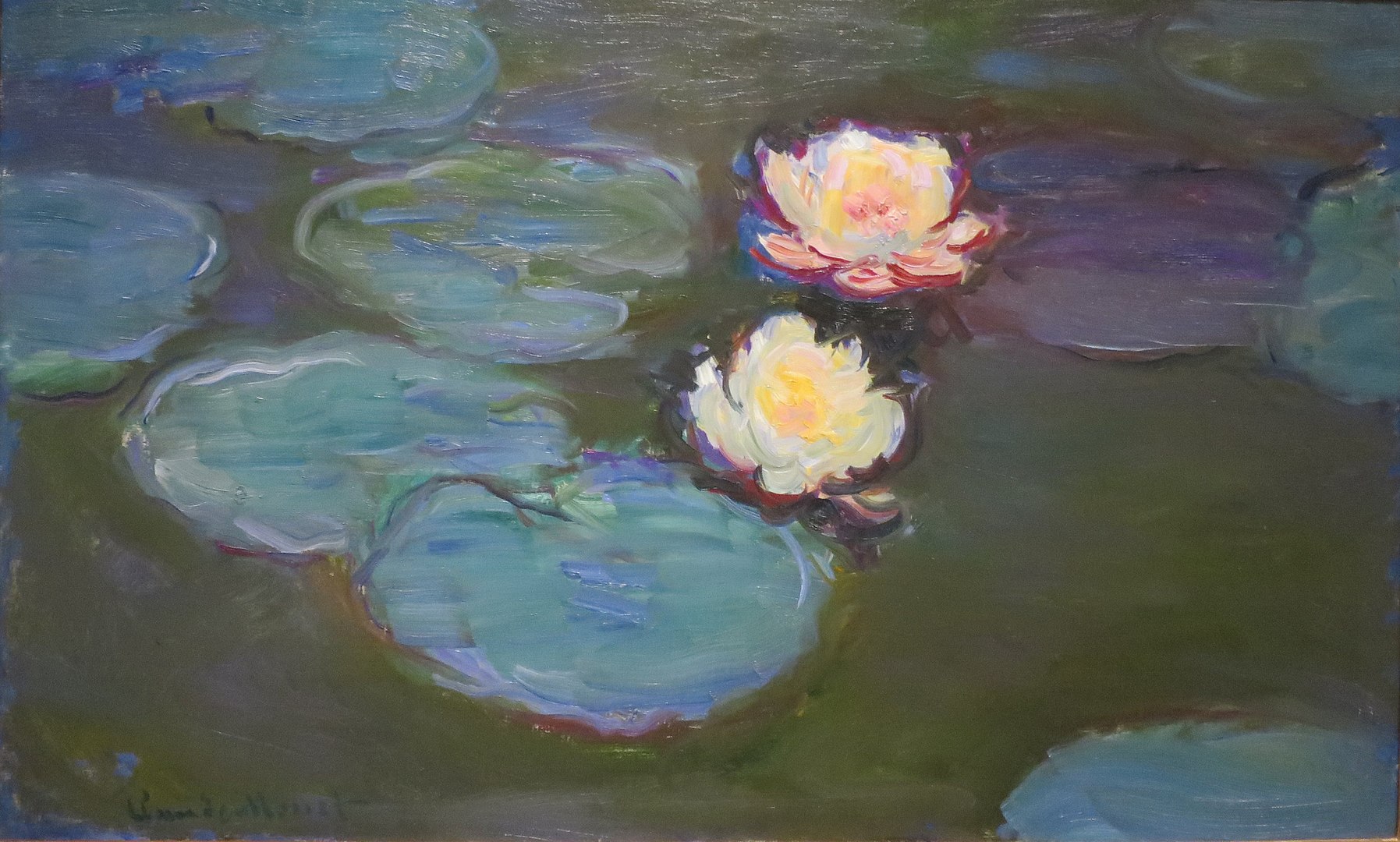
Courtesy: By Claude Monet – Own work, Public Domain, https://commons.wikimedia.org/w/index.php?curid=8894888
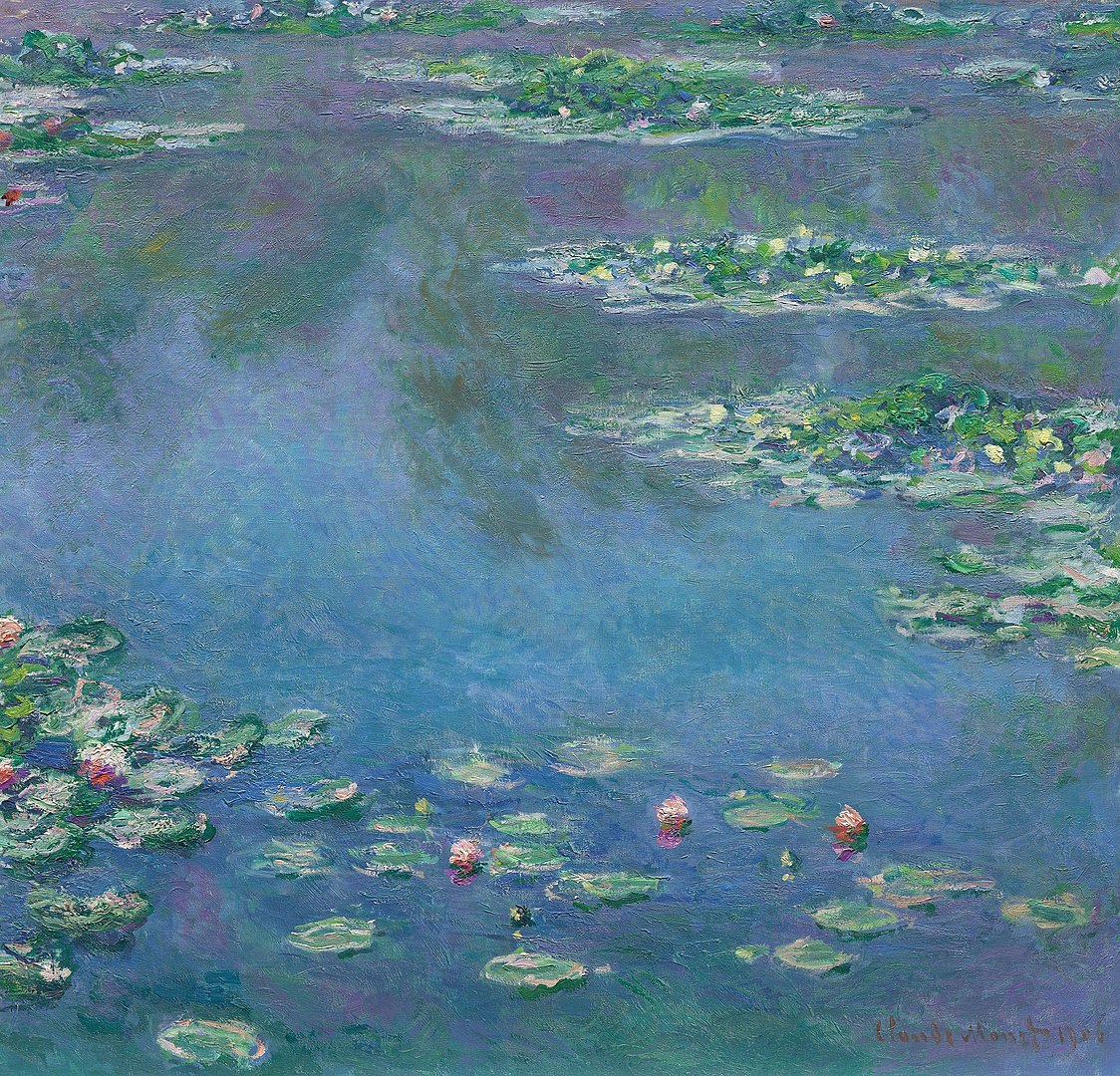
Courtesy: Mr. and Mrs. Martin A. Ryerson Collection. “https://www.artic.edu/artworks/16568/water-lilies” is licensed under CC0 1.0.
Chicago Art Institute Note about Claude Monet’s Water Lilies
“One instant, one aspect of nature contains it all,” said Claude Monet, referring to his late masterpieces, the water landscapes that he produced at his home in Giverny between 1897 and his death in 1926. These works replaced the varied contemporary subjects he had painted from the 1870s through the 1890s with a single, timeless motif—water lilies. The focal point of these paintings was the artist’s beloved flower garden, which featured a water garden and a smaller pond spanned by a Japanese footbridge. In his first water-lily series (1897–99), Monet painted the pond environment, with its plants, bridge, and trees neatly divided by a fixed horizon. Over time, the artist became less and less concerned with conventional pictorial space. By the time he painted Water Lilies, which comes from his third group of these works, he had dispensed with the horizon line altogether. In this spatially ambiguous canvas, the artist looked down, focusing solely on the surface of the pond, with its cluster of vegetation floating amid the reflection of sky and trees. Monet thus created the image of a horizontal surface on a vertical one.”
Further Note: The Real Water Lilies of Giverny. Groom, G. (2023).
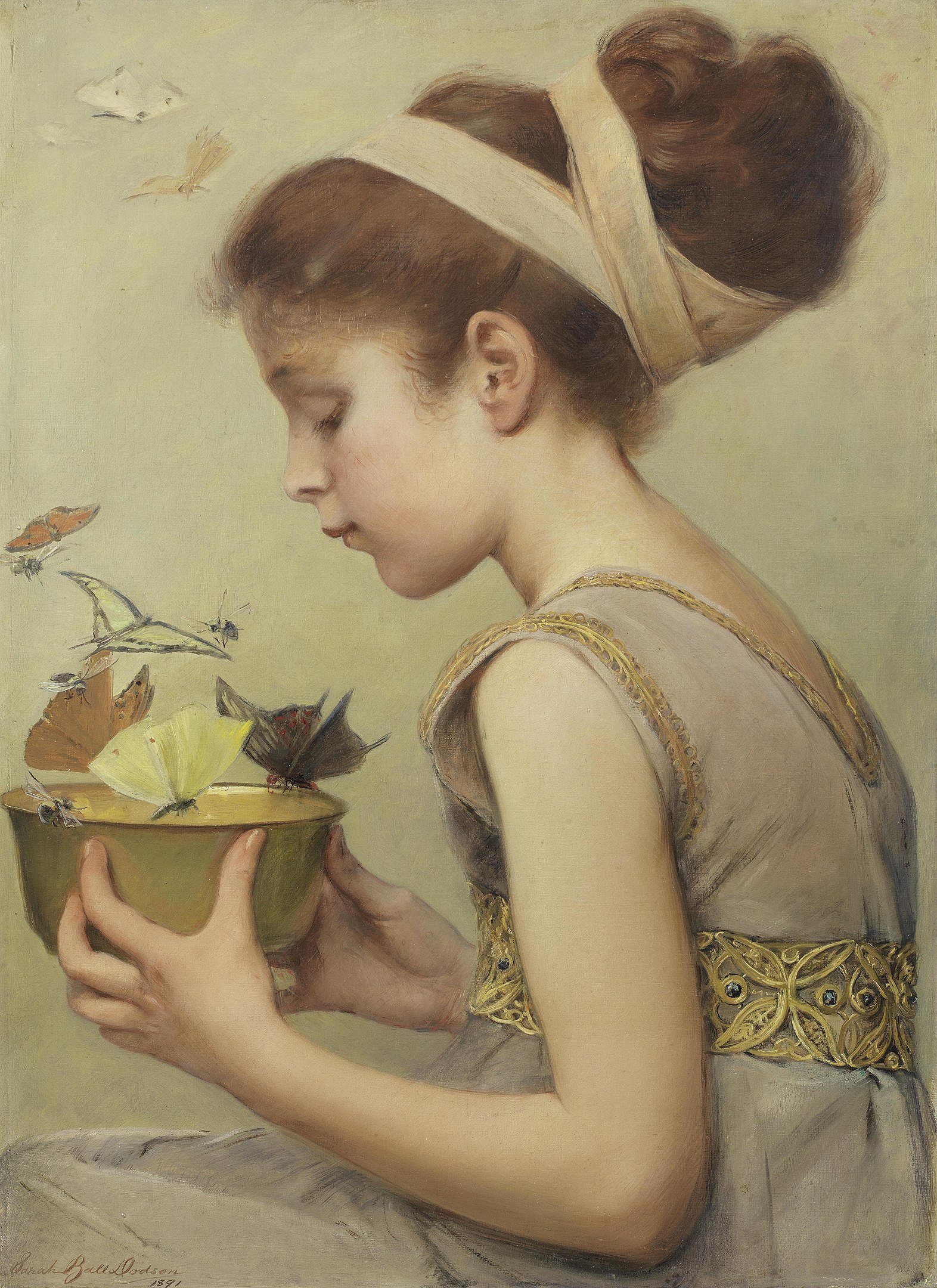
“To A Butterfly” by William Wordsworth
I’ve watched you now a full half hour
Self-poised upon that yellow flower;
And, little Butterfly! indeed
I know not if you sleep or feed.
How motionless!-not frozen seas
More motionless!-and then
What joy awaits you, when the breeze
Hath found you out among the trees,
And calls you forth again!
This plot of orchard-ground is ours;
My trees they are, my Sister’s flowers:
Here rest your wings when they are weary,
Here lodge as in a sanctuary!
Come often to us, fear no wrong;
Sit near us on the bough!
We’ll talk of sunshine and of song,
And summer days, when we were young;
Sweet childish days, that were as long
As twenty days are now.
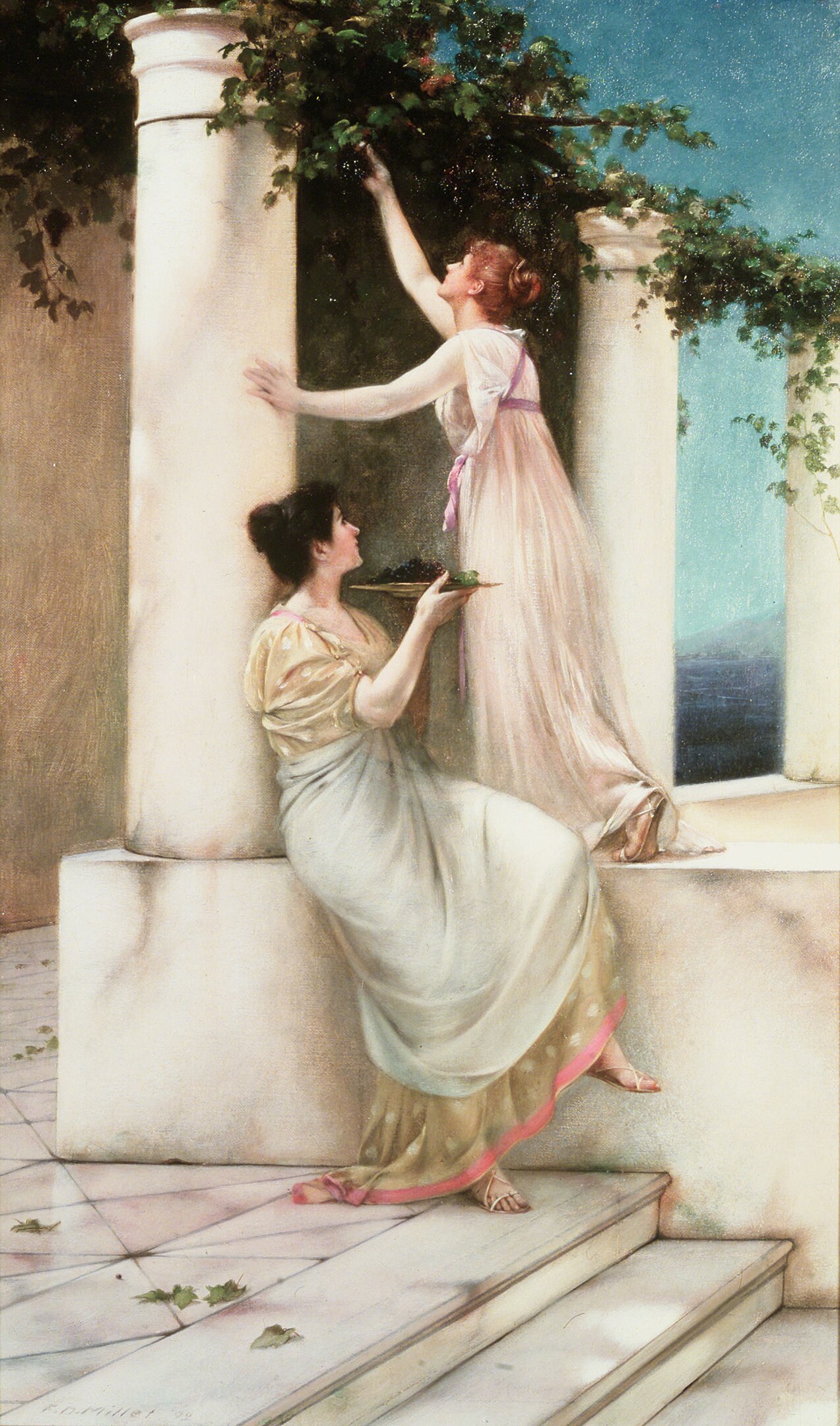
Courtesy: By Francis Davis Millet – Brooklyn Museum, Public Domain, https://commons.wikimedia.org/w/index.php?curid=3863053
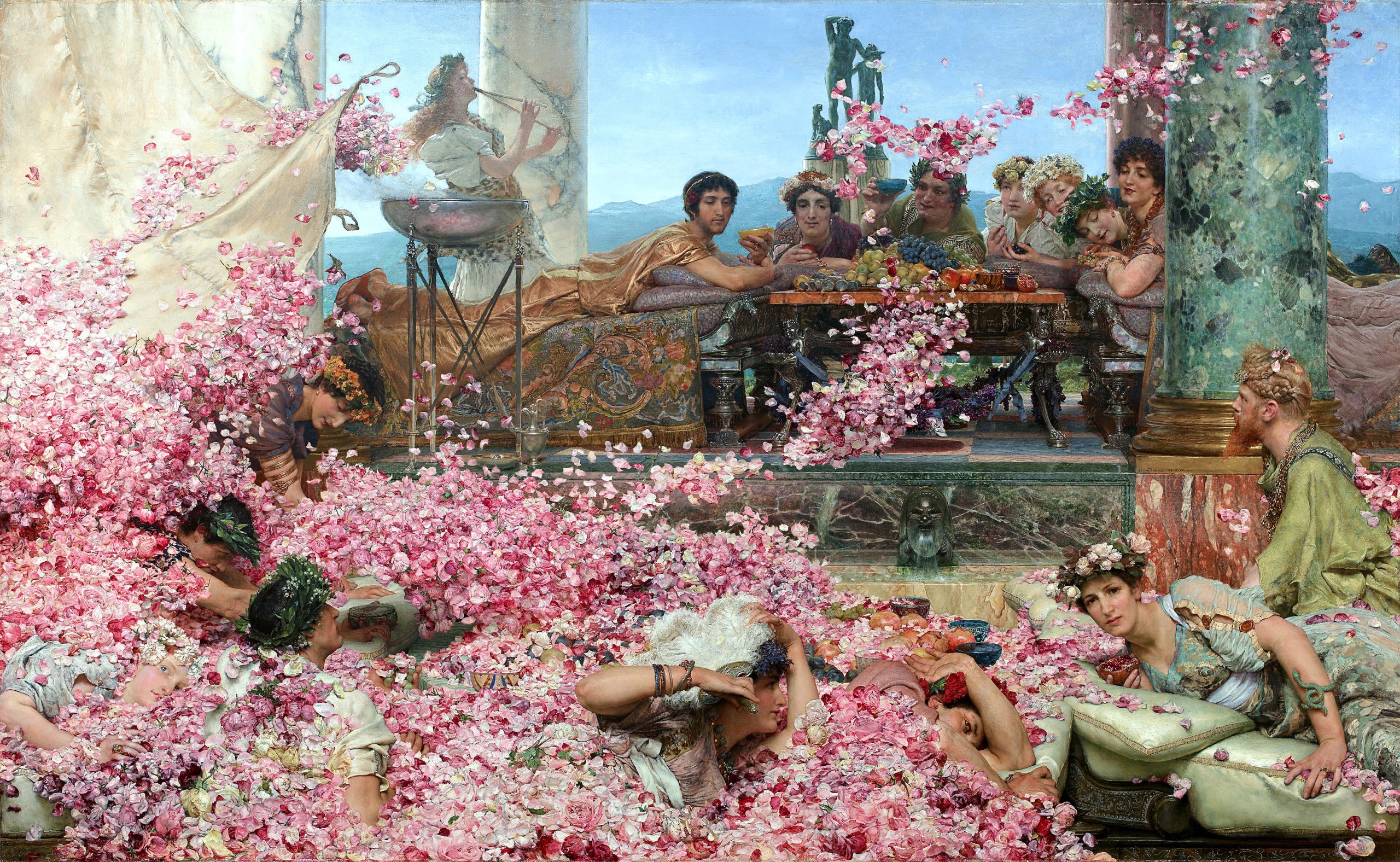
Courtesy: By Lawrence Alma-Tadema – Superb magazine, The Désirs & Volupté exhibition at the Musée Jacquemart-André – direct link, Public Domain, https://commons.wikimedia.org/w/index.php?curid=755081
WikiArt Note About Lawrence Alma-Tadema’s The Roses of Heliogabalus
“The Roses of Heliogabalus” is one of Alma-Tadema’s most famous paintings. The painting depicts the pathological Roman Emperor Egabalus (Heliogabalus) who attempts to smother his unsuspecting guests with an avalanche of rose petals. Lawrence Alma-Tadema’s attention to detail is evident in the skillful way the rose petals are presented. Alma-Tadema ordered fresh shipments of rose petals from the French Riviera and parts of Europe and North Africa as part of his effort to ensure a realistic depiction of the roses.
C.A. Smith’s poem is an interesting counterpart to Alma-Tadema’s painting as it focusses more on the personality of the emperor, who is seen as something of a decadent aesthete. An exhaustive search has not turned up an individual called ‘Christophe des Lauriëres’, and is assumed by this author to be Clark Ashton Smith writing pseudonymously.
“Heliogabalus” by Clark Ashton Smith (Translated from Christope des Laurieres)
He, the supreme idealist of Sin,
Through scarlet days a white perfection sought
To make of lyric deed and lyric thought
One music of perverse accord, wherein
The songless blatancy and banal din
Of all the world should perish: he had wrought
From Vice a pure, Pentelic Venus, fraught
With lines of light and terror, that should win
The plaudits of the stars. . . . But prevalent
For him, above the achievable desire,
And Life perfectible by Sin and Art,
Such lusts as leave the Titans impotent
Allured, and Life and Sin, in worlds apart,
Were fair with suns of quintessential fire.
A Note About the poet Clark Ashton Smith
“Clark Ashton Smith (January 13, 1893-August 14, 1961) was a poet, sculptor, painter and author of fantasy, horror and science fiction short stories. It is for these stories, and his literary friendship with H. P. Lovecraft from 1922 until Lovecraft’s death in 1937, that he is mainly remembered today. With Lovecraft and Robert E. Howard, also a friend and correspondent, Smith remains one of the most famous contributors to the pulp magazine Weird Tales.”
“The Rose of the World” by W. B. Yeats
Who dreamed that beauty passes like a dream?
For these red lips, with all their mournful pride,
Mournful that no new wonder may betide,
Troy passed away in one high funeral gleam,
And Usna’s children died.
We and the labouring world are passing by:
Amid men’s souls, that waver and give place
Like the pale waters in their wintry race,
Under the passing stars, foam of the sky,
Lives on this lonely face.
Bow down, archangels, in your dim abode:
Before you were, or any hearts to beat,
Weary and kind one lingered by His seat;
He made the world to be a grassy road
Before her wandering feet.
To read more poetry by W.B. Yeats please open the link here.
Imaginative Flower Illustrations by Walter Crane
A Floral Fantasy in an Old English Garden, set forth in verses & coloured designs, by Walter Crane;1899; Harper, London.
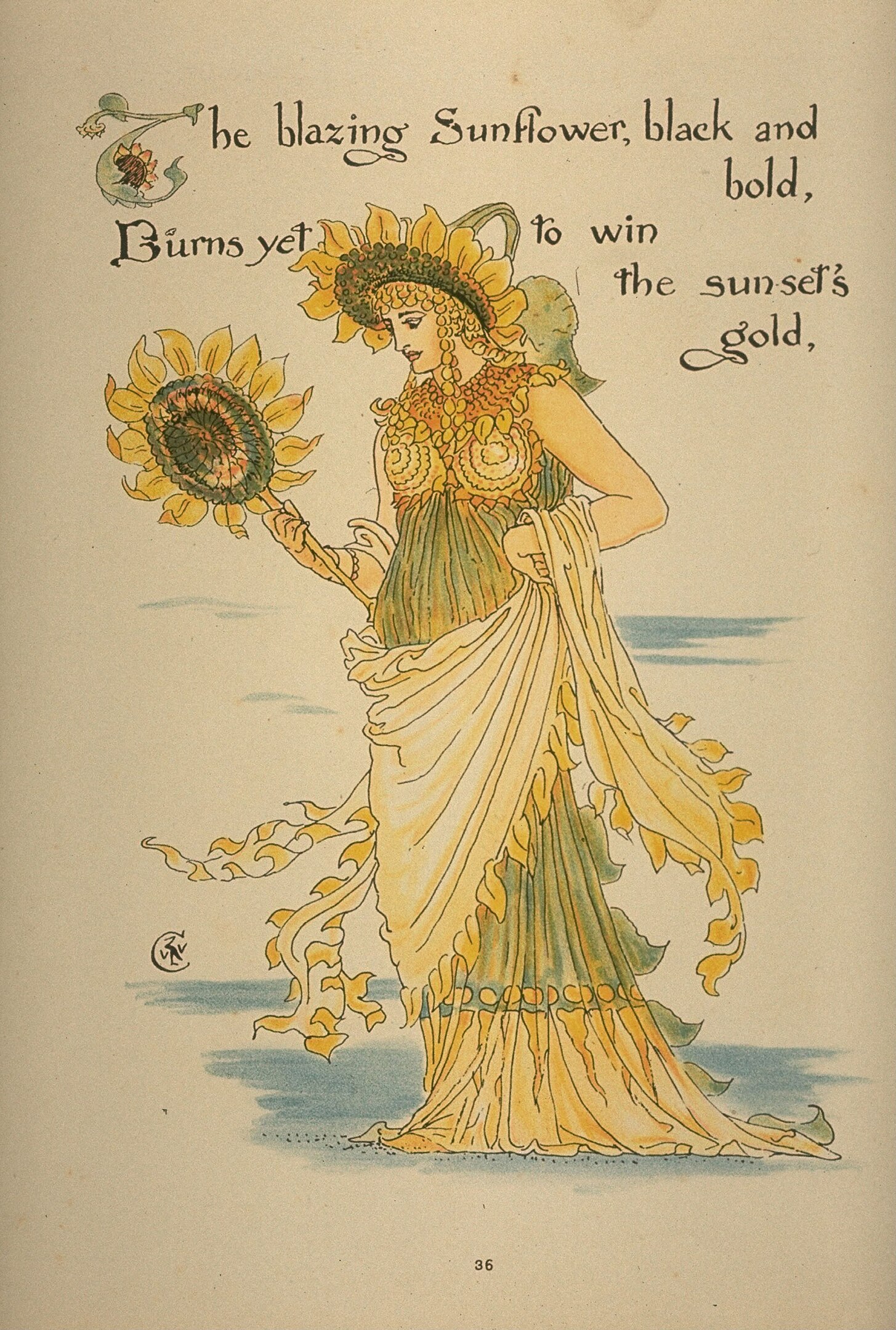
Courtesy: By Walter Crane – flora-s-feast/7gH29xhpAIbqVg — Google Arts & Culture, Public Domain, https://commons.wikimedia.org/w/index.php?curid=117225235
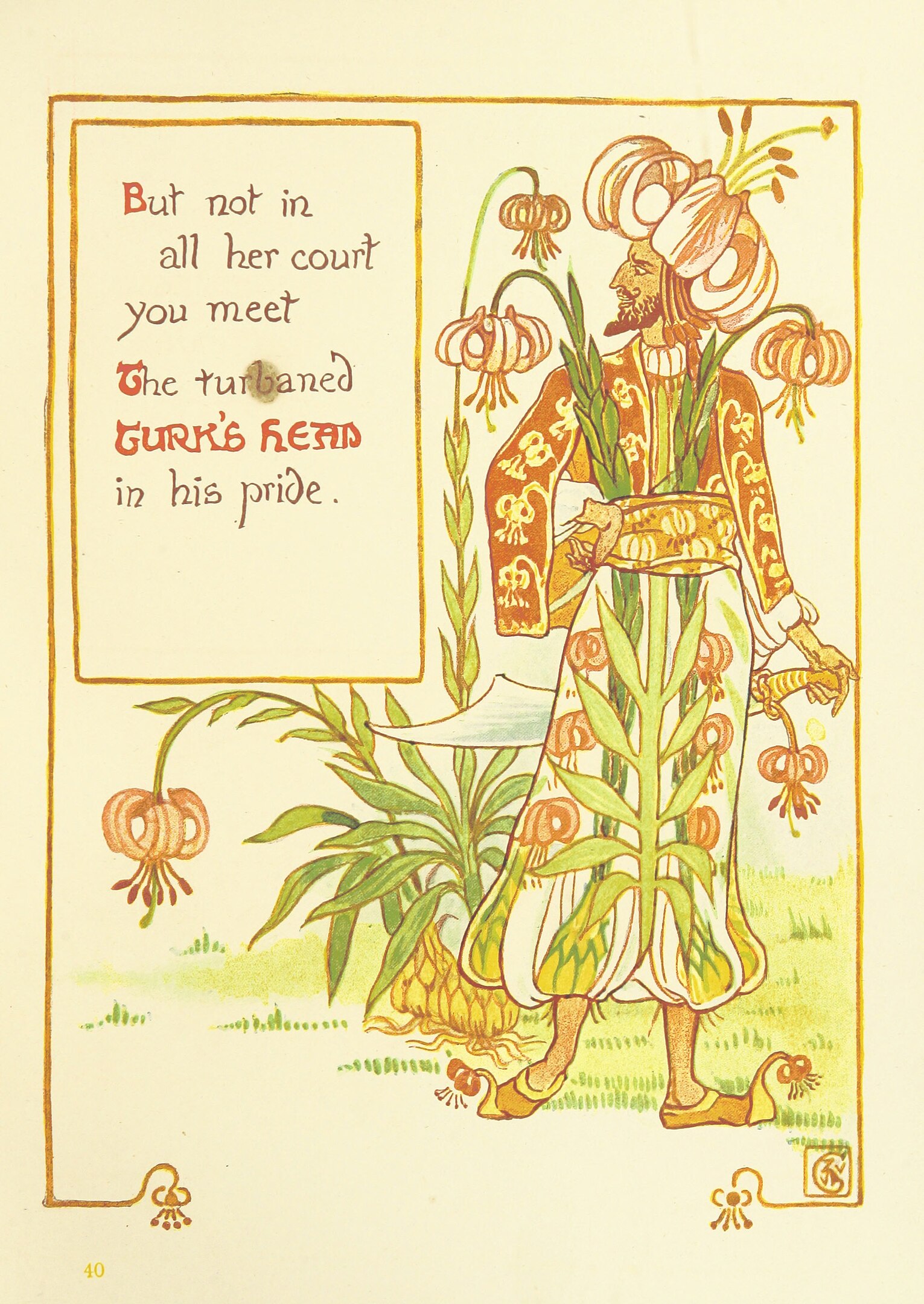
Courtesy: “British Library digitised image from page 83 of “A Floral Fantasy in an Old English Garden. Set forth in verses & coloured designs”” by British Library has No known copyright restrictions.
“Walter Crane (15 August 1845 – 14 March 1915) was an English artist and book illustrator. He is considered to be the most influential, and among the most prolific, children’s book creators of his generation[1] and, along with Randolph Caldecott and Kate Greenaway, one of the strongest contributors to the child’s nursery motif that the genre of English children’s illustrated literature would exhibit in its developmental stages in the later 19th century.
Crane’s work featured some of the more colourful and detailed beginnings of the child-in-the-garden motifs that would characterize many nursery rhymes and children’s stories for decades to come. He was part of the Arts and Crafts movement and produced an array of paintings, illustrations, children’s books, ceramic tiles, wallpapers and other decorative arts. Crane is also remembered for his creation of a number of iconic images associated with the international Socialist movement.”
- Additional Resource: Spencer, I. (1975) Walter Crane. MacMillan Publishing. Co, Inc.
- Walter Crane’s Painting Book (1889)
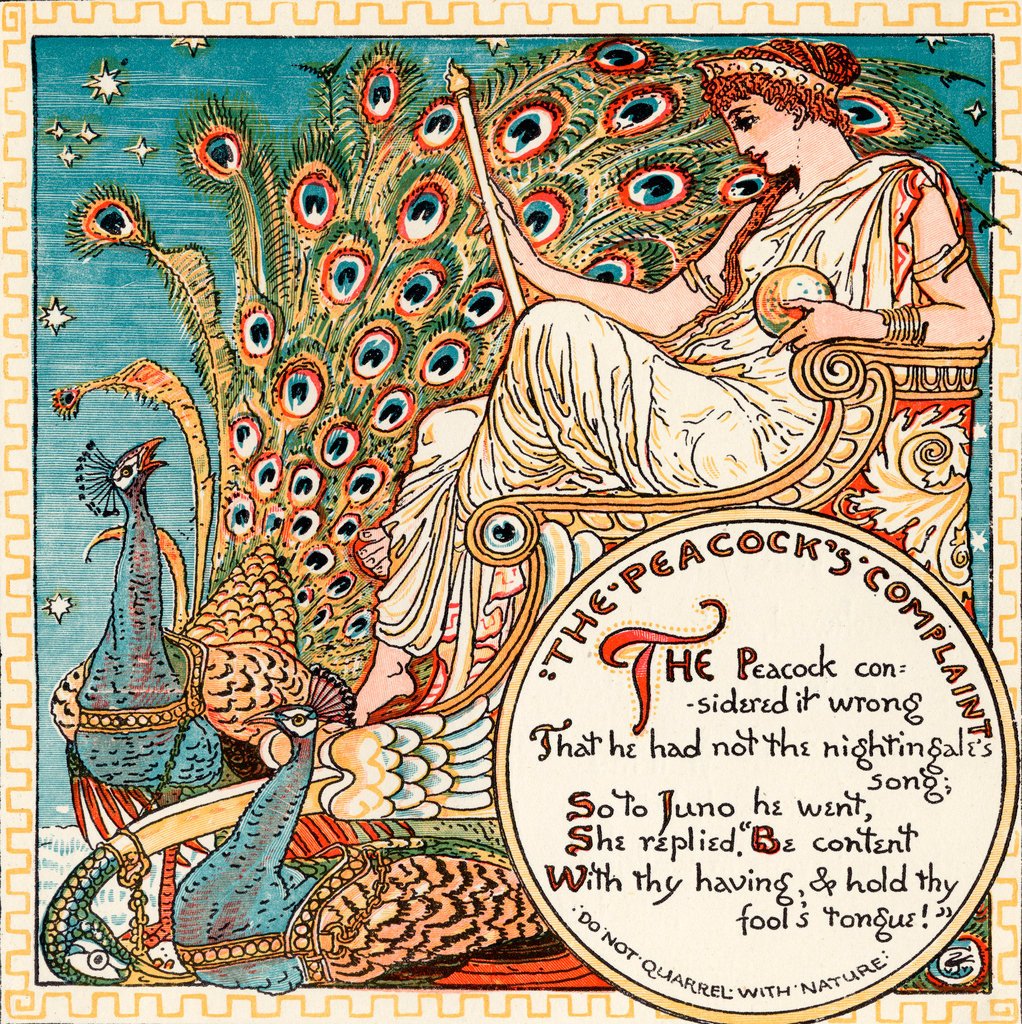
Courtesy: By Walter Crane – Bridgeman Art Library: Object 308687, Public Domain, https://commons.wikimedia.org/w/index.php?curid=65343326
“I Wandered Lonely as a Cloud” by William Wordsworth
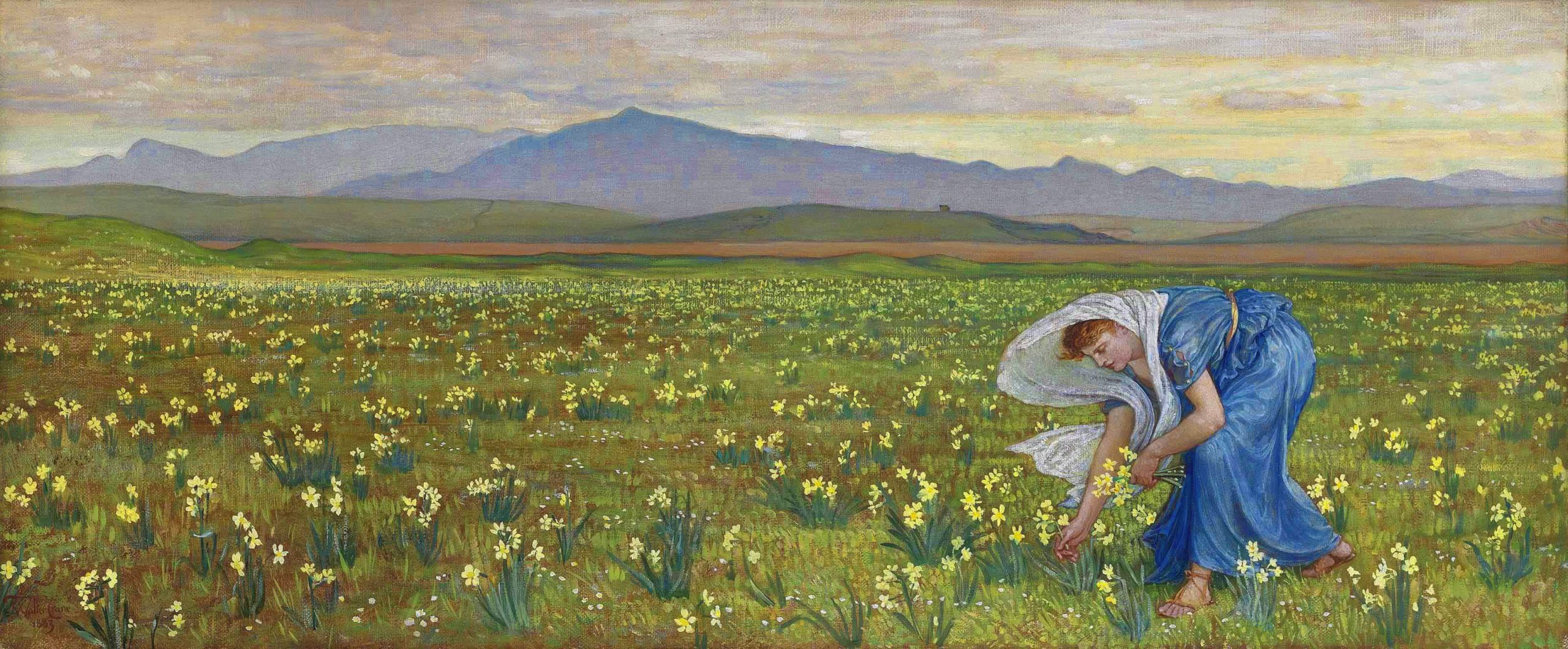
Courtesy: By Walter Crane – This file was derived from: Walter T. Crane – La Primavera (1883).jpg:, Public Domain, https://commons.wikimedia.org/w/index.php?curid=117774434
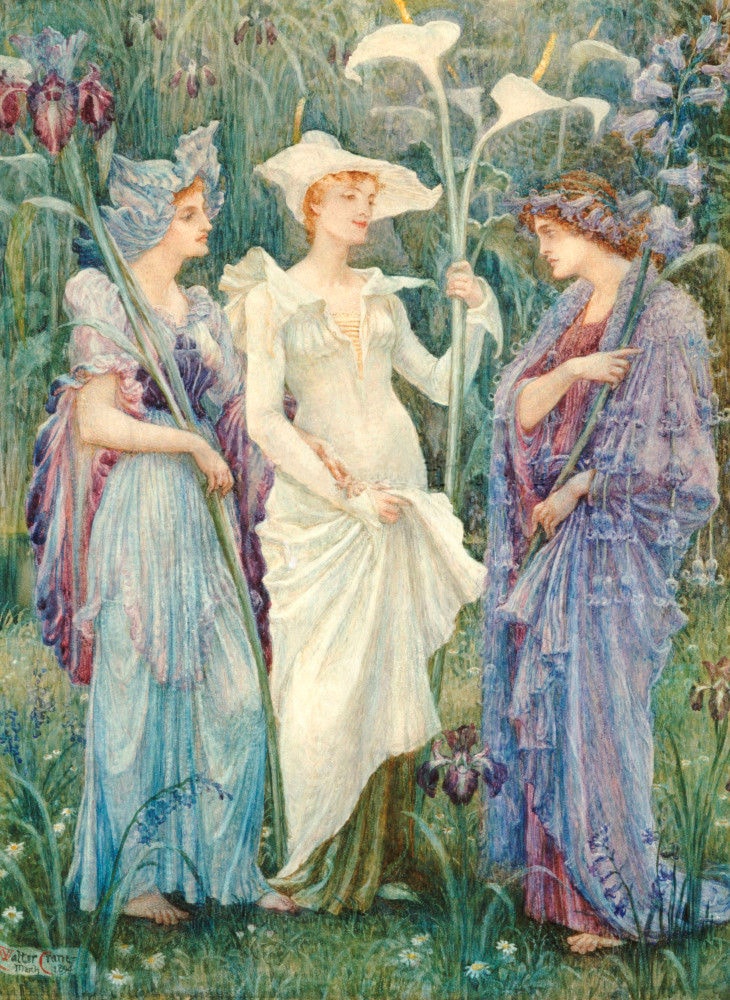
Image courtesy of the Art Renewal Center©, (ARC) https://www.artrenewal.org. https://www.artrenewal.org/artworks/ensigns-of-spring/walter-crane/73270
For the complete illustrations of Walter Crane’s (1894) Floral Fantasies please open the link here.
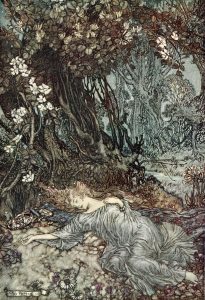
Arthur Rackham, Illustration of Titania from A Midsummer Night’s Dream, 1909. Internet Archive. Public Domain. By Arthur Rackham – Internet Archive, Public Domain, https://commons.wikimedia.org/w/index.php?curid=44057584
From William Shakespeare’s
A Midsummer NIght’s Dream (Oberon, Act 2, scene 1)
I know a bank where the wild thyme blows,
Where oxlips and the nodding violet grows,
Quite overcanopied with luscious woodbine,
With sweet muskroses, and with eglantine.
There sleeps Titania sometime of the night,
Lulled in these flowers with dances and delight.
And there the snake throws her enameled skin,
Weed wide enough to wrap a fairy in.
265 And with the juice of this I’ll streak her eyes
And make her full of hateful fantasies.
Take thou some of it, and seek through this grove.
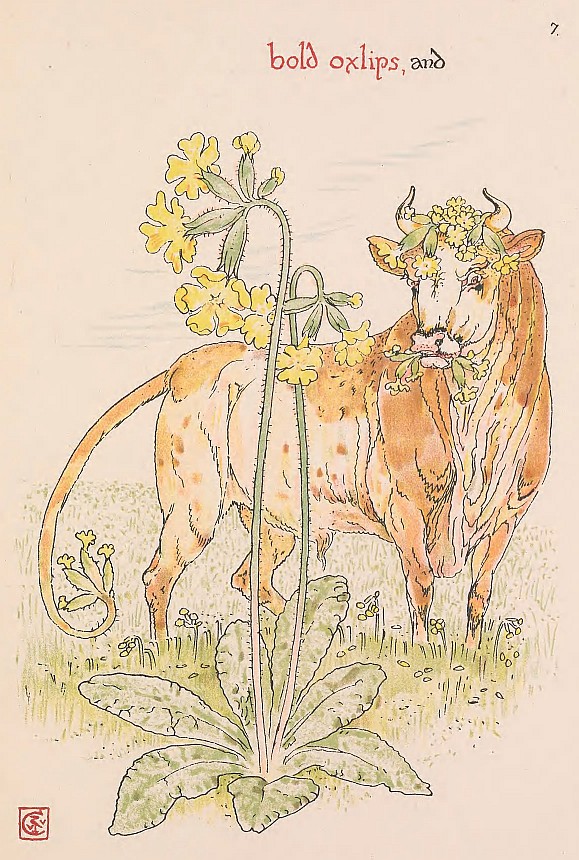
Courtesy: Shakespeare, William. (Dec 22, 2020). Flowers from Shakespeare’s Garden: A Posy from the Plays. Project Gutenberg (Public Domain). Retrieved September 3, 2023, from https://www.gutenberg.org/files/64102/64102-h/64102-h.htm
Produced by: Charlene Taylor, Linda Cantoni and the Online Distributed Proofreading Team at Distributed Proofreaders. (This file was produced from images generously made available by The Internet Archive).
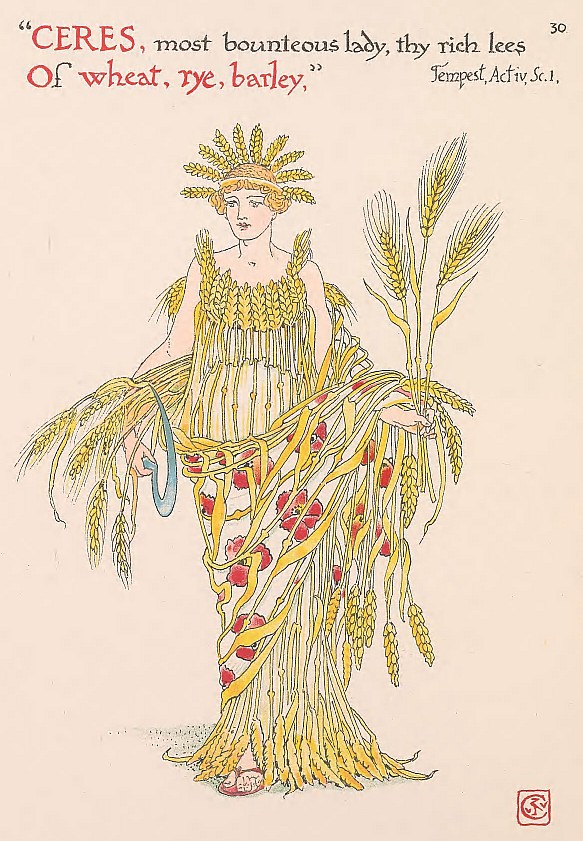
Of wheat, rye, barley” Illustration (P. 30) from “Flowers from Shakespeare’s Garden: A Posy from the Plays” (published 1909 by Cassell and Co: Ltd) by William Shakespeare (1564-1616). Illustrated by Walter Crane. Public Domain.
Courtesy: Shakespeare, William. (Dec 22, 2020). Flowers from Shakespeare’s Garden: A Posy from the Plays. Project Gutenberg (Public Domain). Retrieved September 3, 2023, from https://www.gutenberg.org/files/64102/64102-h/64102-h.htm
Flowers from Shakespeare’s Gardens (Illustrated by Walter Crane). Cassell and Co. 1906. Internet Archive.
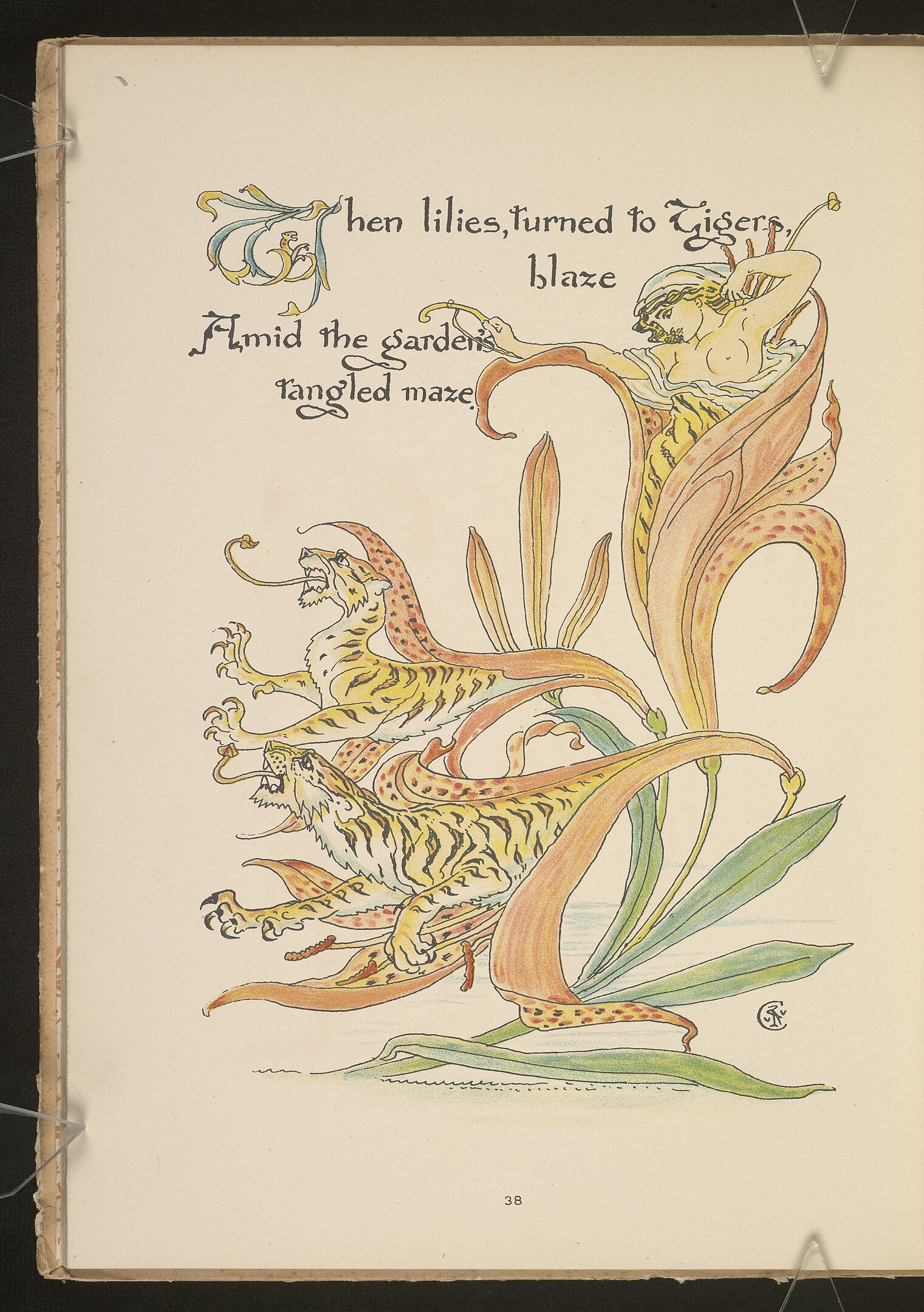
For the complete illustrated version of Walter Crane’s Flora’s Feast please open the links here and here and here.
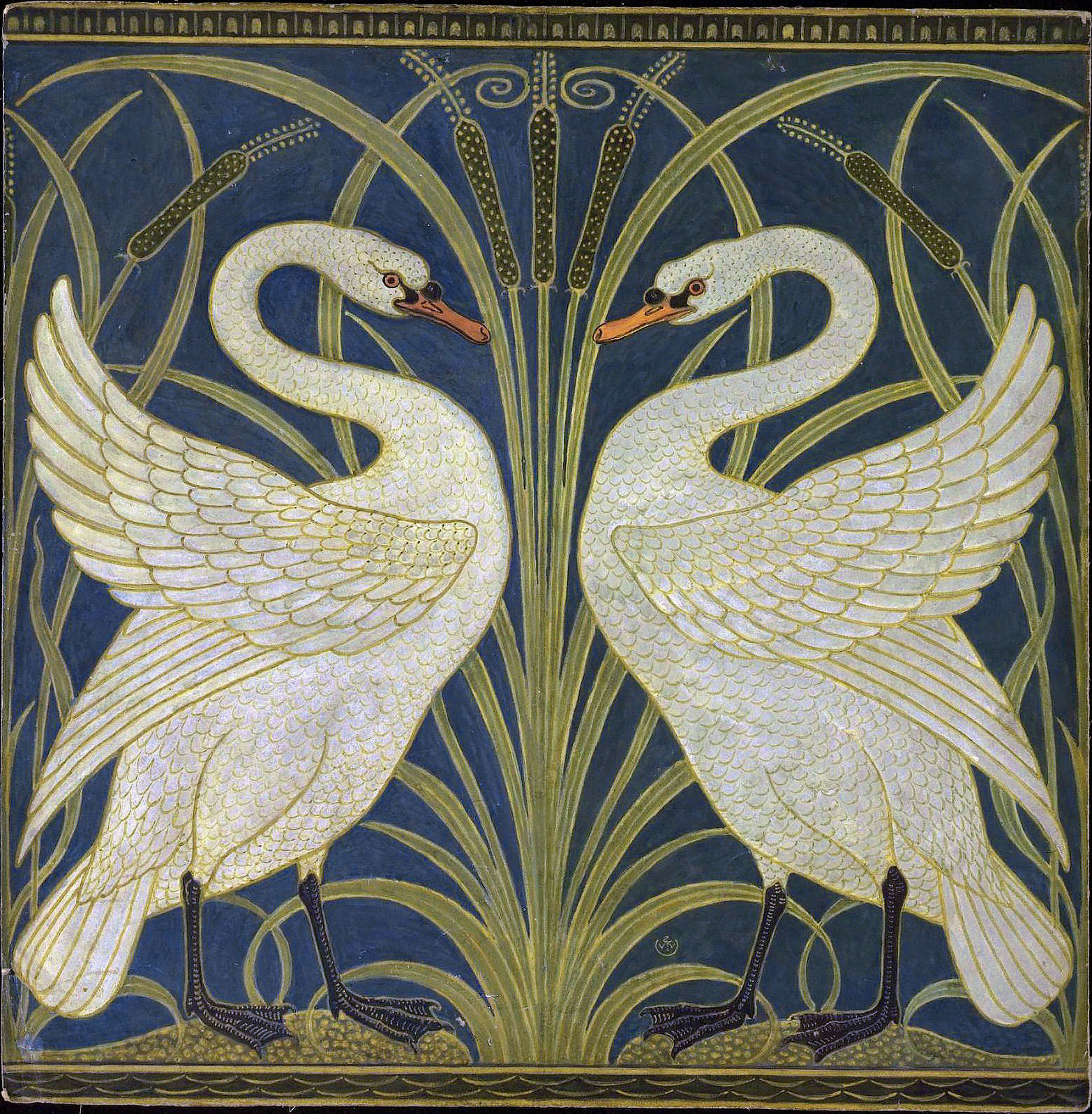
Courtesy: By Walter Crane – This file was derived from: Swan and Rush and Iris wallpaper Walter Crane.jpg:, Public Domain, https://commons.wikimedia.org/w/index.php?curid=115001625
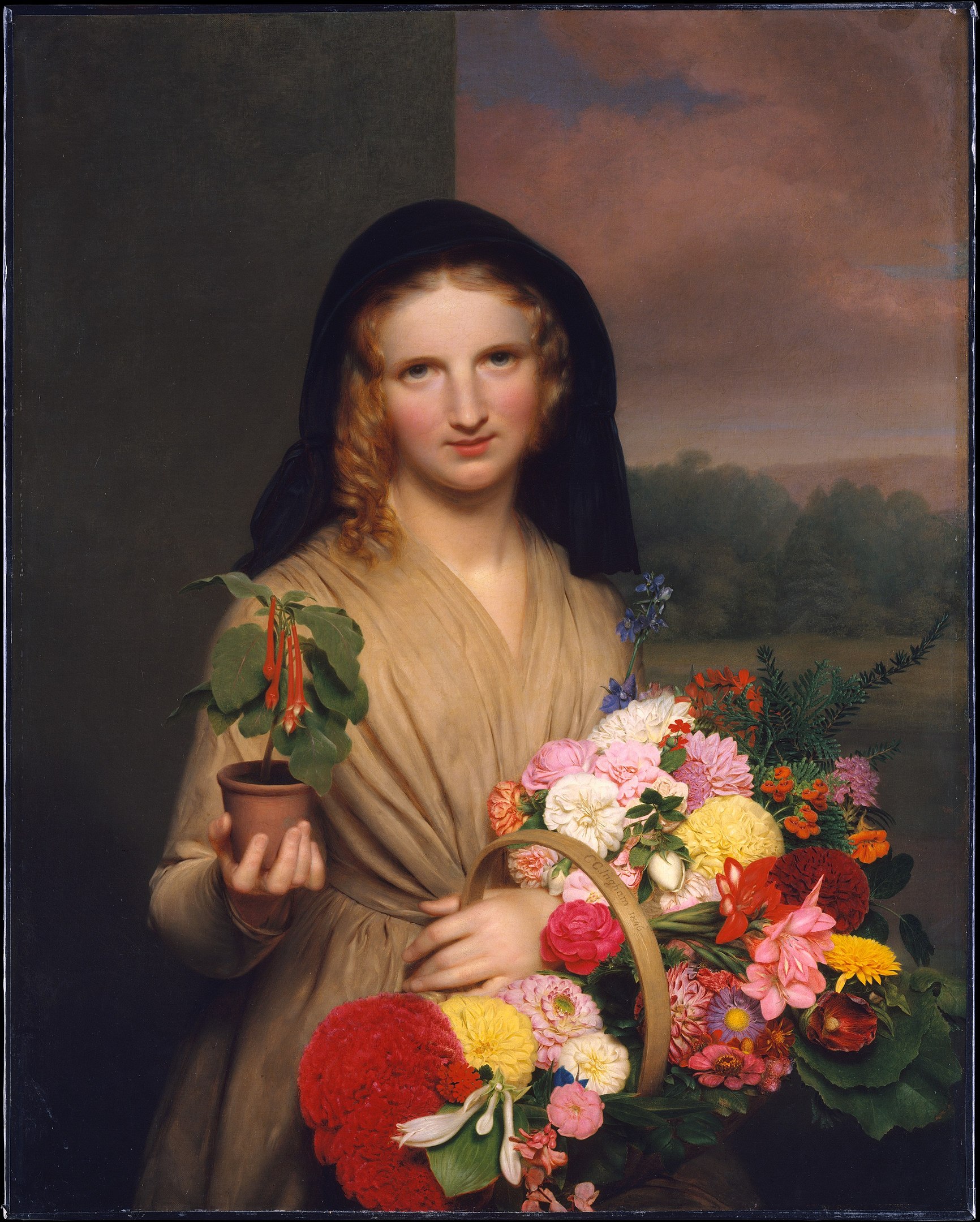
Courtesy: Gift of William Church Osborn, 1902. “https://www.metmuseum.org/art/collection/search/11207” is licensed under CC0 1.0.
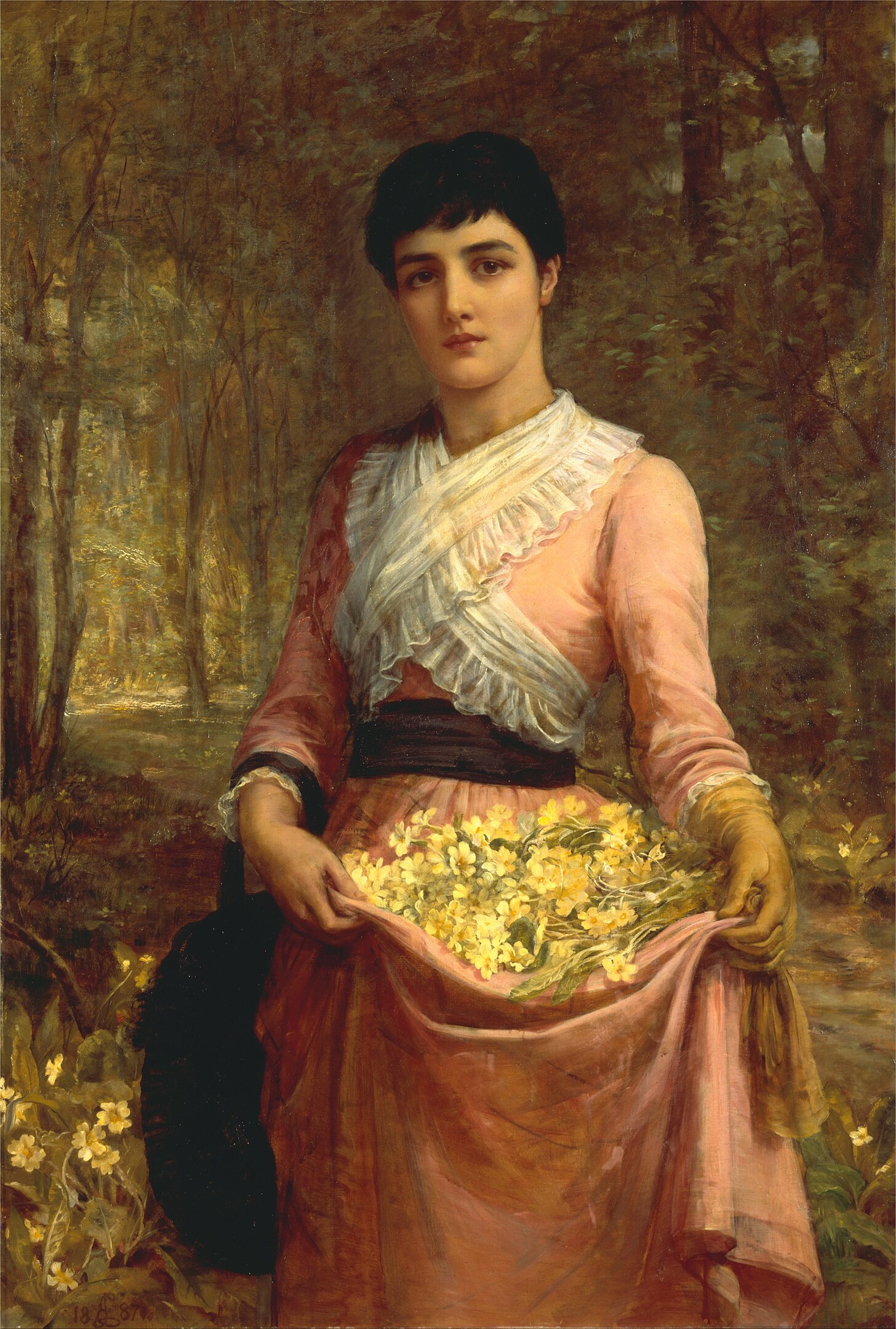
Courtesy: Yale Center for British Art, Gift of Virginia Kincaid Huschke in memory of Arthur J. Morris. “https://collections.britishart.yale.edu/catalog/tms:12021” is licensed under CC0 1.0.
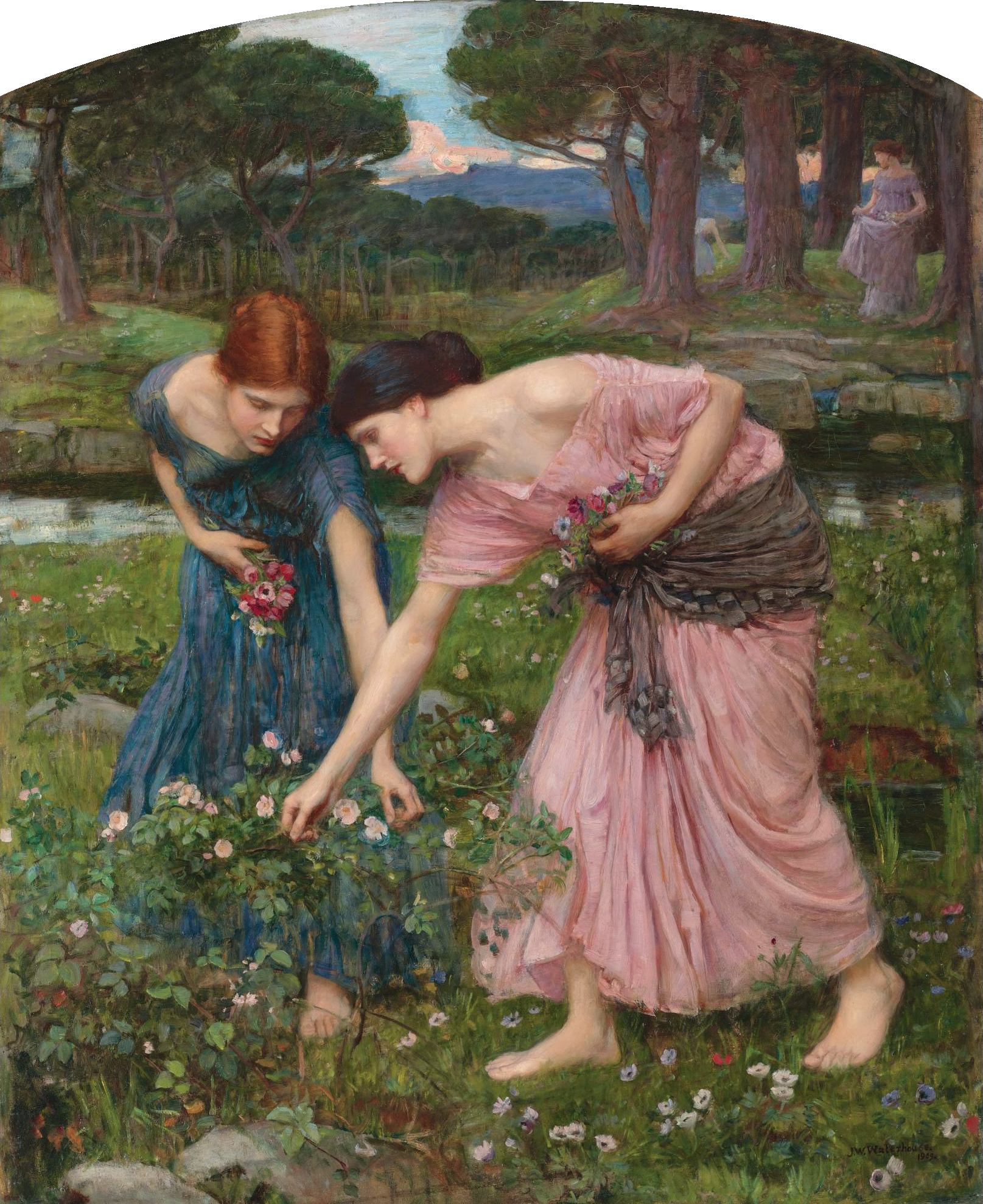
Courtesy: By John William Waterhouse – Sotheby’s – image, Public Domain, https://commons.wikimedia.org/w/index.php?curid=184819
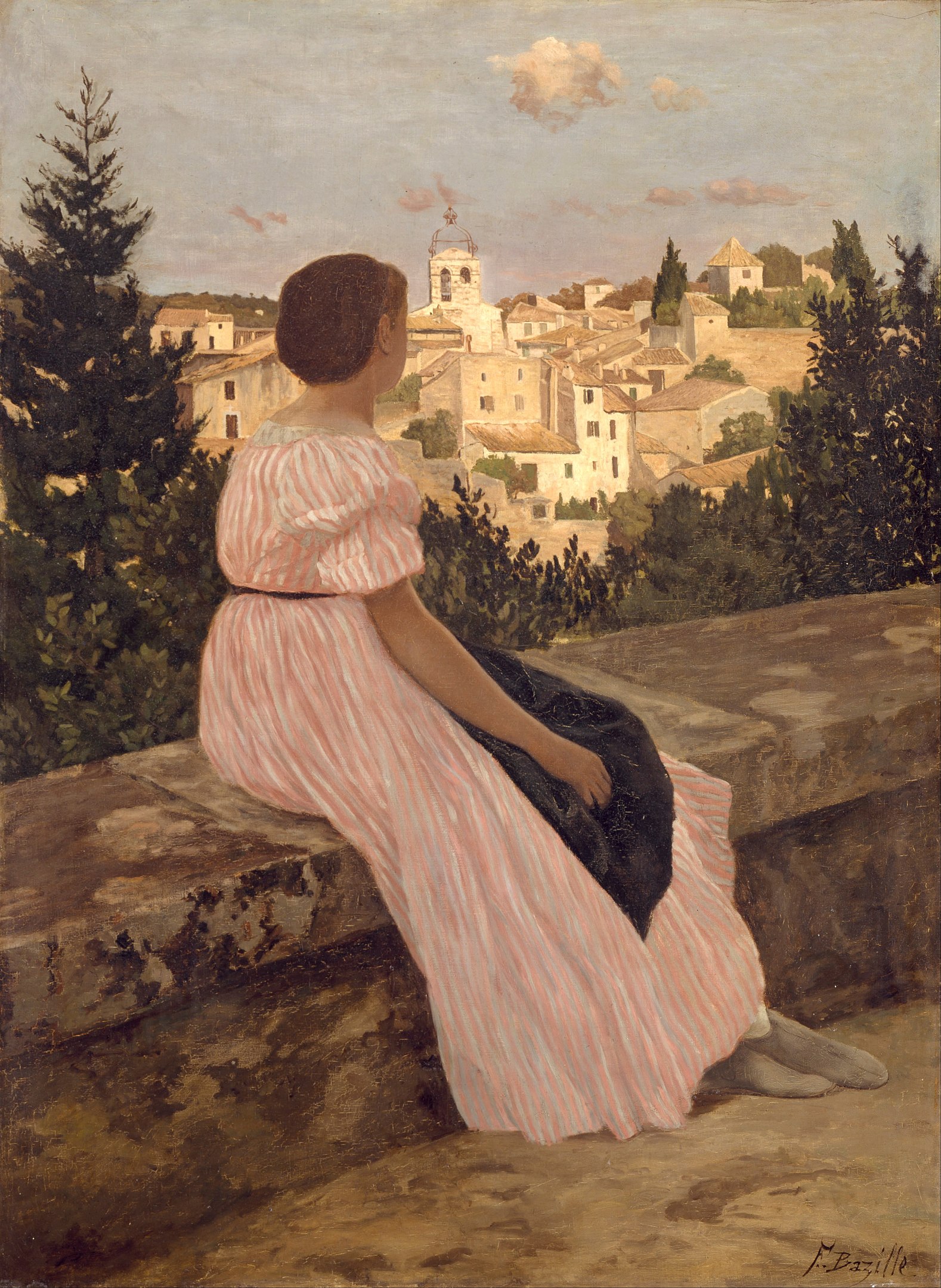
Courtesy: By Frédéric Bazille – FgFqwSIvrS6hBA at Google Cultural Institute maximum zoom level, Public Domain, https://commons.wikimedia.org/w/index.php?curid=21880337
“To the Virgins, Make Much of Time” by Robert Herrick
Gather ye rose-buds while ye may:
Old Time is still a-flying;
And this same flower that smiles to-day,
To-morrow will be dying.
The glorious lamp of heaven, the Sun,
The higher he’s a-getting,
The sooner will his race be run,
And nearer he’s to setting.
That age is best, which is the first,
When youth and blood are warmer;
But being spent, the worse, and worst
Times, still succeed the former.
—Then be not coy, but use your time,
And while ye may, go marry;
For having lost but once your prime,
You may for ever tarry.
“In the Heart of a Rose” by George Marion McClellan
I will hide my soul and its mighty love
In the bosom of this rose,
And its dispensing breath will take
My love where’er it goes.
And perhaps she’ll pluck this very rose,
And quick as blushes start,
Will breathe my hidden secret in
Her unsuspecting heart.
And there I will live in her embrace
And the realm of sweetness there,
Enamored with an ecstasy
Of bliss beyond compare.
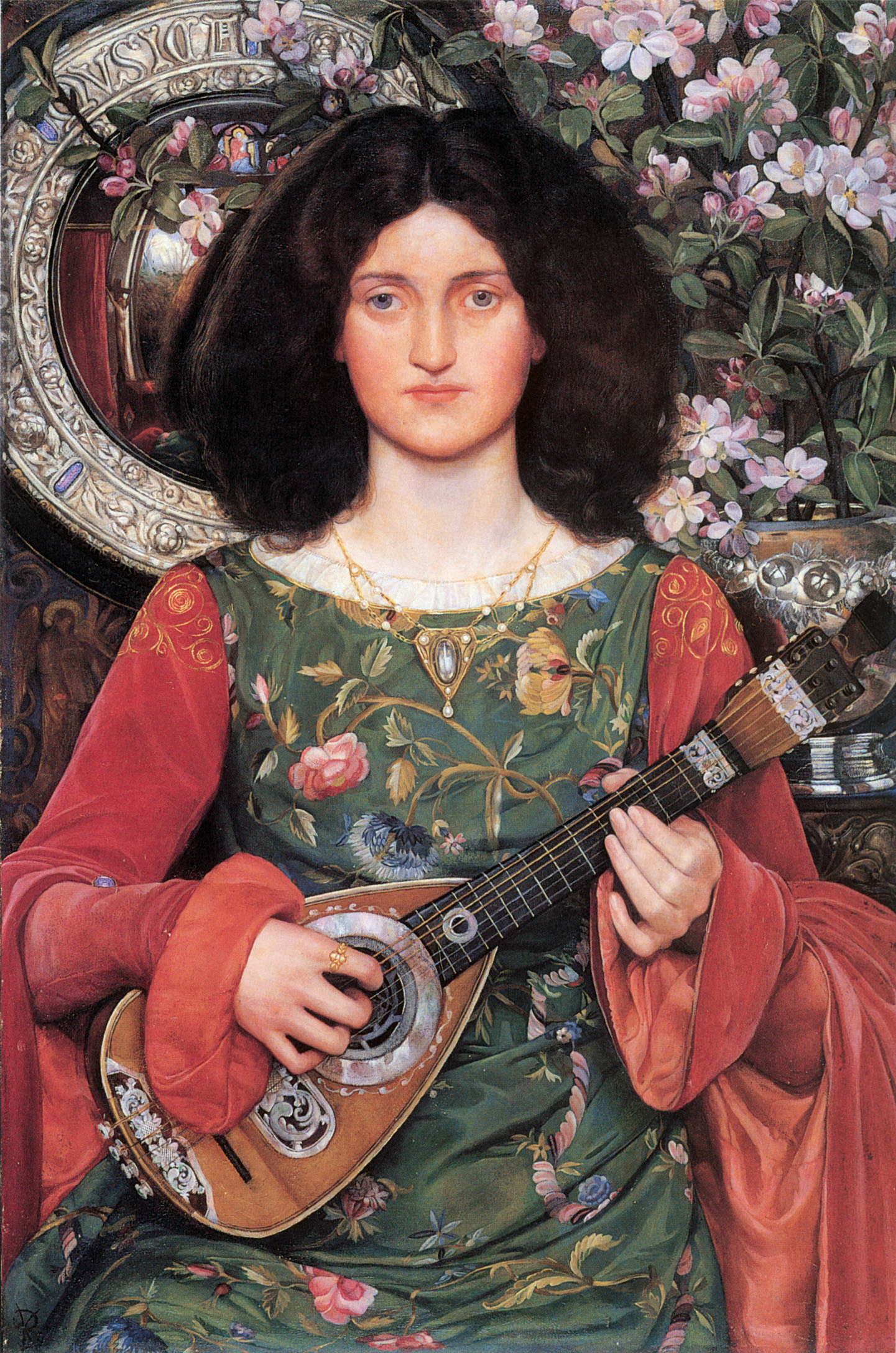
Courtesy: By Kate Elizabeth Bunce, English, 1856-1927 – http://free4444.blogspot.com/2010/07/bunce-kate-elizabeth-melody-c1895-97.html, Public Domain, https://commons.wikimedia.org/w/index.php?curid=10889773
“The Cycle” by Theodore Roethke
Dark water, underground,
Beneath the rock and clay,
Beneath the roots of trees,
Moved into common day,
Rose from a mossy mound
In mist that sun could seize.
The fine rain coiled in a cloud
Turned by revolving air
Far from that colder source
Where elements cohere
Dense in the central stone.
The air grew loose and loud.
Then, with diminished force,
The full rain fell straight down,
Tunneled with lapsing sound
Under even the rock-shut ground,
Under a river’s source,
Under primeval stone.
(p.48, The Collected Poems of Theodore Roetke, Anchor Books, 1975).
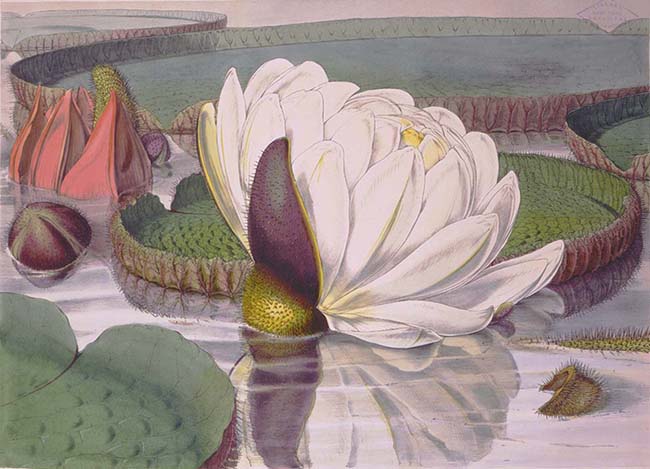
Courtesy: By Walter Hood Fitch – Victoria regia. Hooker reporduced at LuEsther T. Mertz Library ., Public Domain, https://commons.wikimedia.org/w/index.php?curid=2729086
“Water Lily” by Rainer Maria Rilke (Translated by A. Poulin)
My whole life is mine, but whoever says so
will deprive me, for it is infinite.
The ripple of water, the shade of the sky
are mine; it is still the same, my life.
No desire opens me: I am full,
I never close myself with refusal-
in the rhythm of my daily soul
I do not desire-I am moved;
by being moved I exert my empire,
making the dreams of night real:
into my body at the bottom of the water
I attract the beyonds of mirrors…
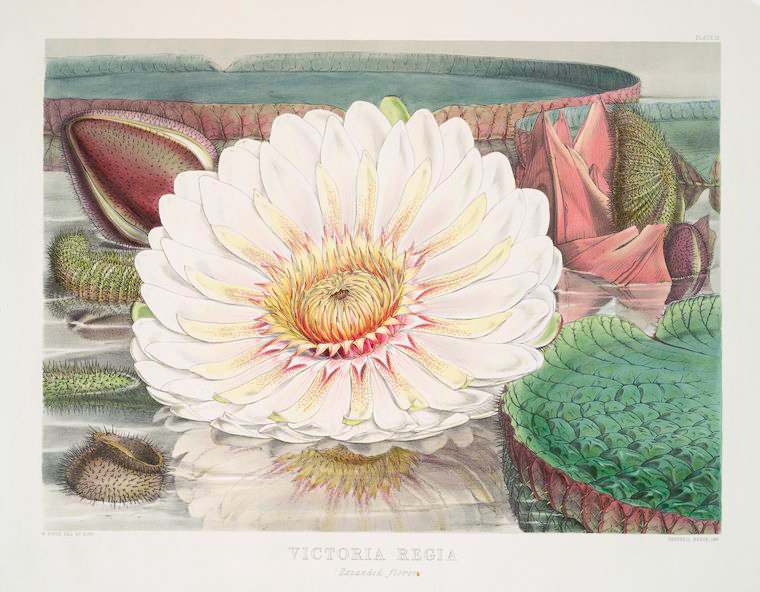
Courtesy: By Walter Hood Fitch, lithography – Victoria Regia : or, Illustrations of the Royal water-lily, in a series of figures chiefly made from specimens flowering at Syon and at Kew by Walter Fitch; with descriptions by Sir W.J. Hooker. Scan of illustrations at The New York Public Library., Public Domain, https://commons.wikimedia.org/w/index.php?curid=6411619
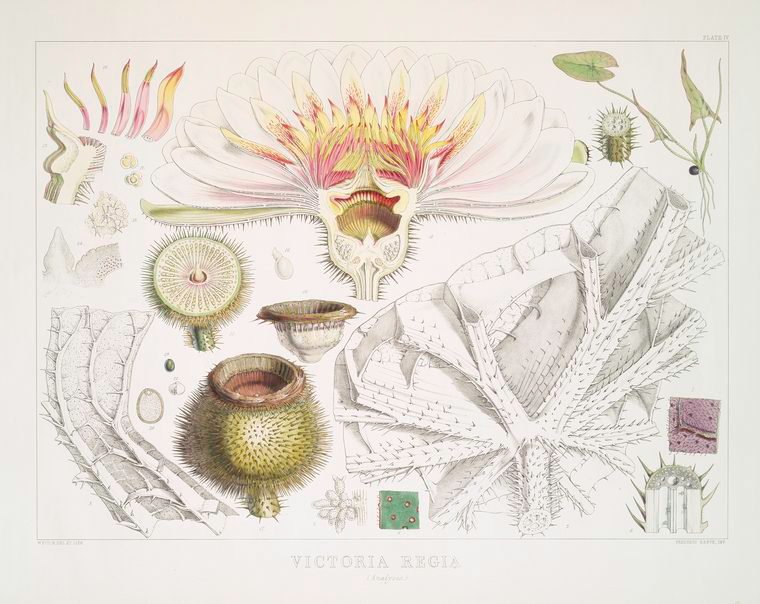
Courtesy: By Walter Hood Fitch, lithography – Victoria Regia : or, Illustrations of the Royal water-lily, in a series of figures chiefly made from specimens flowering at Syon and at Kew by Walter Fitch; with descriptions by Sir W.J. Hooker. Scan of illustrations at The New York Public Library., Public Domain, https://commons.wikimedia.org/w/index.php?curid=6411605
“Water Lilies” by A.A. Milne
Where the water-lilies go
To and fro,
Rocking in the ripples of the water,
Lazy on a leaf lies the Lake King’s daugher,
And the faint winds shake her.
Who will come and take her?
I will! I will!
Keep still! Keep still!
Sleeping on a leaf lies the Lake King’s daughter. . . .
Then the wind comes skipping
To the lilies on the water;
And the kind winds wake her.
Now who will take her?
With a laugh she is slipping
Through the lilies on the water.
Wait! Wait!
Too late, too late!
Only the water-lilies go
To and fro,
Dipping, dipping,
To the ripples of the water.
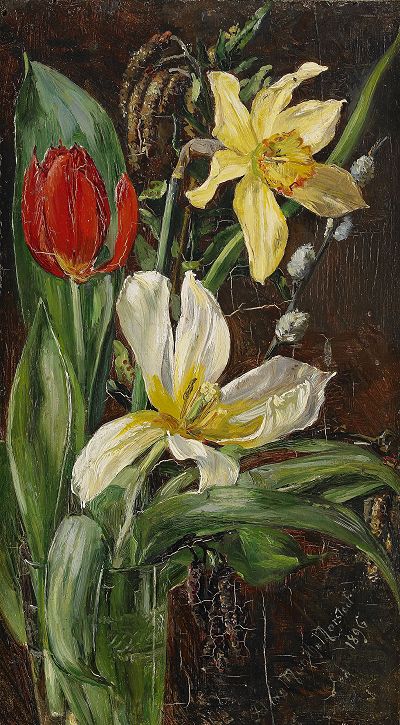
Courtesy: By Anna Munthe-Norstedt – www.auktionsverket.se, Public Domain, https://commons.wikimedia.org/w/index.php?curid=7468841
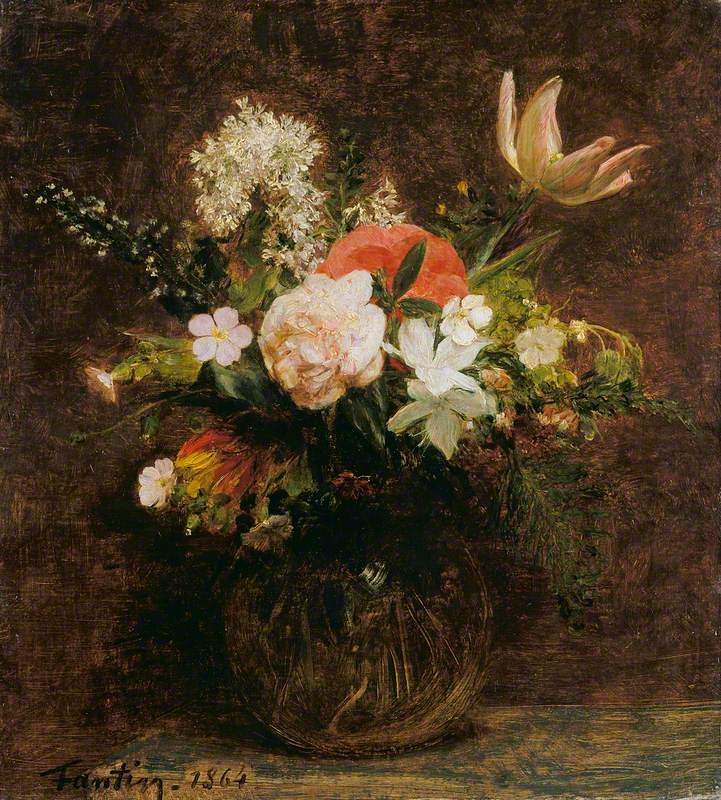
Courtesy: By Henri Fantin-Latour – Art UK, Public Domain, https://commons.wikimedia.org/w/index.php?curid=97452925
Bird and Flower Illustrations by Martin Johnson Heade (1819-1904)
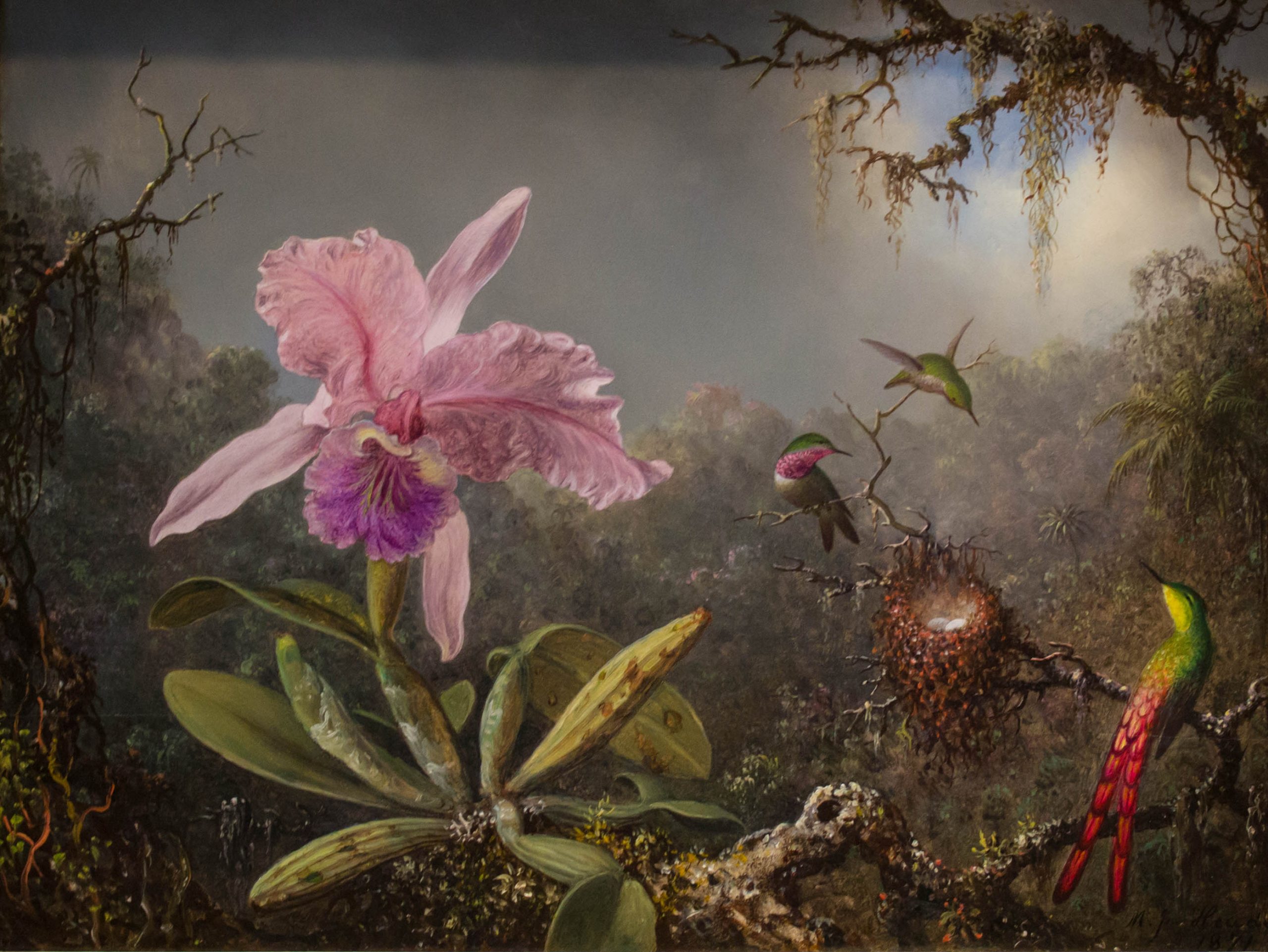
Courtesy: Gift of the Morris and Gwendolyn Cafritz Foundation. “https://www.nga.gov/collection/art-object-page.61244.html” is licensed under CC0 1.0.
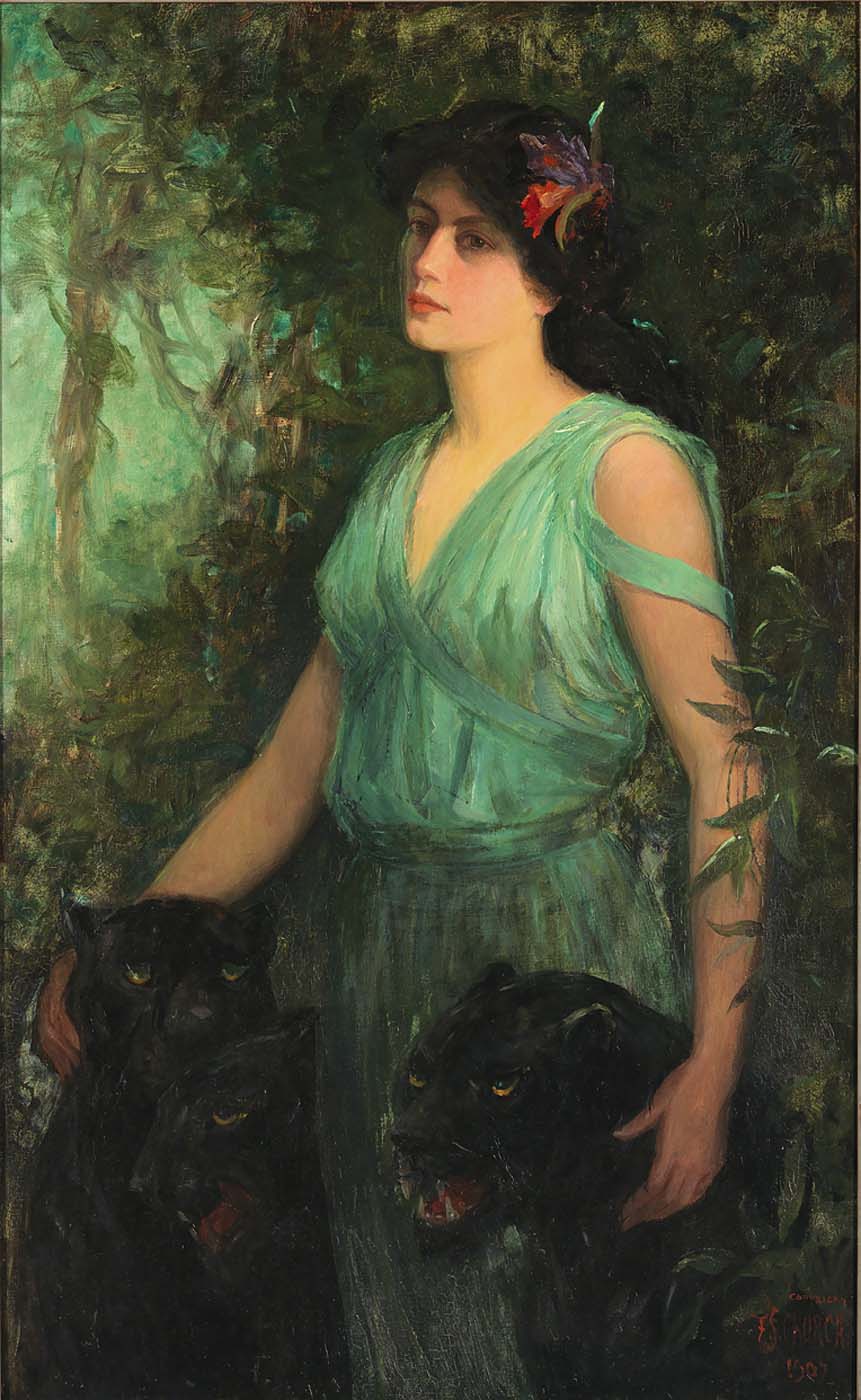
Courtesy: Gift of William T. Evans. “https://americanart.si.edu/artwork/black-orchid-4808” is licensed under CC0 1.0.
“Orchids” by Theodore Roethke
They lean over the path,
Adder-mouthed,
Swaying close to the face,
Coming out, soft and deceptive,
Limp and damp, delicate as a young bird’s tongue;
Their fluttery fledgling lips
Move slowly,
Drawing in the warm air.The faint moon…
(SEE ROETHKE, p. 37, Collected Poems)
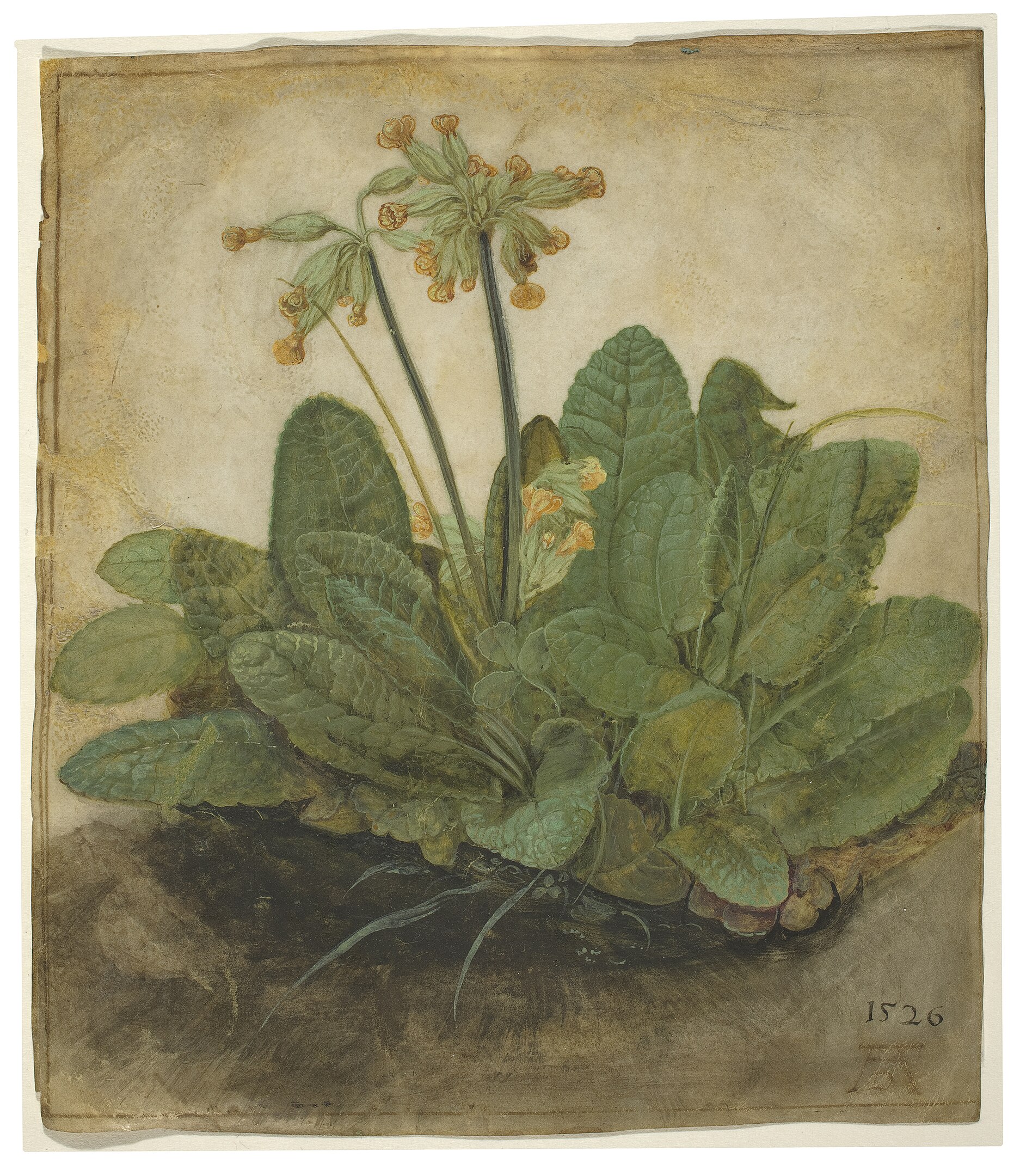
Courtesy: The Armand Hammer Collection. “https://www.nga.gov/collection/art-object-page.74162.html” is licensed under CC0 1.0.
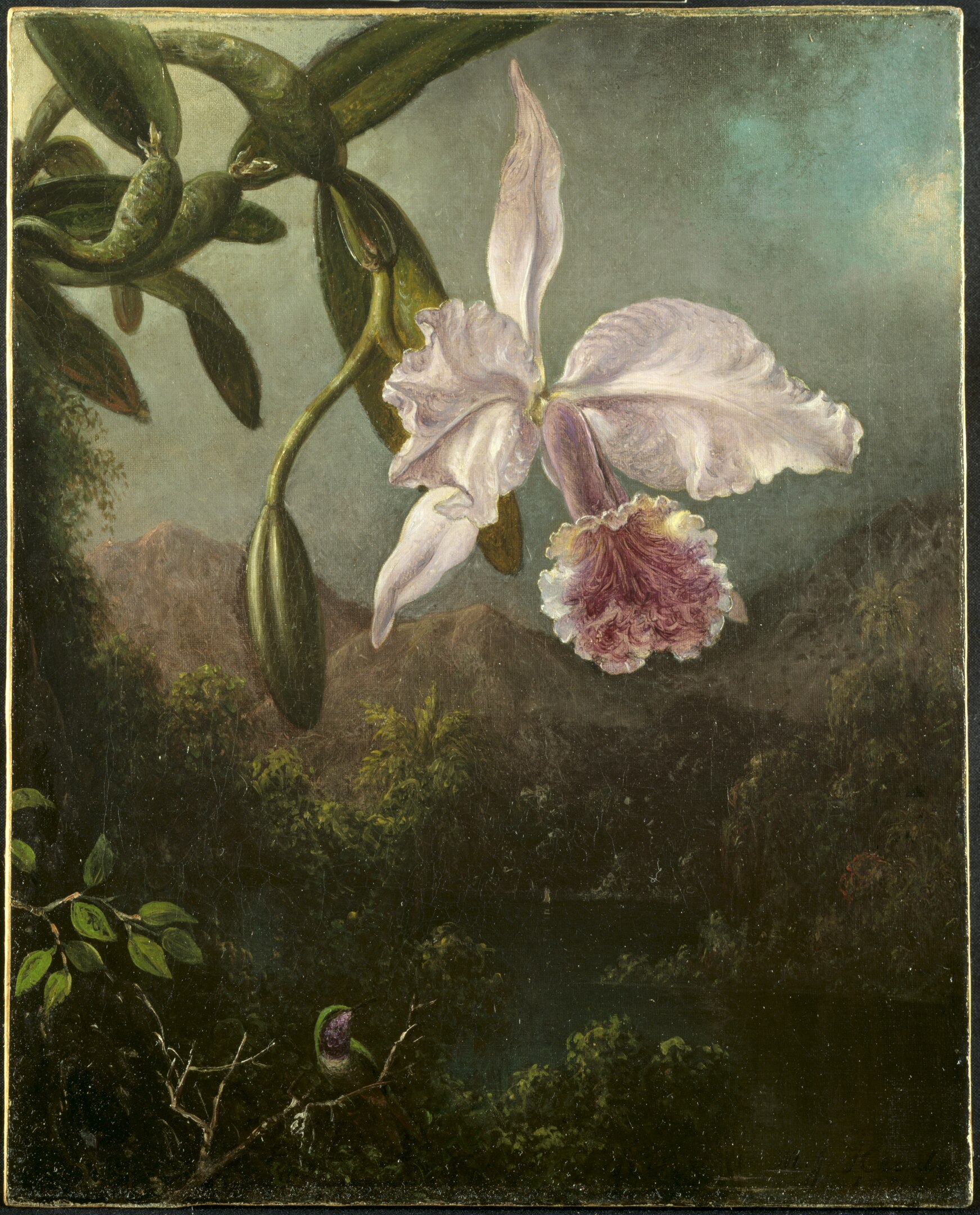
Courtesy: Hinman B. Hurlbut Collection. “https://www.clevelandart.org/art/1915.461” is licensed under CC0 1.0.
Cleveland Art Gallery Note about the Painting.
“Heade took the first of three trips to South America, with an amateur naturalist, the Reverend C. J. Fletcher, to do studies for a projected (though never published) book on hummingbirds. As an outgrowth of that experience, Heade made a large number of paintings of birds and flowers, especially orchids, in a tropical setting. In this way he combined his main interests of still life and landscape–a union of themes he maintained in his work into the 20th century. The paintings are characterized by meticulous and precise rendering of detail and high-keyed luminescent color.”
For more examples of Martin Johnson Heade’s art please open here.
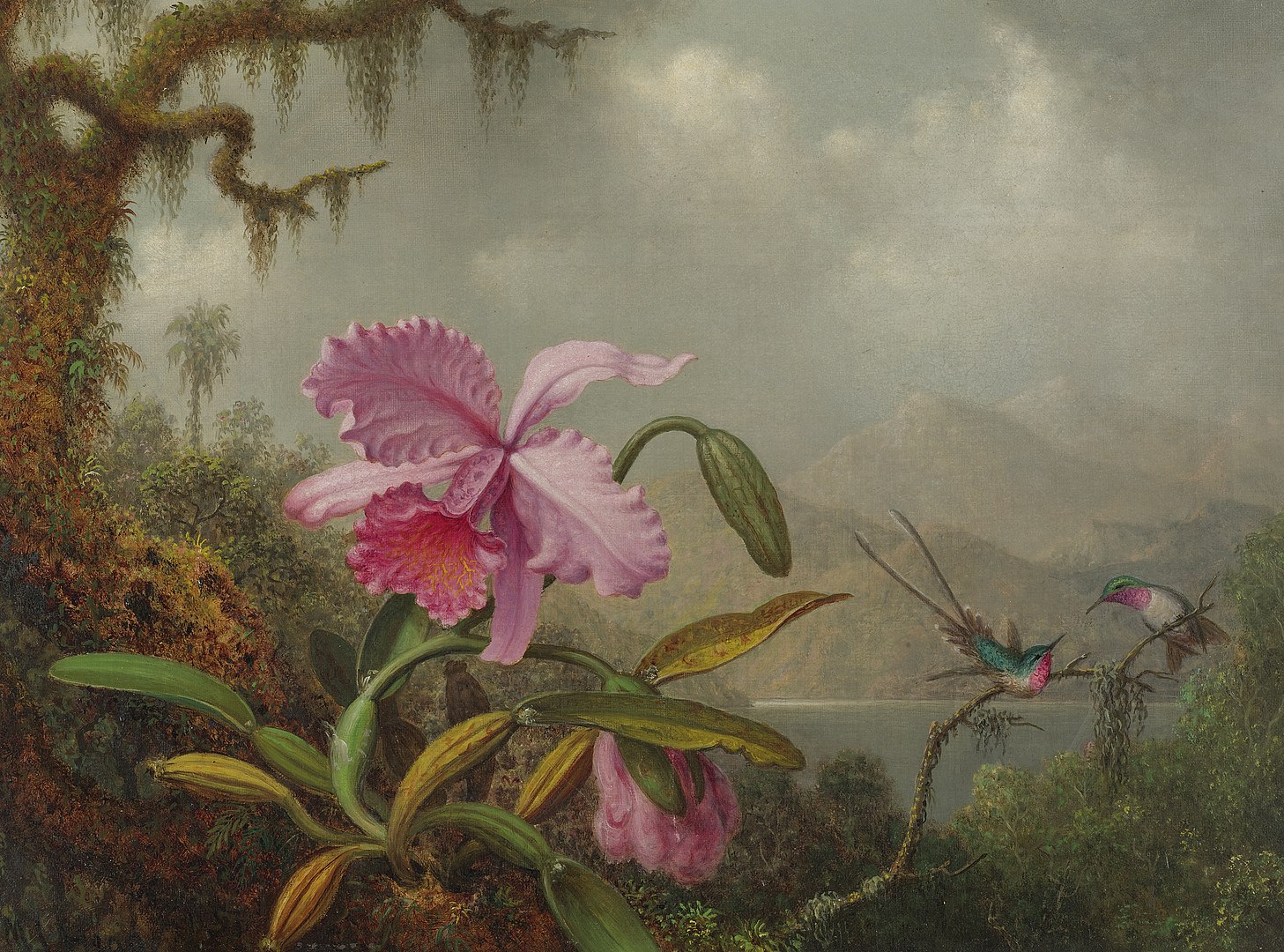
Courtesy: By Martin Johnson Heade – Sotheby’s, New York, 1 December 2011, lot 8, Public Domain, https://commons.wikimedia.org/w/index.php?curid=17588761
“Heade took the first of three trips to South America, with an amateur naturalist, the Reverend C. J. Fletcher, to do studies for a projected (though never published) book on hummingbirds. As an outgrowth of that experience, Heade made a large number of paintings of birds and flowers, especially orchids, in a tropical setting. In this way he combined his main interests of still life and landscape–a union of themes he maintained in his work into the 20th century. The paintings are characterized by meticulous and precise rendering of detail and high-keyed luminescent color.”
For more examples of Martin Johnson Heade’s art please open the link here.
“Moss-Gathering” by Theodore Roethke
“Root Cellar” by Theodore Roethke
Nothing would sleep in that cellar, dank as a ditch,
Bulbs broke out of boxes hunting for chinks in the dark,
Shoots dangled and drooped,
Lolling obscenely from mildewed crates,
Hung down long yellow evil necks, like tropical snakes.
And what a congress of stinks!
Roots ripe as old bait,
Pulpy stems, rank, silo-rich,
Leaf-mold, manure, lime, piled against slippery planks.
Nothing would give up life:
Even the dirt kept breathing a small breath.
(From: The Collected Poems by Theodore Roethke (1975) New York: Anchor Books)
“Consider” by Christina Rossetti
Consider
The lilies of the field whose bloom is brief:—
We are as they;
Like them we fade away,
As doth a leaf.
Consider
The sparrows of the air of small account:
Our God doth view
Whether they fall or mount,—
He guards us too.
Consider
The lilies that do neither spin nor toil,
Yet are most fair:—
What profits all this care
And all this coil?
Consider
The birds that have no barn nor harvest-weeks;
God gives them food:—
Much more our Father seeks
To do us good.
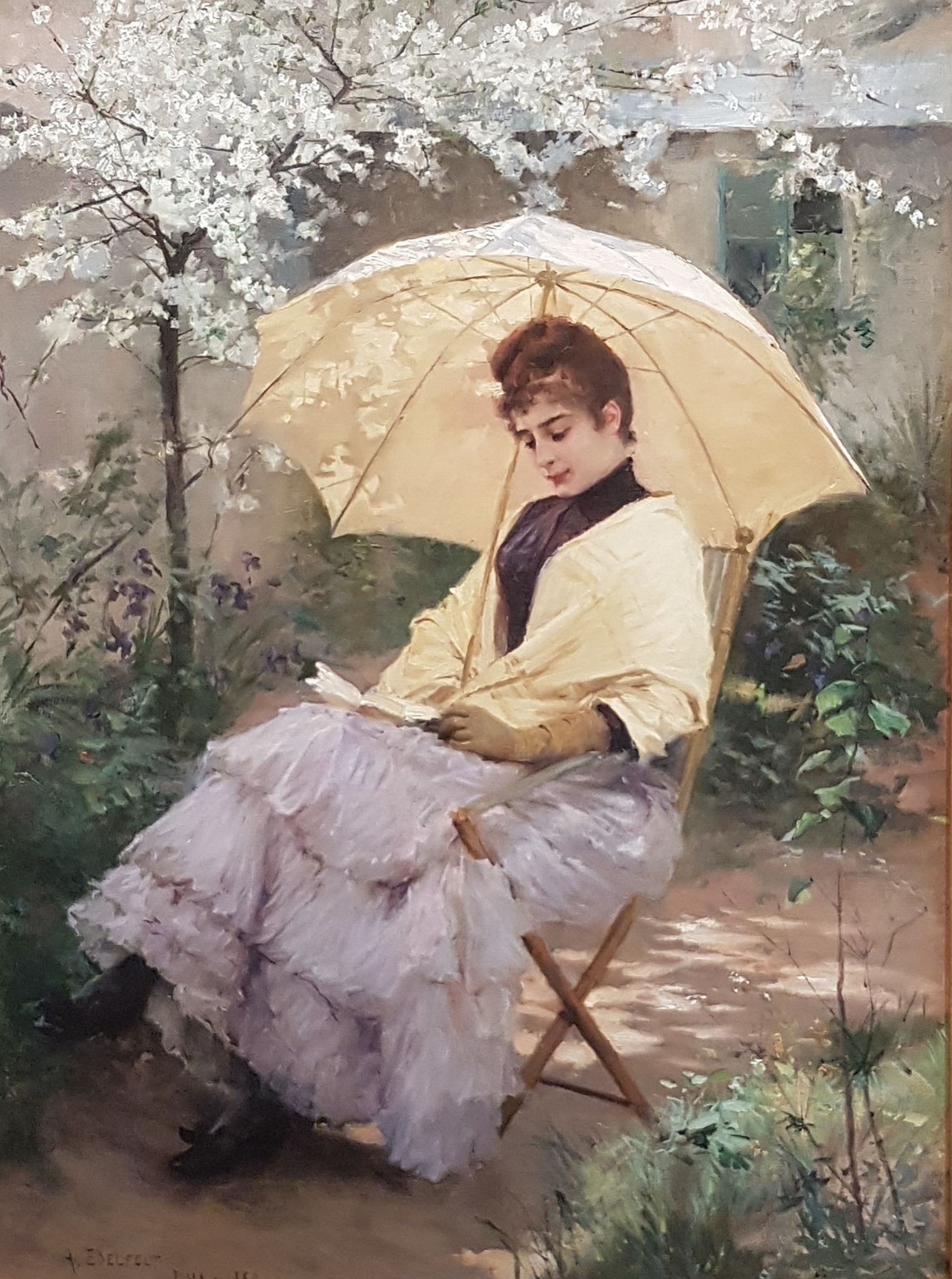
Courtesy: By Albert Edelfelt – https://www.facebook.com/KirsinKirjanurkka/photos/a.312252415507062/2506256879439927/, Public Domain, https://commons.wikimedia.org/w/index.php?curid=92670267
SUMMER
“A Summer Wish” by Christina Rossetti
Live all thy sweet life through
Sweet Rose, dew-sprent,
Drop down thine evening dew
To gather it anew
When day is bright:
I fancy thou wast meant
Chiefly to give delight.
Sing in the silent sky,
Glad soaring bird;
Sing out thy notes on high
To sunbeam straying by
Or passing cloud;
Heedless if thou art heard
Sing thy full song aloud.
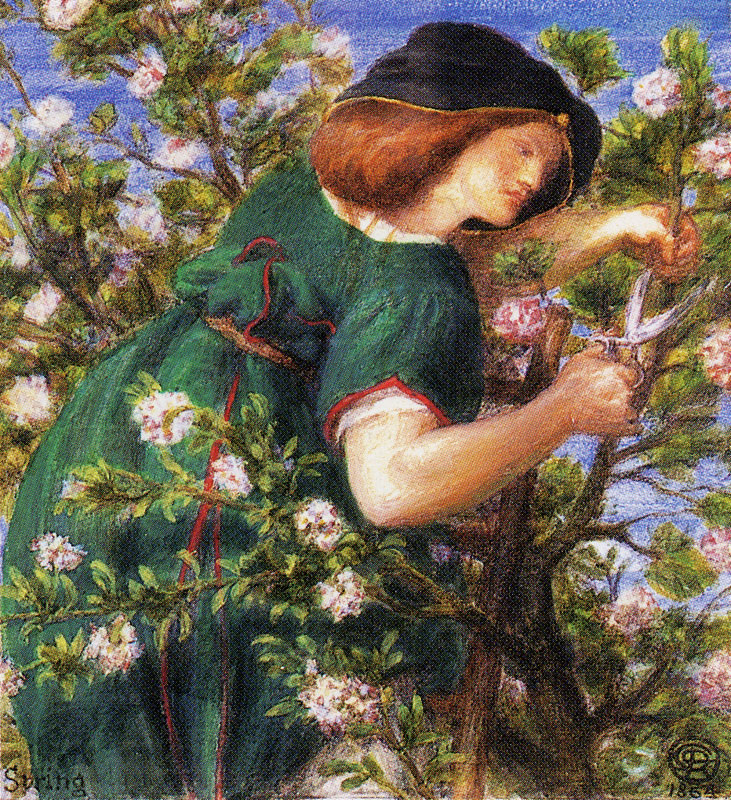
Courtesy: By Dante Gabriel Rossetti – https://www.pubhist.com/w21251, Public Domain, https://commons.wikimedia.org/w/index.php?curid=49034969
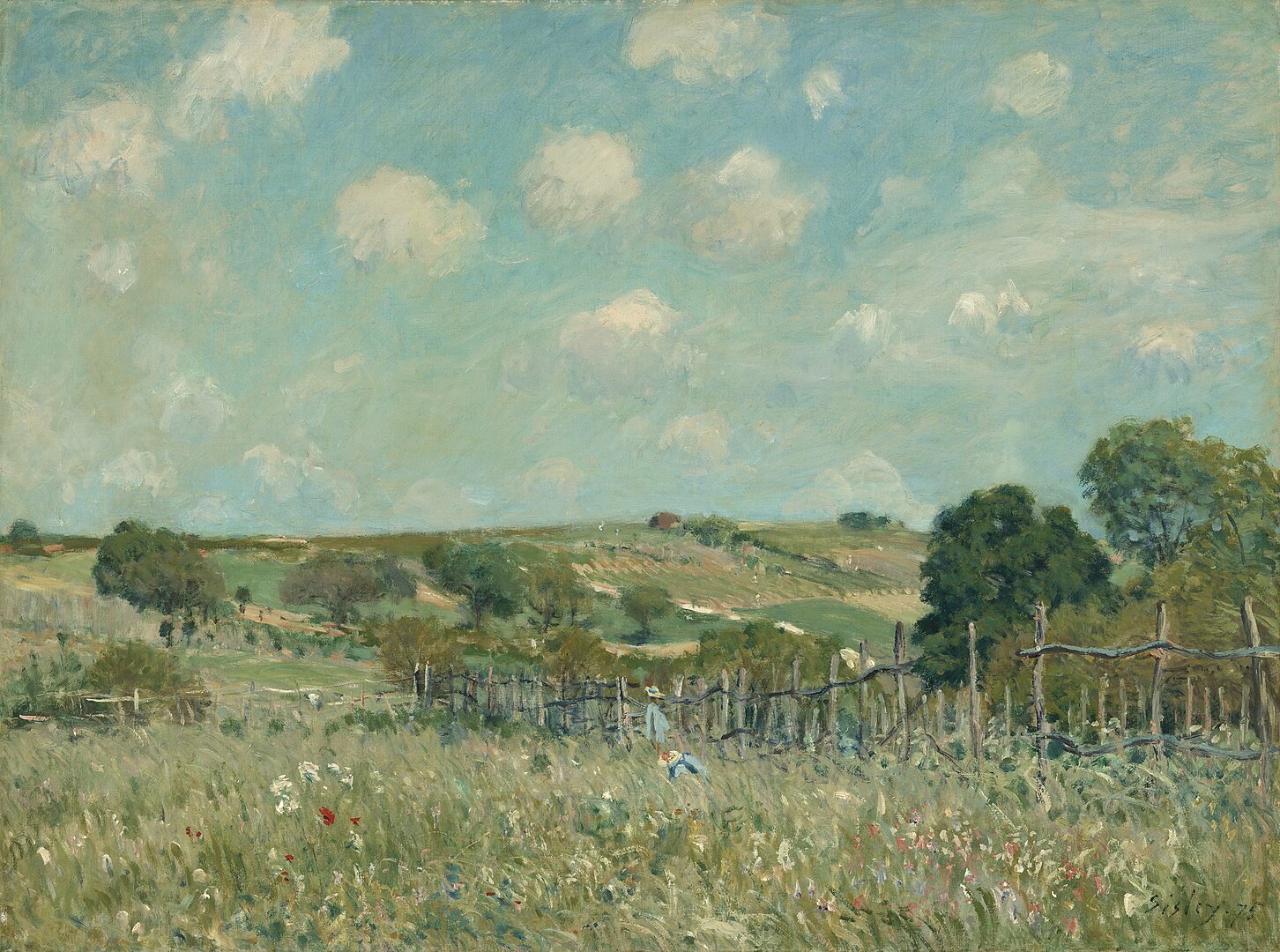
Courtesy: Ailsa Mellon Bruce Collection. “https://www.nga.gov/collection/art-object-page.52227.html” is licensed under CC0 1.0.
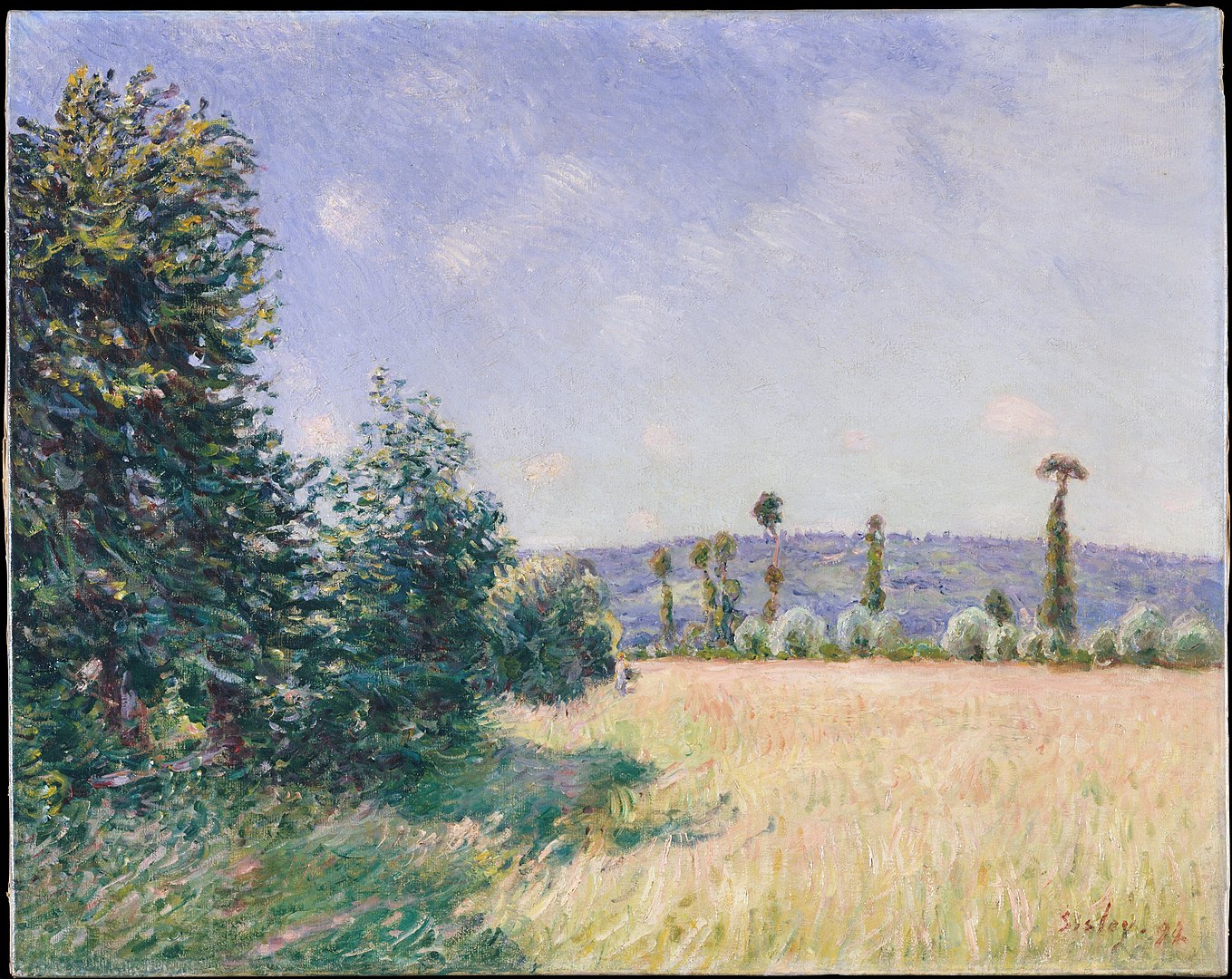
Courtesy: Gift of Janice H. Levin, 1991. “https://www.metmuseum.org/art/collection/search/437683” is licensed under CC0 1.0.
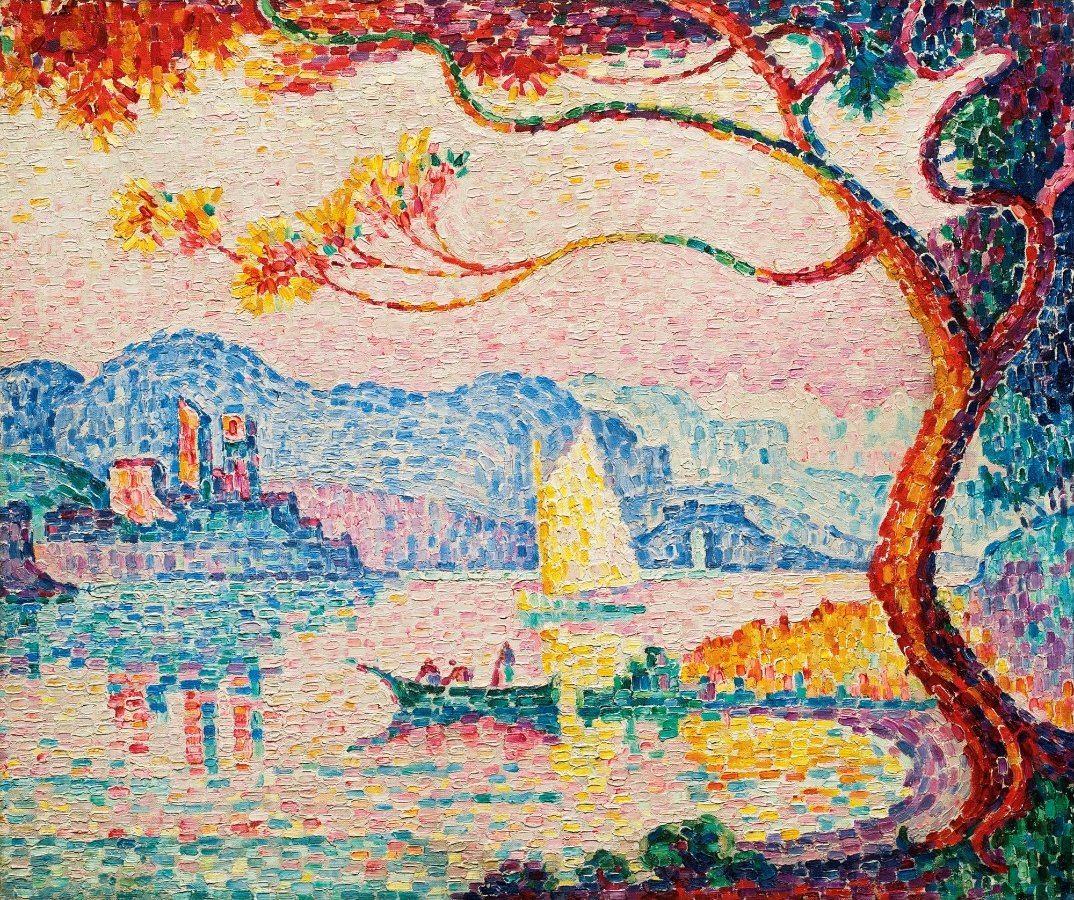
Courtesy: By Paul Signac – Sotheby’s, Public Domain, https://commons.wikimedia.org/w/index.php?curid=46851893
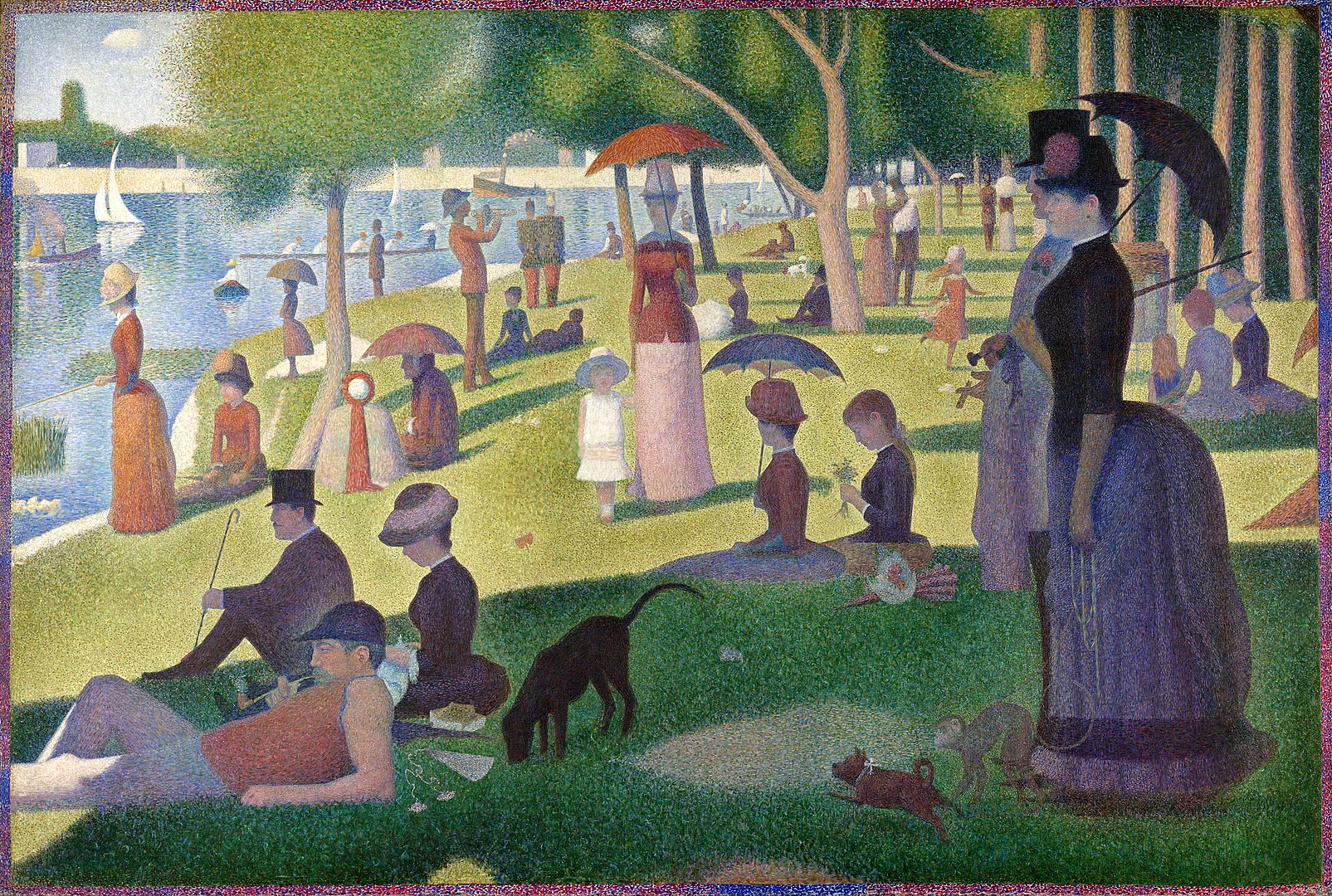
Courtesy: Helen Birch Bartlett Memorial Collection. “https://www.artic.edu/artworks/27992/a-sunday-on-la-grande-jatte-1884” is licensed under CC0 1.0.
Post Impressionist Art of Georges Seurat
It took George Seurat two years to complete this painting and the content derived from his close observation of people enjoying an afternoon at a part Seurat created the technique of “Pointillism” where brilliant colours and shapes are derived by applying tiny dots of painting to the canvas. Carolyn Schlam (2021) further notes that:
“[George] Seurat is considered a Postimpressionist, a movement considered as a bridge between Impressionism and Fauvism. His compatriots include Paul Cezanne, Paul Gaugin, and Vincent Van Gogh. These artists, each in his own way, went beyond the airy light concentration of the Impressionist to give their paintings more of an illusion of form. Rather than hewing to the strict rendering of the subject of light, they introduced more expressive elements, like more geometric contouring and more amplified colour” (Schlam, 2022, p. 175).
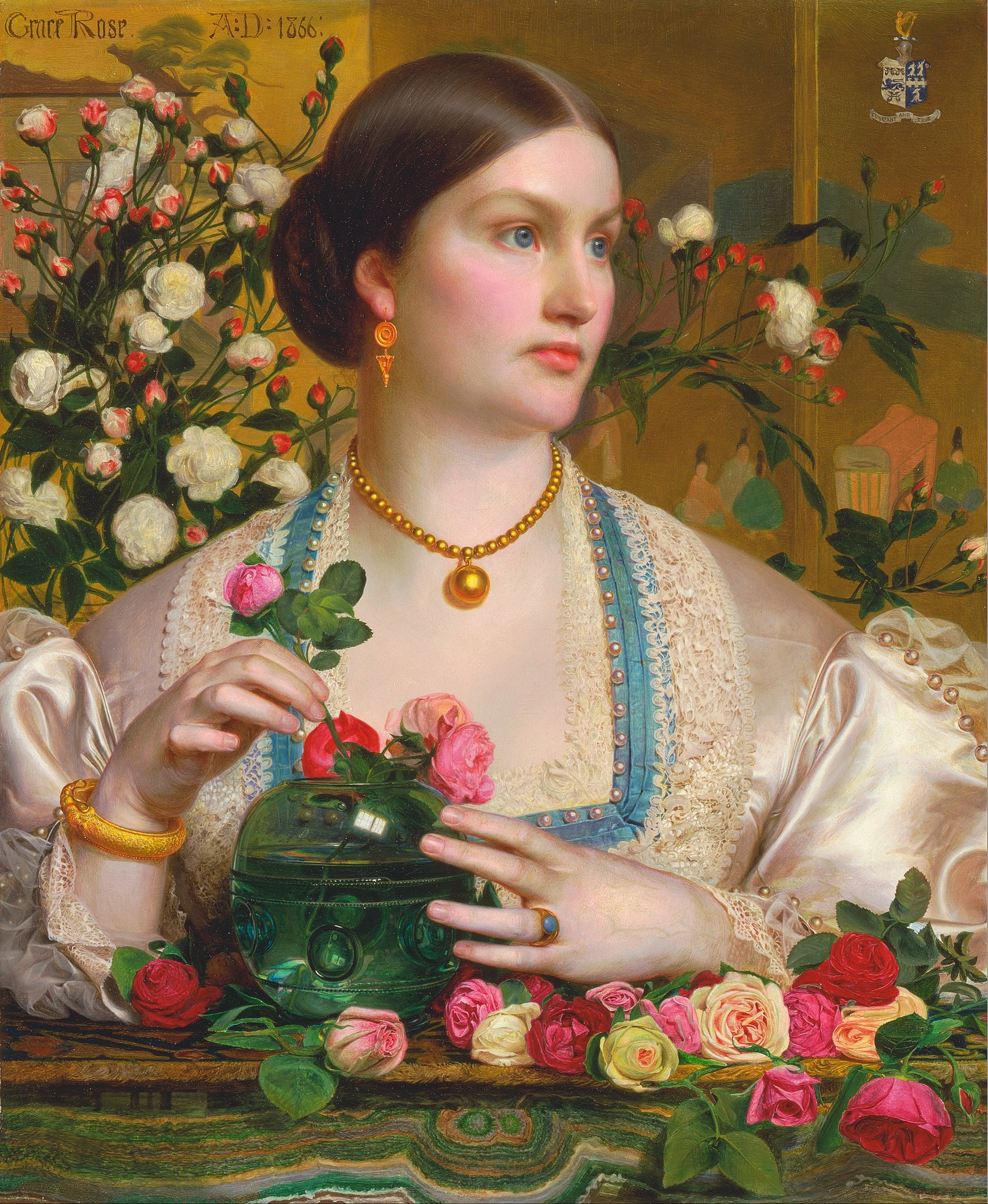
Courtesy: Yale Center for British Art, Paul Mellon Fund. “https://collections.britishart.yale.edu/catalog/tms:1381” is licensed under CC0 1.0.
A Rose by Emily Dickinson
A sepal, petal, and a thorn Upon a common summer’s morn, A flash of dew, a bee or two, A breeze A caper in the trees, — And I’m a rose!
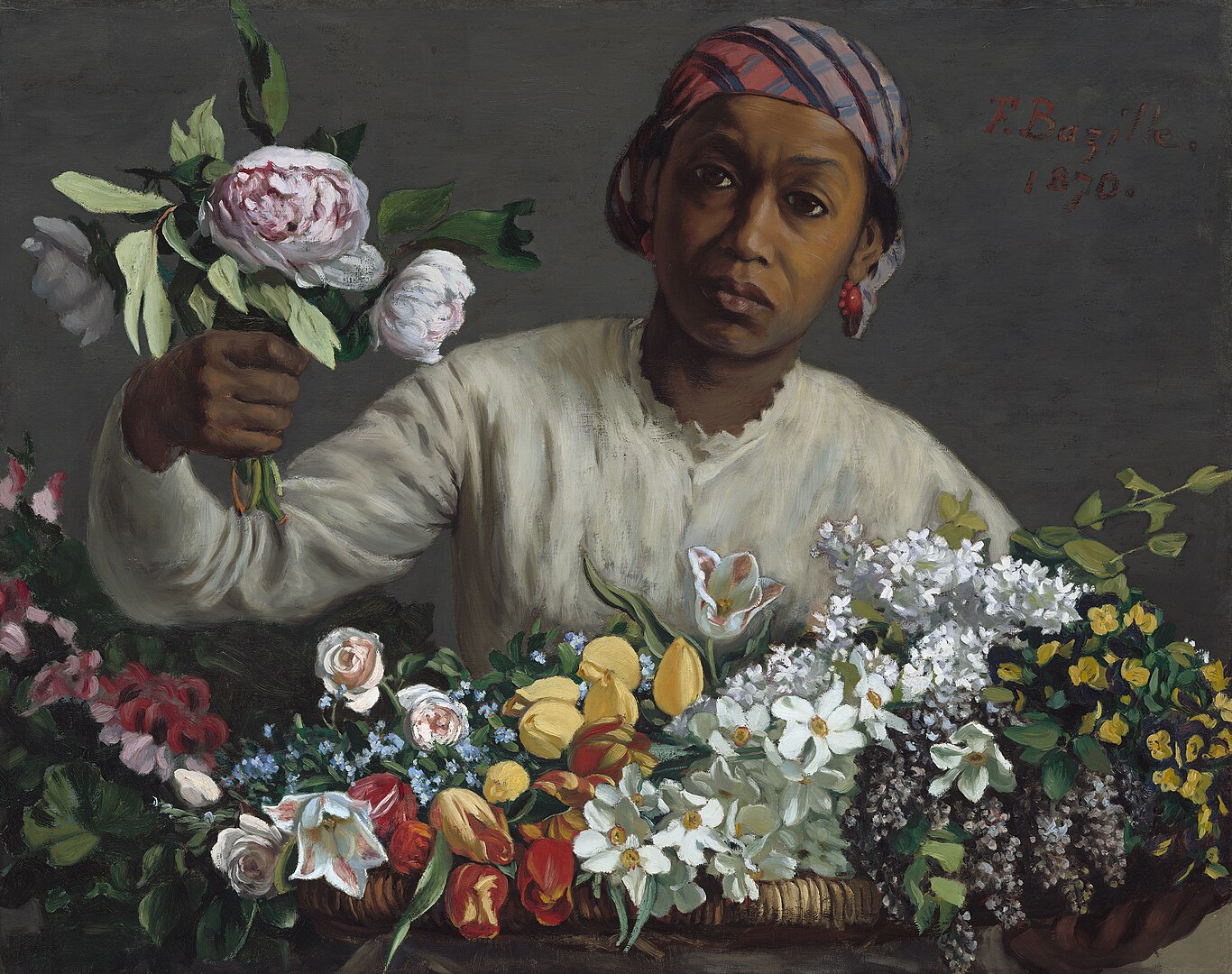
Courtesy: Collection of Mr. and Mrs. Paul Mellon. “https://www.nga.gov/collection/art-object-page.61356.html#inscription” is licensed under CC0 1.0.
Frédéric Bazille was one of the great innovative Impressionist and realist painters. His early and tragic death at 28 did not minimize his powerful influence on visionary, avant- garde, and realist art.
For more information about Frederic Bazille, please open the link here.
Botanical Illustrations and the Biodiversity Heritage Library
Intricate and beautifully illustrated 19th and 18th century books of flowers, plants, insects, and birds can be a rich learning source for a comparative analysis of the natural flower ecosystems -past, present, and future. Many of these illustrated texts are available online and links to the archival data bases are included in this section. Historic scientific illustrations can provide a foundation to compare the way our natural environment has changed over time. The Biodiversity Heritage Library (BHL) is a valuable source of information with an extensive collections of digitized illustrations and texts about animal s, plants, and myriad life forms. Working with open access Internet sources such as Wikimedia Commons and the Smithsonian Institution, the BHL encourages awareness, insight, and discovery through free access to biodiversity knowledge. Interdisciplinary links between art, science, literature, and ecology can be made as learners embark on self-directed and collaborative projects.
Women’s Contributions to Naturalist Studies
ILLUSTRATIONS
Maria Sybilla Meriam (1647-1717)
One of the leading women artists was also a scientist. Maria Sibylla Merian (1647-1717) painted meticulous depictions of insect metamorphosis and botanical diversity. Born in Frankfurt, Germany in the 17th century, Merian grew up in a family of artists and publishers. The artist and scientist Maria Sibylla Merian (1647-1717) was born in Frankfurt, Germany, into a middle-class family of publishers and artists. At the age of fifty-two, Merian travelled with her daughter to a Dutch Territory in South America. She continued to paint the incredible biodiversity of the flora and fauna in South America.
For more information about the scientific art work of Maria Sybilla Merian please open the essay here.
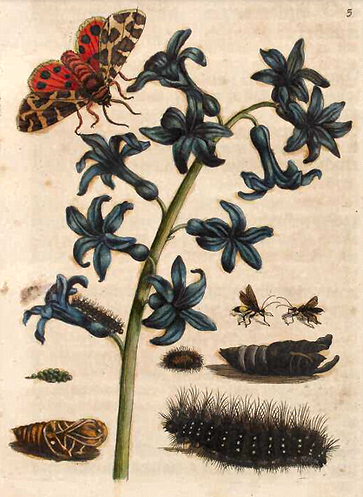
Courtesy: By Maria Sibylla Merian(Life time: 2 April 1647 – 13 January 1717) – Original publication: Der Raupen wunderbare Verwandlung und sonderbare Blumennahrung – The Caterpillars’ Marvelous Transformation and Strange Floral Food, Volume 1Immediate source: https://artinwords.de/maria-sibylla-merian-bilder-buecher/, PD-US, https://en.wikipedia.org/w/index.php?curid=56922587
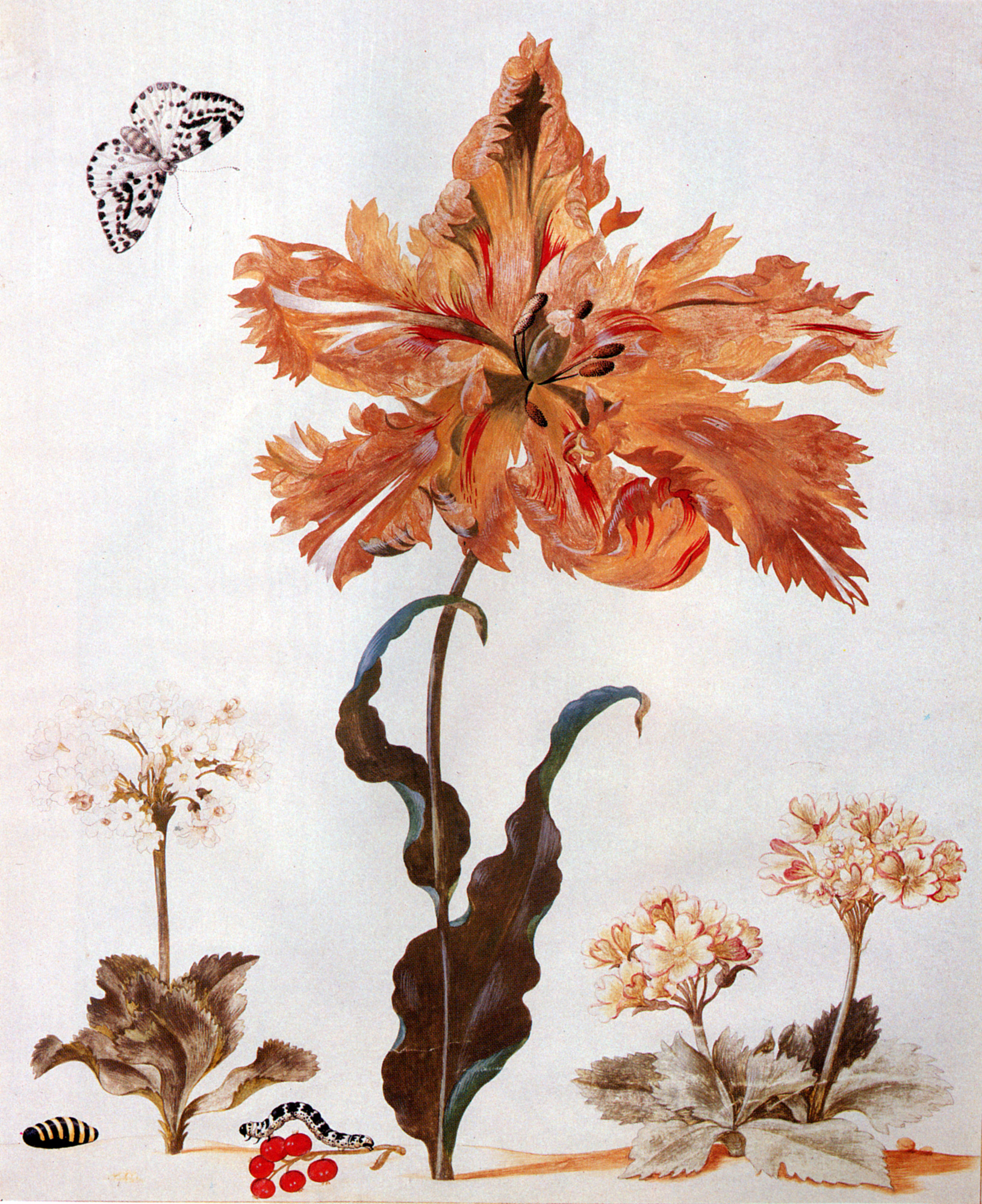
Courtesy: By Maria Sibylla Merian – https://www.wikiart.org/en/maria-sibylla-merian/a-parrot-tulip-auriculas-and-red-currants-with-a-magpie-moth-its-caterpillar-and-pupa, Public Domain, https://commons.wikimedia.org/w/index.php?curid=529292
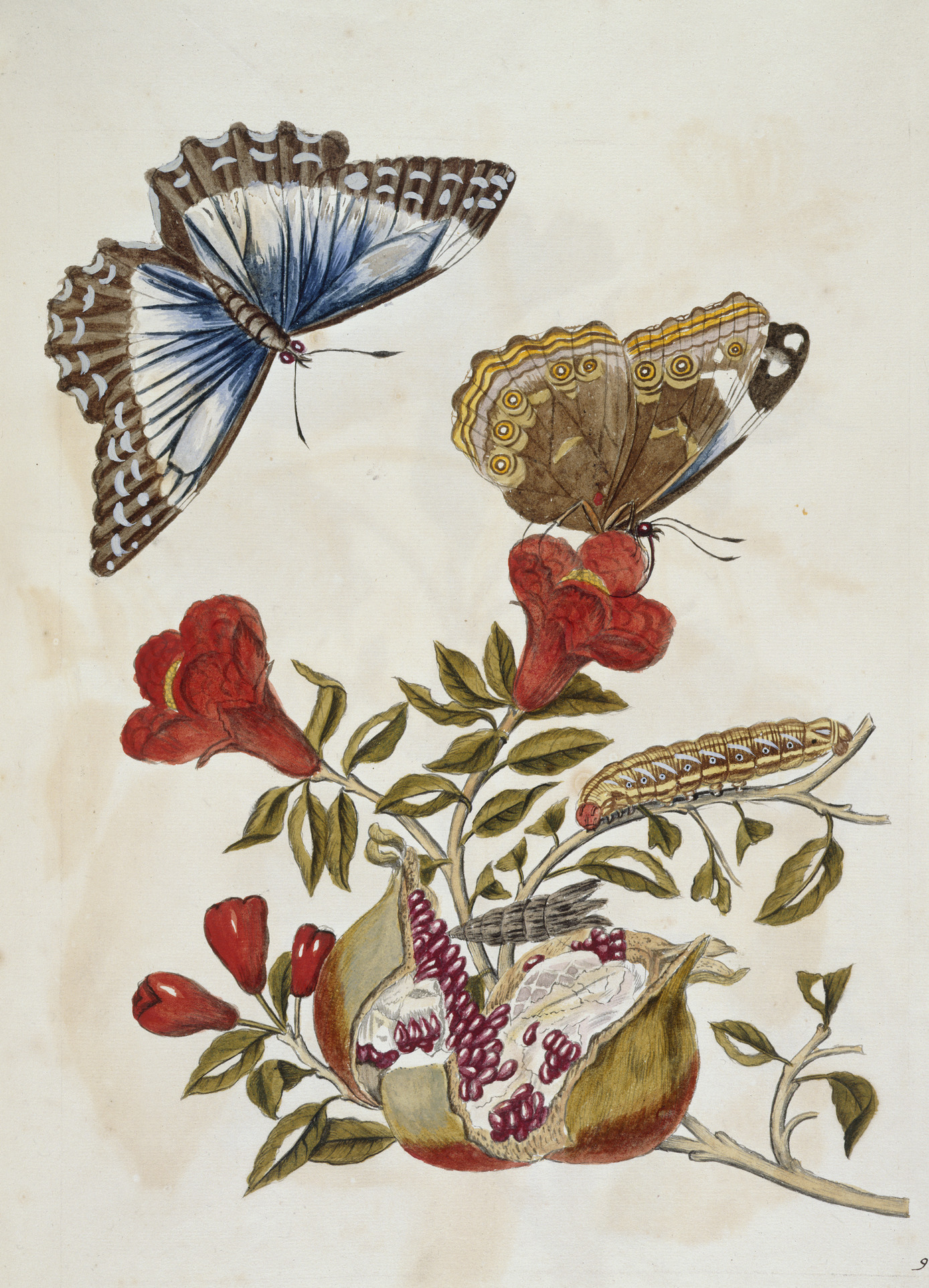
Courtesy: “Metamorphosis insectorum surinamensium – caption: ‘Butterfly and Caterpillar‘” by British Library has No known copyright restrictions.
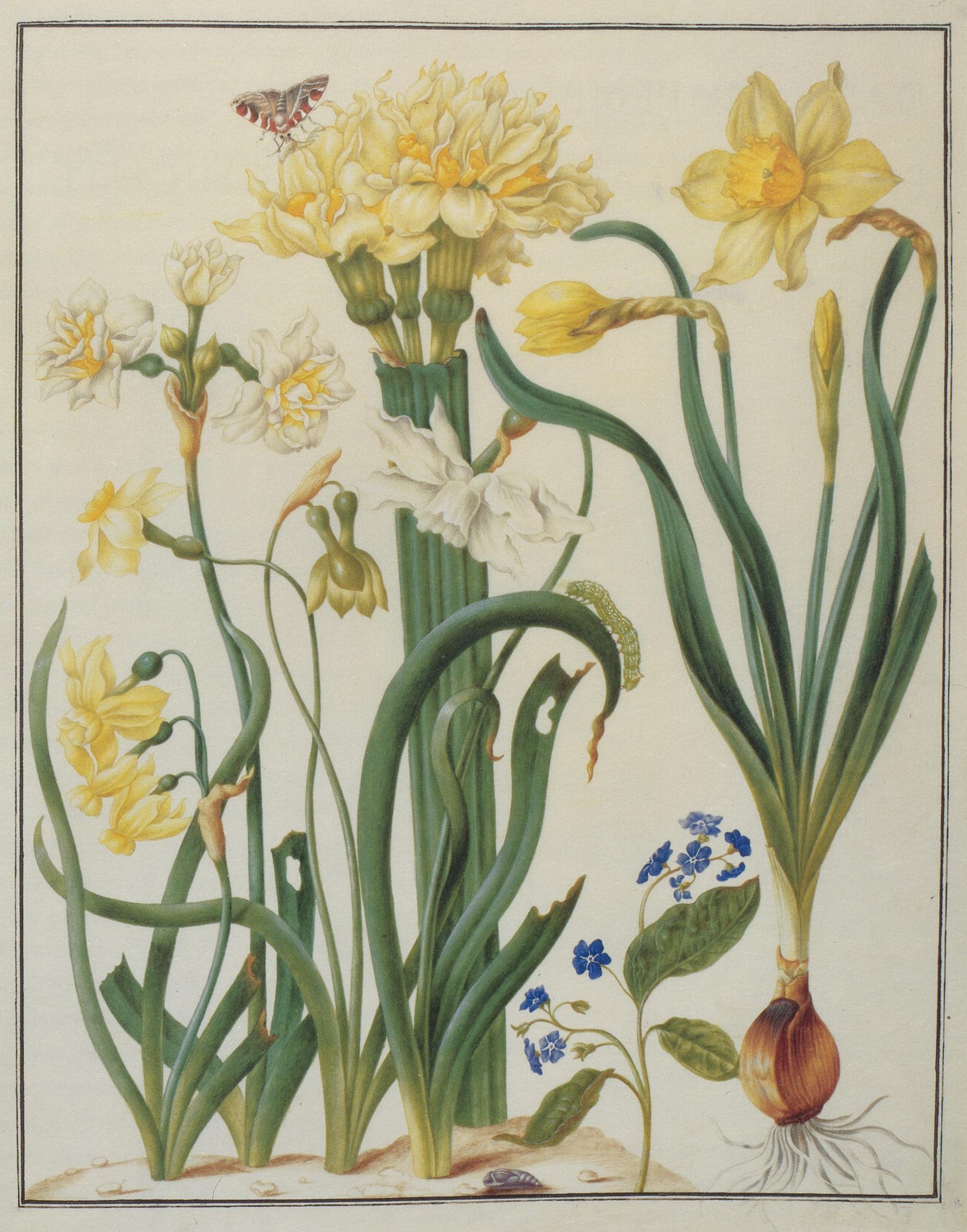
Courtesy: By Maria Sibylla Merian – Wettengl, Kurt (Hrsg.): Maria Sibylla Merian. 1647-1717. Künstlerin und Naturforscherin, Ostfildern 1997. S. 51, Taf. 25., Public Domain, https://commons.wikimedia.org/w/index.php?curid=116429858
Note about Maria Sibylla Merian
Maria Sibylla Merian was a Swiss -German naturalist and artist living and working in the seventeenth century. She excelled in both endeavors. One of her principal claims to fame is that she is one of the first naturalists to have studied insects. She recorded and illustrated the life cycles of 186 insect species. Her evidence documented the nature of metamorphosis and contradicted contemporary ideas about how insects developed. Her classification of butterflies and moths is still used today. She also undertook scientific expeditions at a time when these were unusual and normally undertaken by men only. She is best known for her illustrations of plants and insects made as a result of her trips to the tropical country of Suriname on the north eastern cost of South Americ. Merian is rated as being one of the greatest ever botanical artists.”
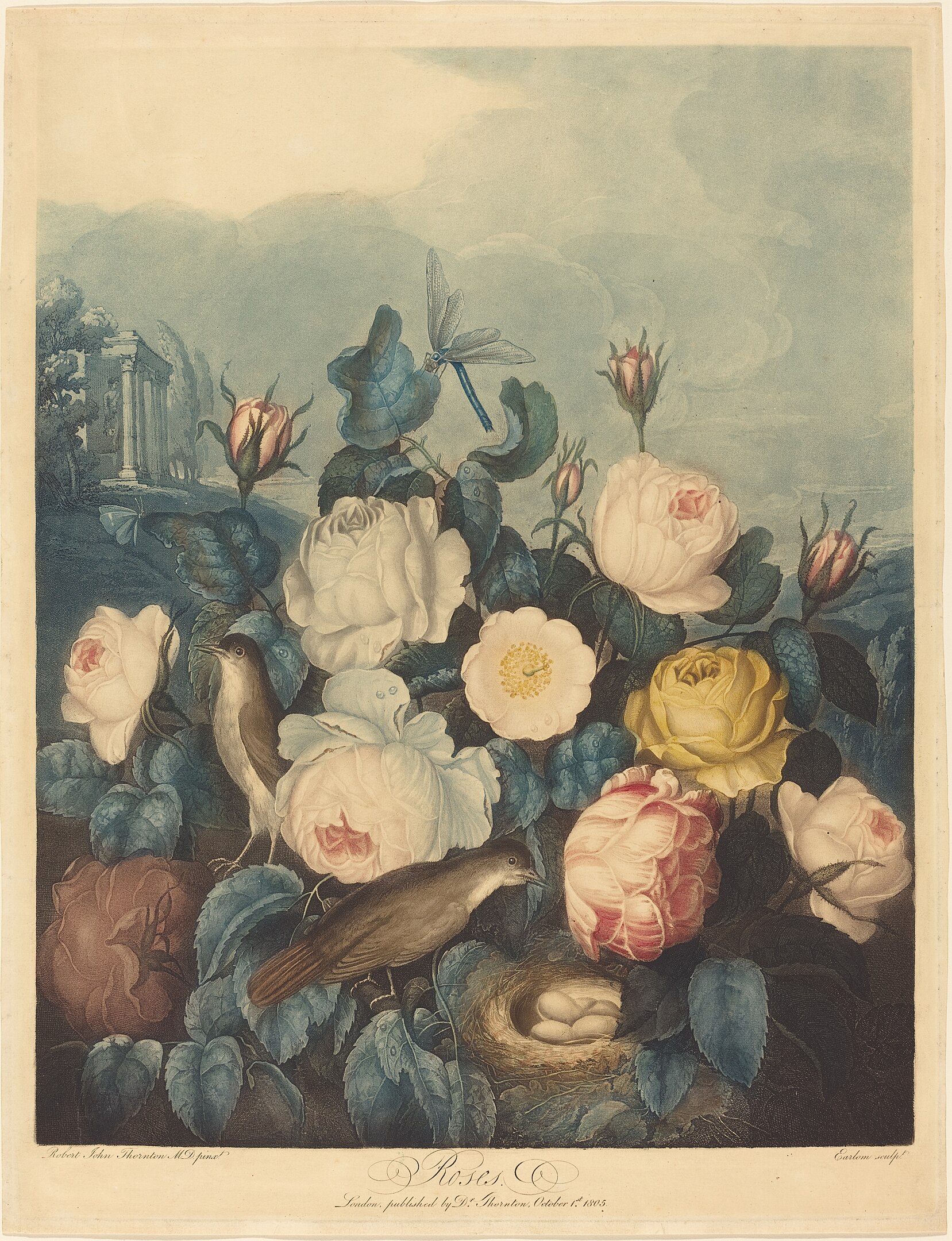
Courtesy: Gift of A. Thompson Ellwanger III in honor of Gregory E. Mescha. “https://www.nga.gov/collection/art-object-page.111966.html” is licensed under CC0 1.0.
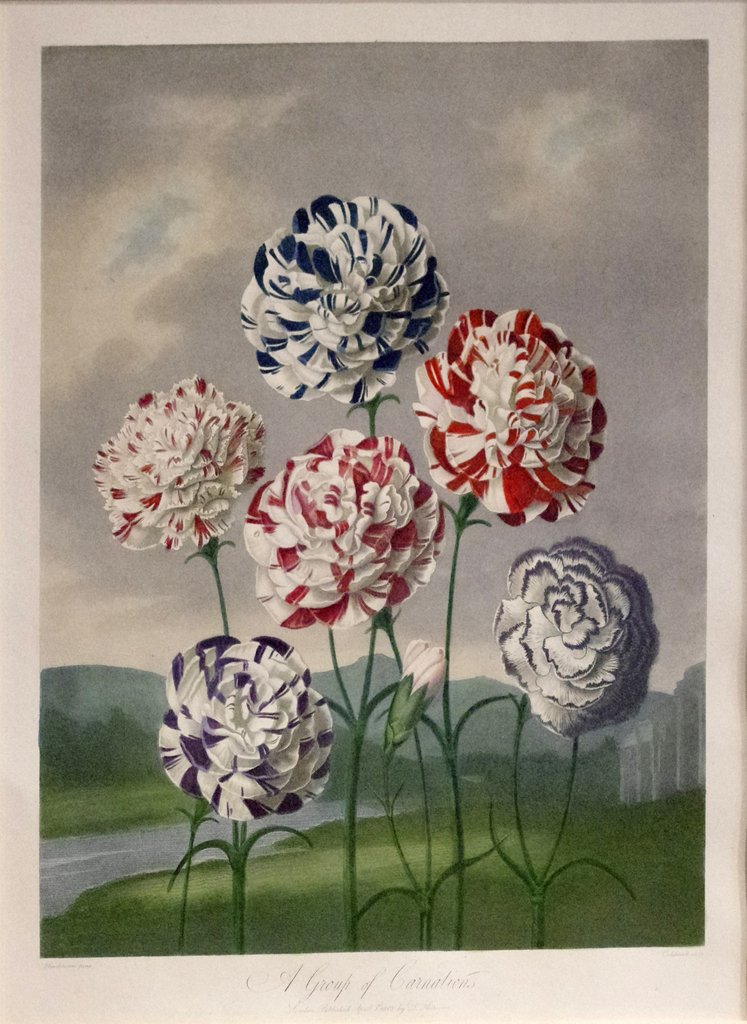
Courtesy: Public Domain, https://commons.wikimedia.org/w/index.php?curid=359196
“Carnations” by Theodore Roethke
Pale blossoms, each balanced on a single jointed stem,
And leaves curled back in elaborate Corinthian scrolls;
And the air cool, as if drifting down from wet hemlocks,
Or rising out of ferns not far from water,
A crisp hyacinthine coolness,
Like that clear autumnal weather of eternity,
The windless perpetual morning above a September cloud.
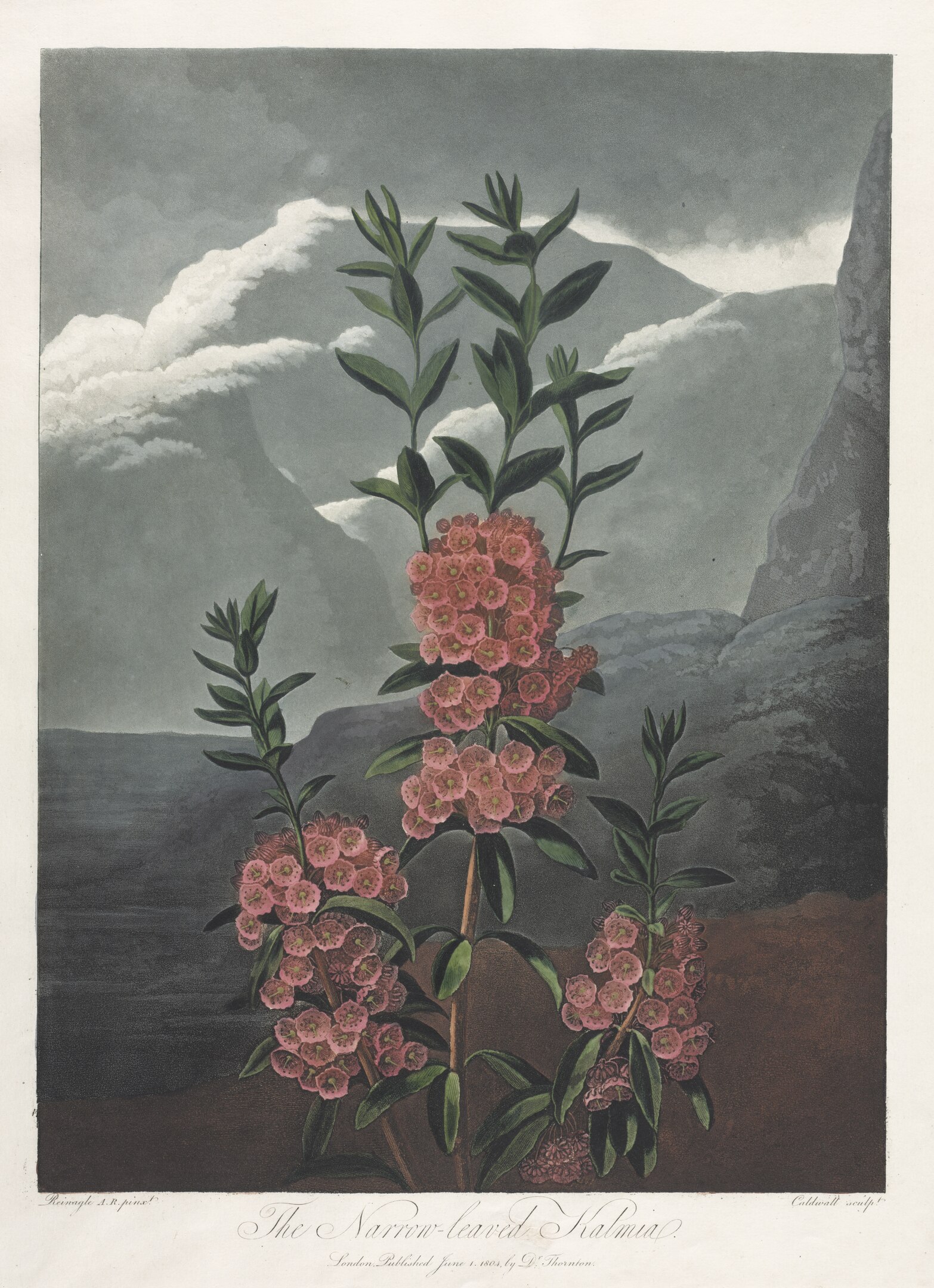
Courtesy: Gift of Robert Hays Gries. “https://www.clevelandart.org/art/1952.440” is licensed under CC0 1.0.
First published in 1799, The Temple of Flora featured the art of botanical painter Robert John Thornton.
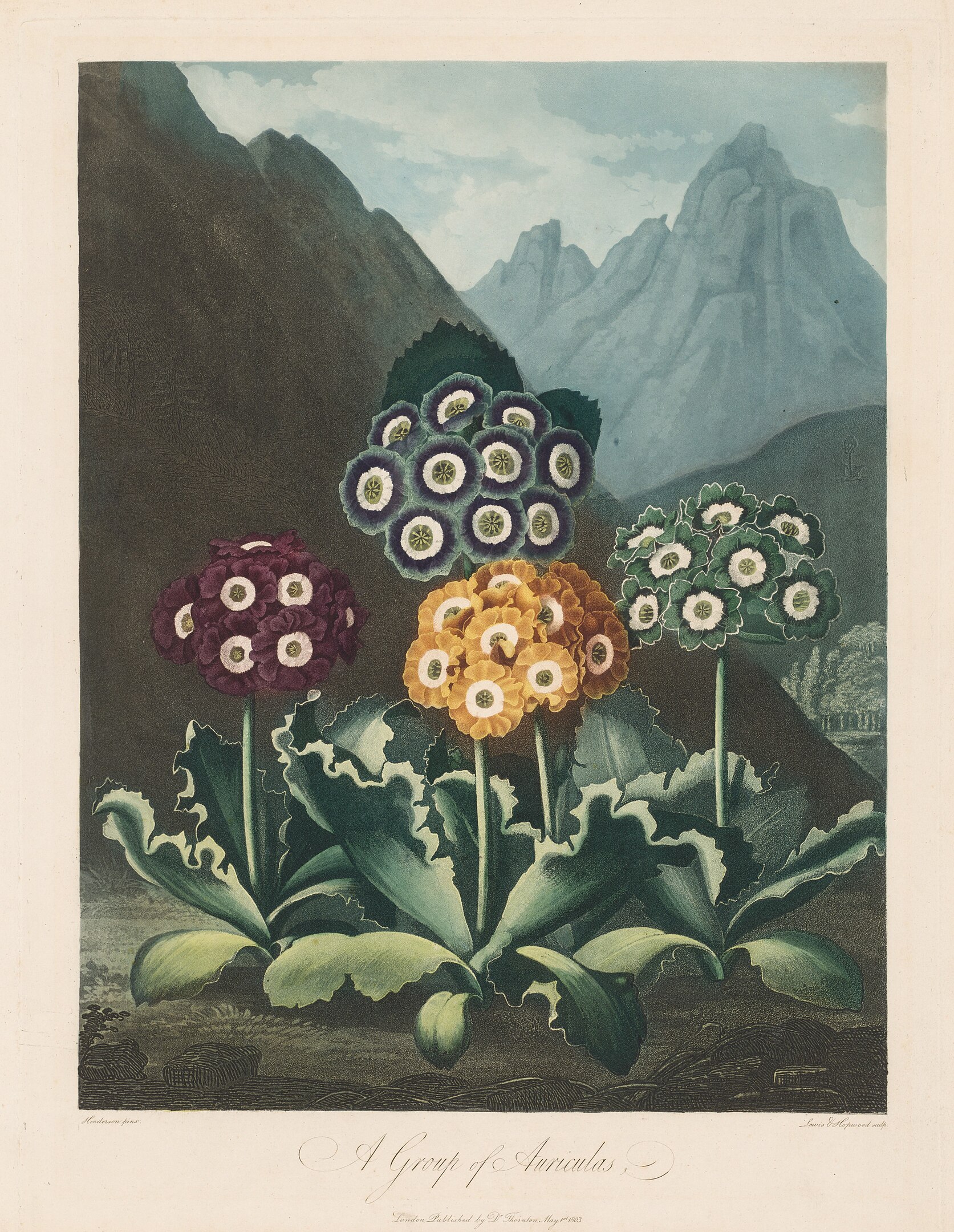
Courtesy: Gift of Robert Hays Gries. “https://www.clevelandart.org/art/1953.337” is licensed under CC0 1.0.
For more flower illustrations by Robert John Thornton please access The Internet Archives.
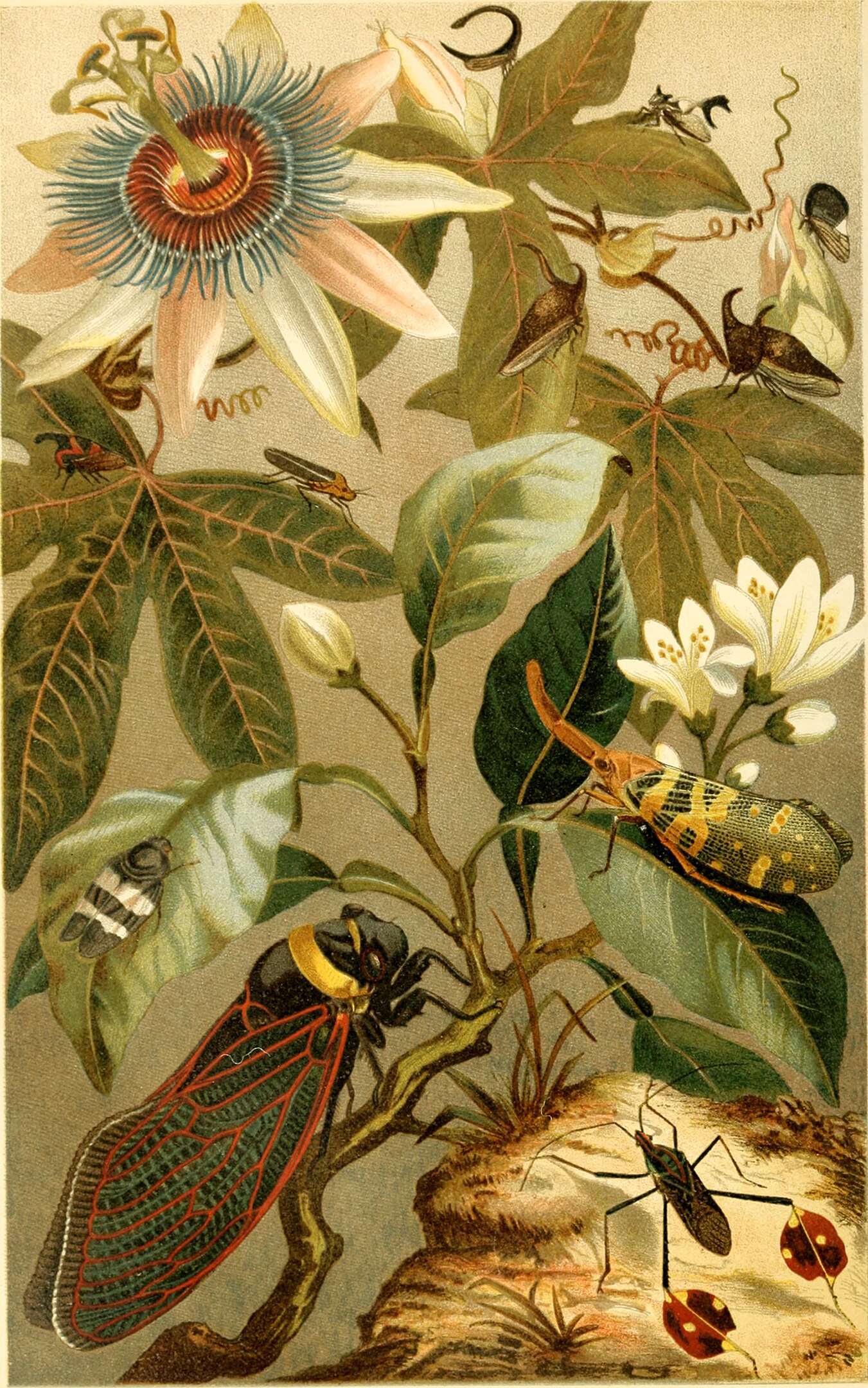
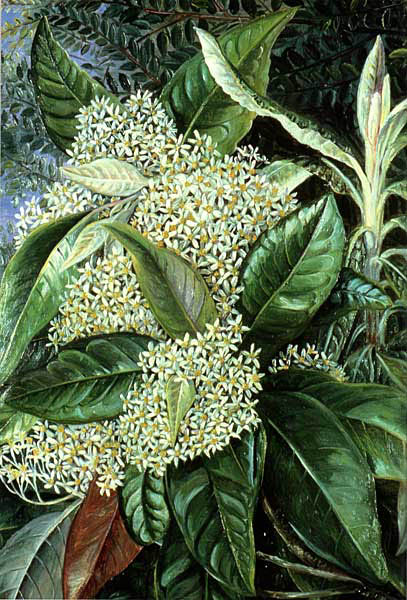
Courtesy: By Marianne North – http://www.anbg.gov.au/gallery/olearia-argophylla.html Australian National Botanic Gardens, Public Domain, https://commons.wikimedia.org/w/index.php?curid=3340800
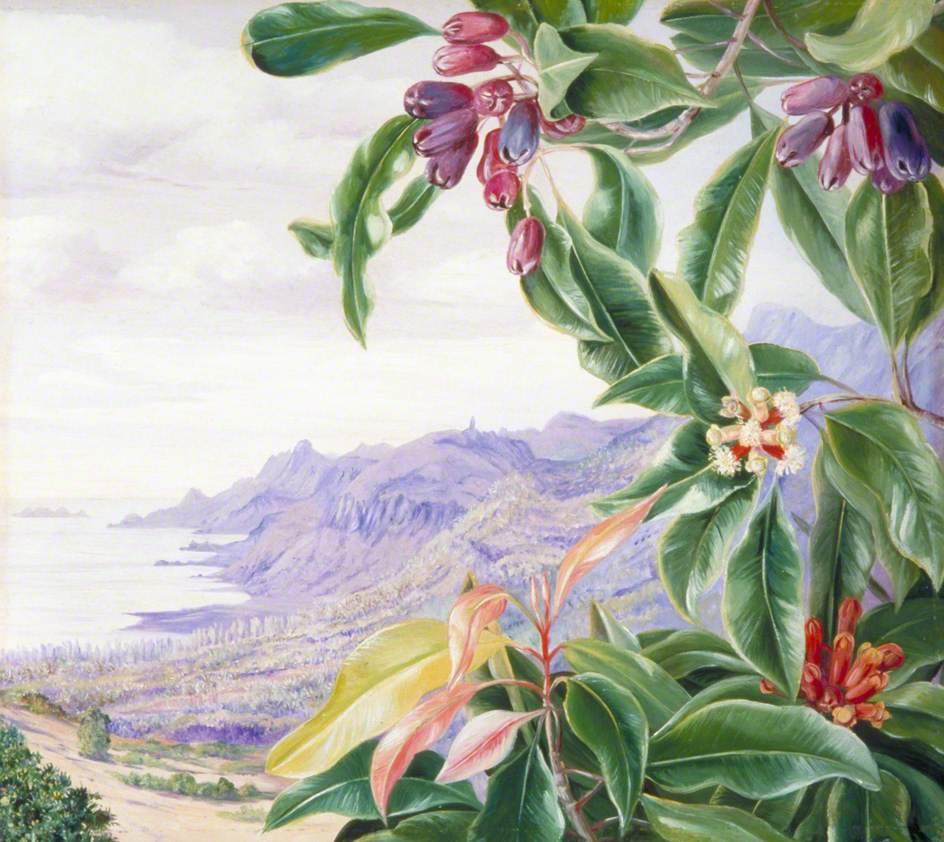
Courtesy: By Marianne North – Art UK, Public Domain, https://commons.wikimedia.org/w/index.php?curid=97541300
Additional Links
- The Gallery of Marianne North’s Paintings
- The New Botanic Garden
- To view more illustrations of bees and wasps by Hashini Marayama please open the Internet Archive link here.
- Why Bees are Important
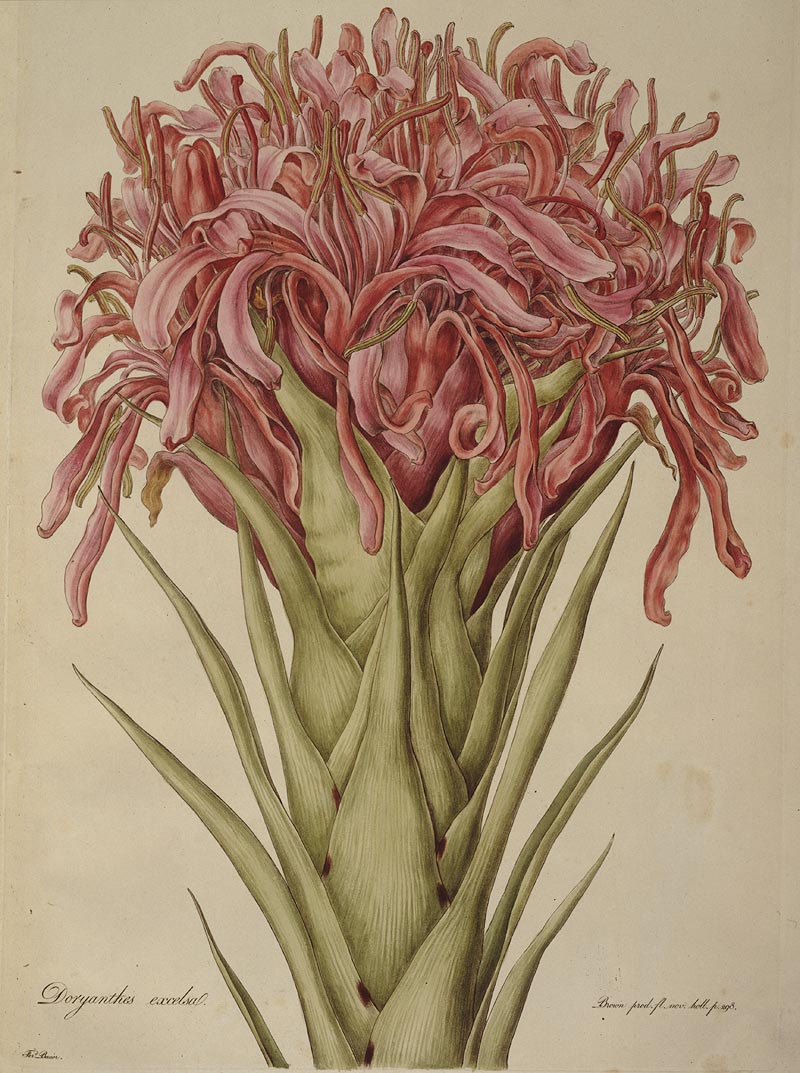
Courtesy: By Ferdinand Bauer (1760–1826) – It was obtained from the online catalogue of the State Library of New South Wales, here., Public Domain, https://commons.wikimedia.org/w/index.php?curid=2609355
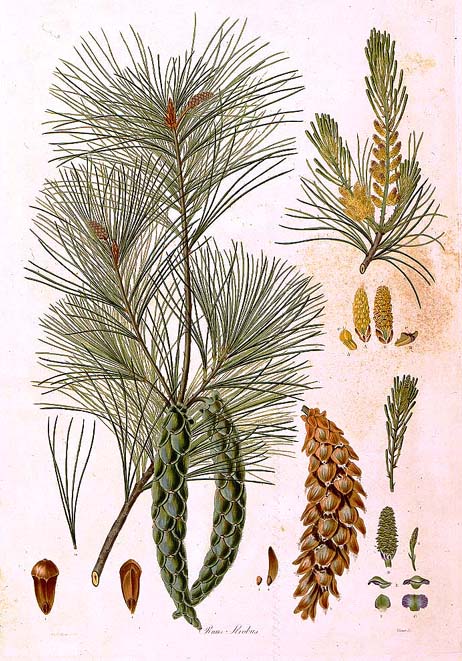
Courtesy: By Ferdinand Bauer – online exhibitions of the LuEsther T. Mertz Library [1]., Public Domain, https://commons.wikimedia.org/w/index.php?curid=2664581
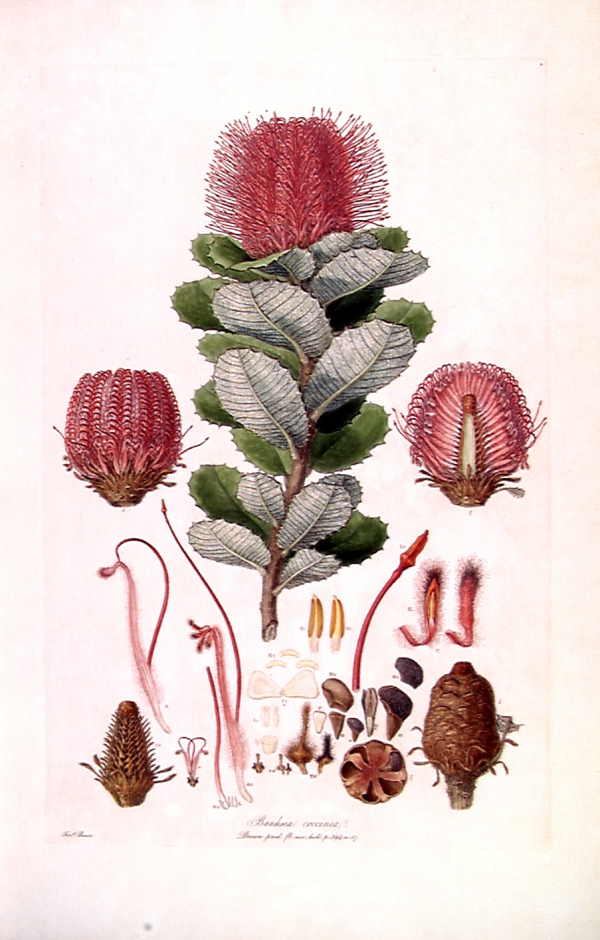
Courtesy: By Ferdinand Bauer (1760–1826) – It was obtained from the online catalogue of the State Library of Victoria, here., Public Domain, https://commons.wikimedia.org/w/index.php?curid=2609683
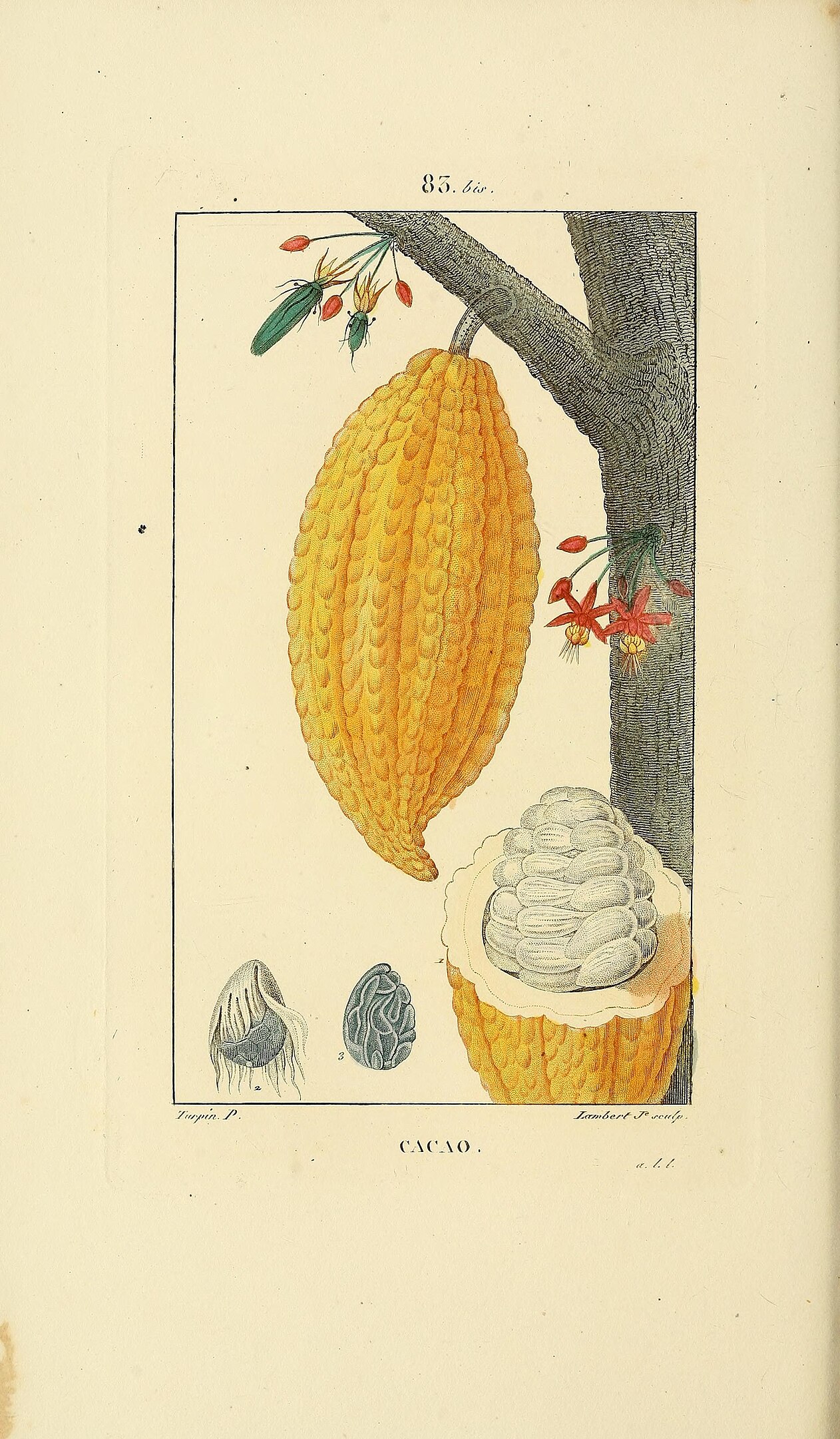
Resources
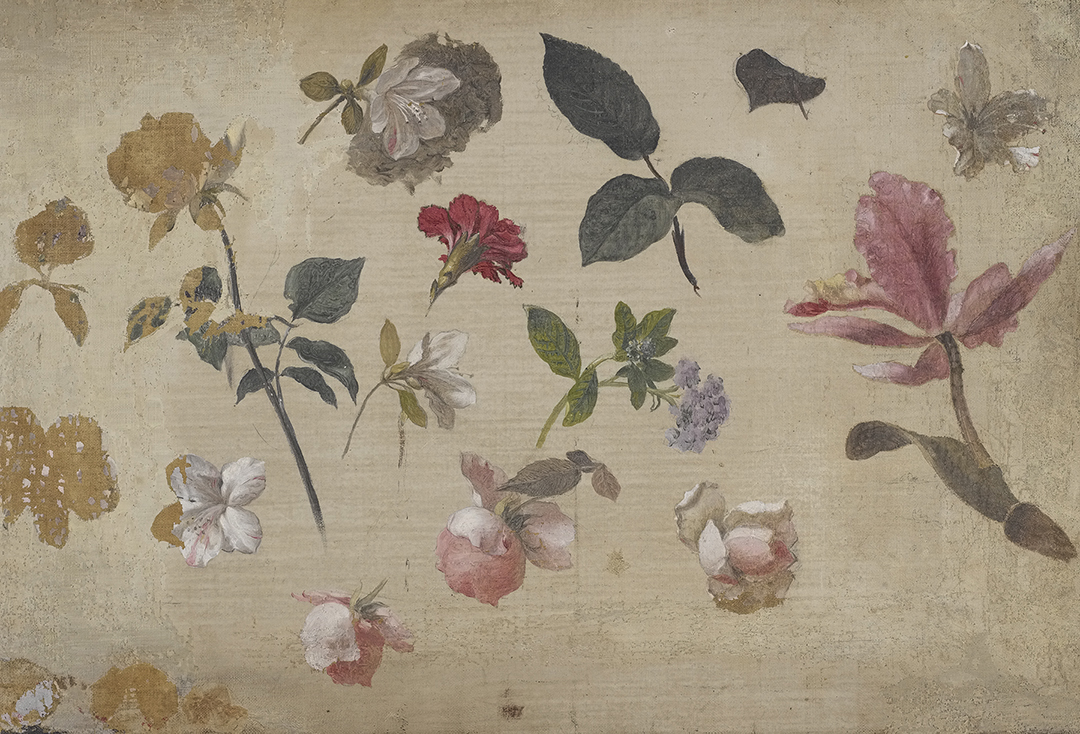
Courtesy: Crystal Bridges Museum of American Art, Bentonville, Arkansas, 2007.209. “https://crystalbridges.emuseum.com/objects/668/study-of-pink-roses-leaves-heliotrope-a-carnation-and-an?ctx=0519a0da62d9b0b16f6bb15afe15a710f9656152&idx=0” is licensed under CC0 1.0.
The Dramatic Art of Martin Johnson Heade
“Largely forgotten by scholars and collectors after his death, Martin Johnson Heade was one of the most varied and inventive painters of the 19th century. He is now recognized as one of the most important American artists of his generation and unique in devoting equal time to landscape, marine and still-life subjects. Heade created evocative marsh scenes and powerful canvases of dramatic thunderstorms at sea that established him as a landscapist. At the same time, he produced scintillating Victorian flower still lifes and exquisite studies of South American hummingbirds, explorations that would culminate in the extraordinary, wholly original combination of jewel-like birds with lush, tropical orchids.”
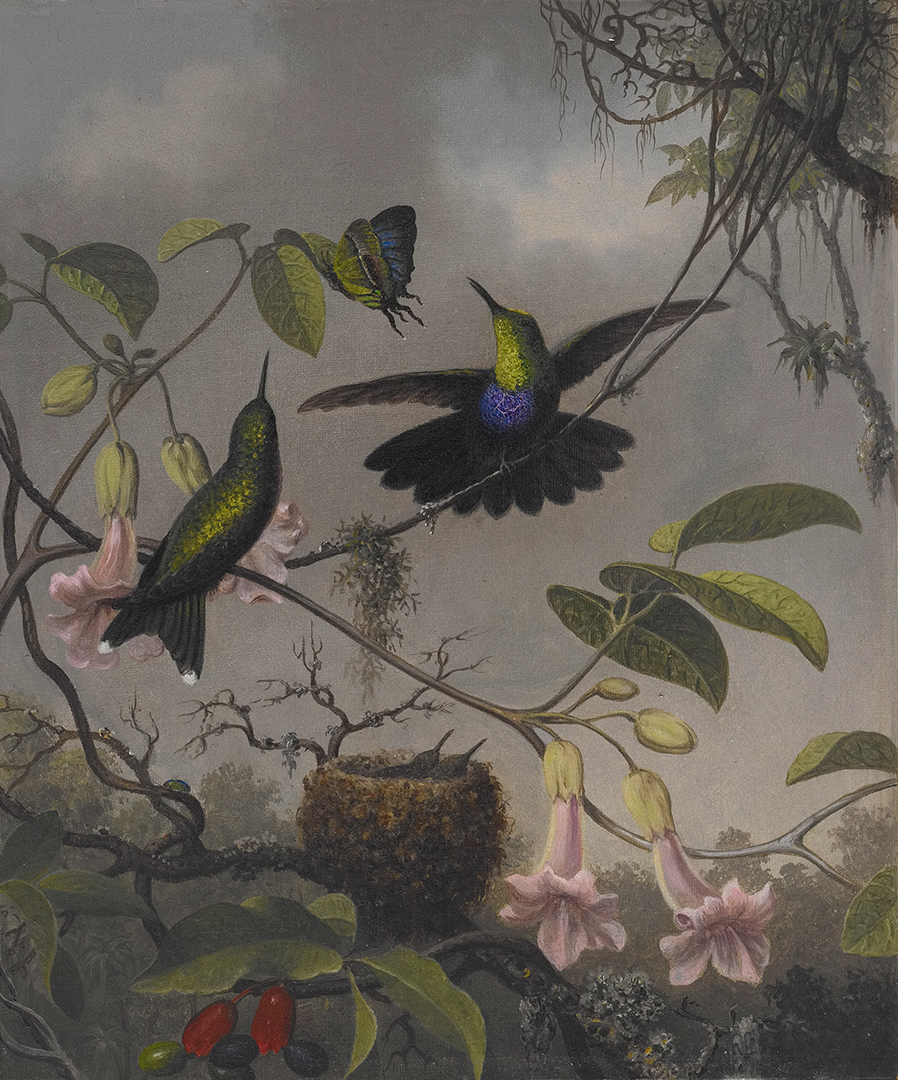
Courtesy: Crystal Bridges Museum of American Art, Bentonville, Arkansas, 2006.88. “https://crystalbridges.emuseum.com/objects/328/forktailed-woodnymph?ctx=ee085e7fc95ec576649b83d4e39dbcf92e87d91e&idx=0” is licensed under CC0 1.0.
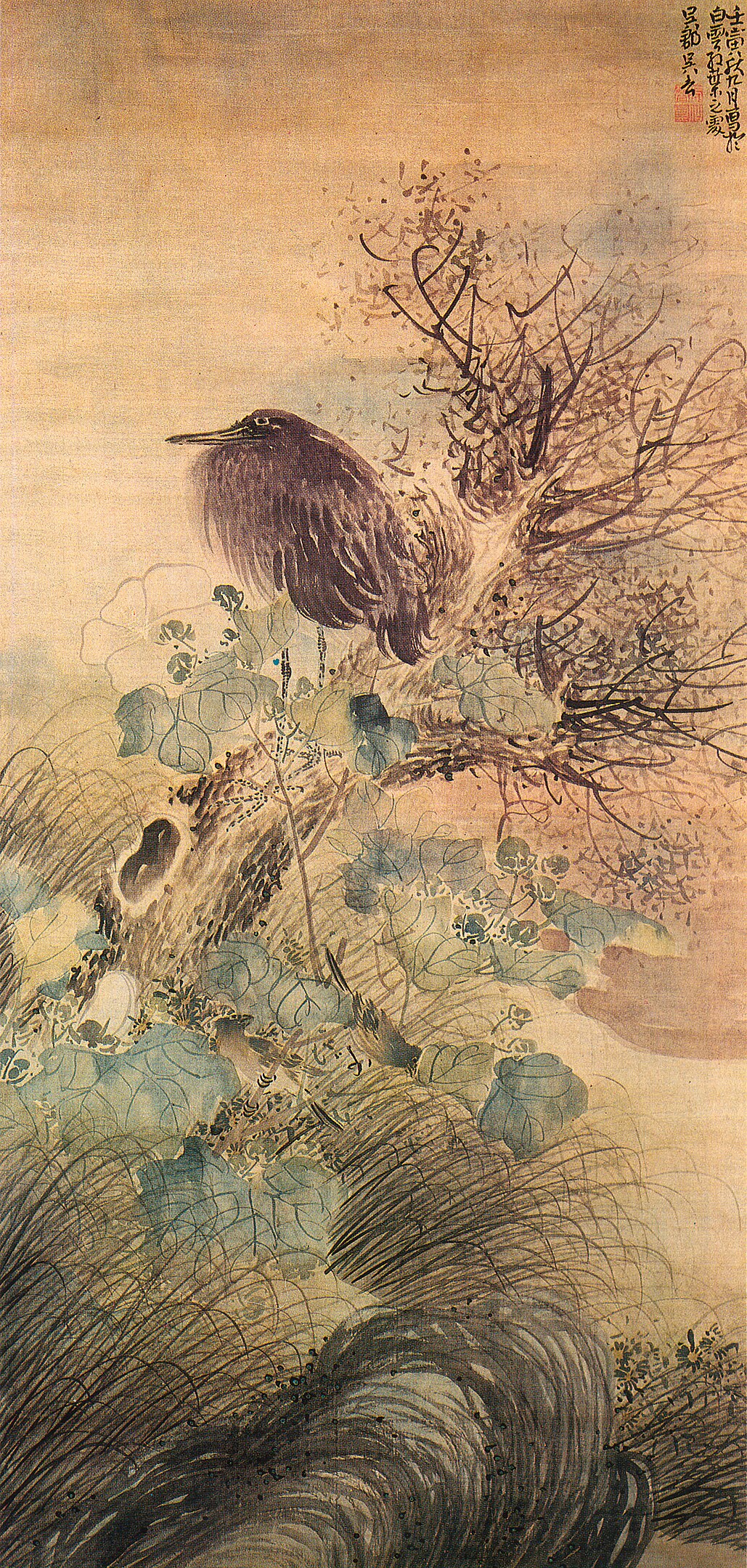
Courtesy: By Matsumura Goshun – The Great Japan Exhibition: Art of the Edo Period 1600-1868, ISBN:0297780352, Public Domain, https://commons.wikimedia.org/w/index.php?curid=2855761
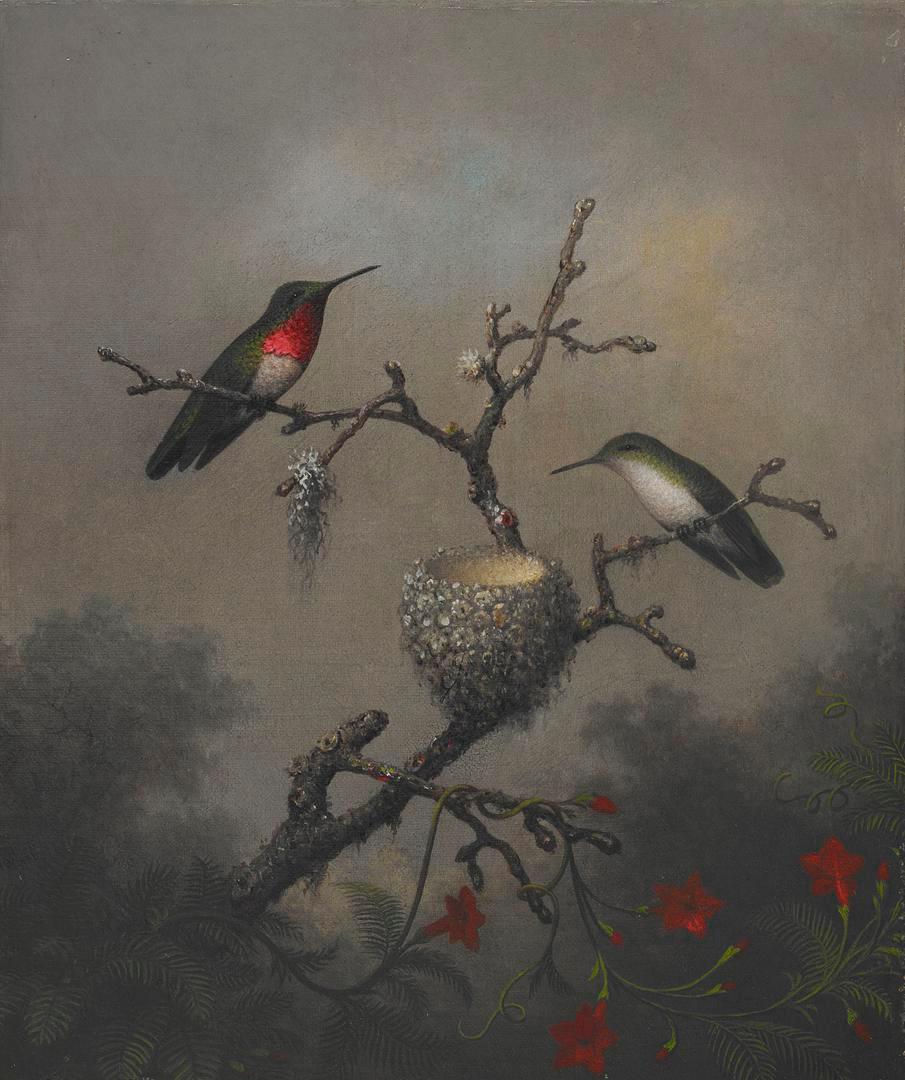
Courtesy: Crystal Bridges Museum of American Art, Bentonville, Arkansas, 2006.91. “https://crystalbridges.emuseum.com/objects/331/rubythroated-hummingbird?ctx=28bf659f722de44c9e4d025541d0bfd27fc194cb&idx=0” is licensed under CC0 1.0.
“No Bird” by Theodore Roethke
Now here is peace for one who knew
The secret heart of sound;
The ear so delicate and true
Is pressed to noiseless ground.
The grasses faintly stir;
But in this forest of the dead
No bird awakens her.
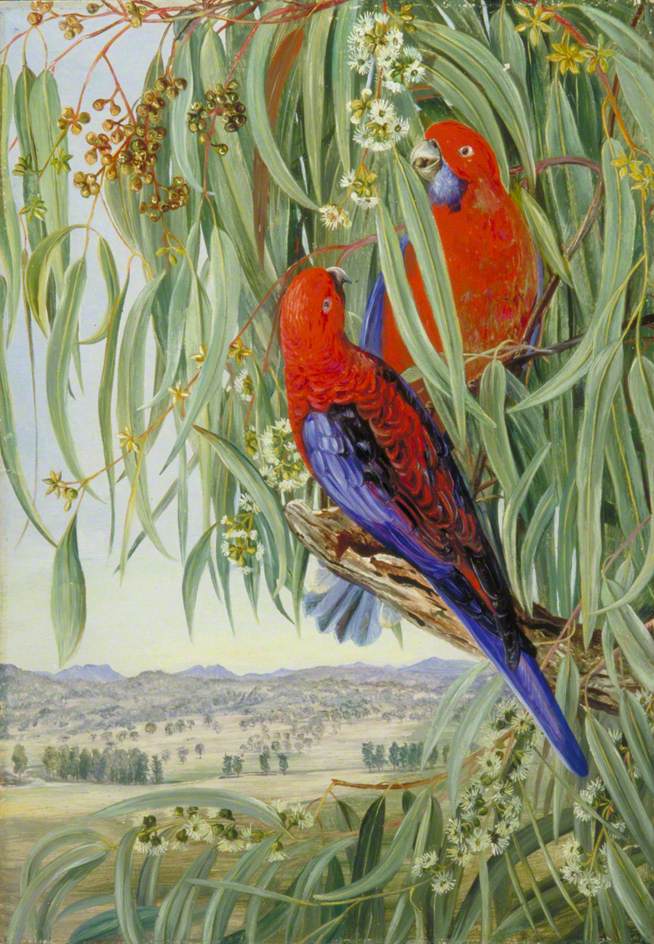
Courtesy: By Marianne North – Art UK, Public Domain, https://commons.wikimedia.org/w/index.php?curid=97435860
“Carnations” by Theodore Roethke
Pale blossoms, each balanced on a single jointed stem,
The leaves curled back in elaborate Corinthian scrolls;
And the air cool, as if drifting down from wet hemlocks,
Or rising out of ferns not far from water,
A crisp hyacinthine coolness,
Like that clear autumnal weather of eternity,
The windless perpetual morning above a September cloud.
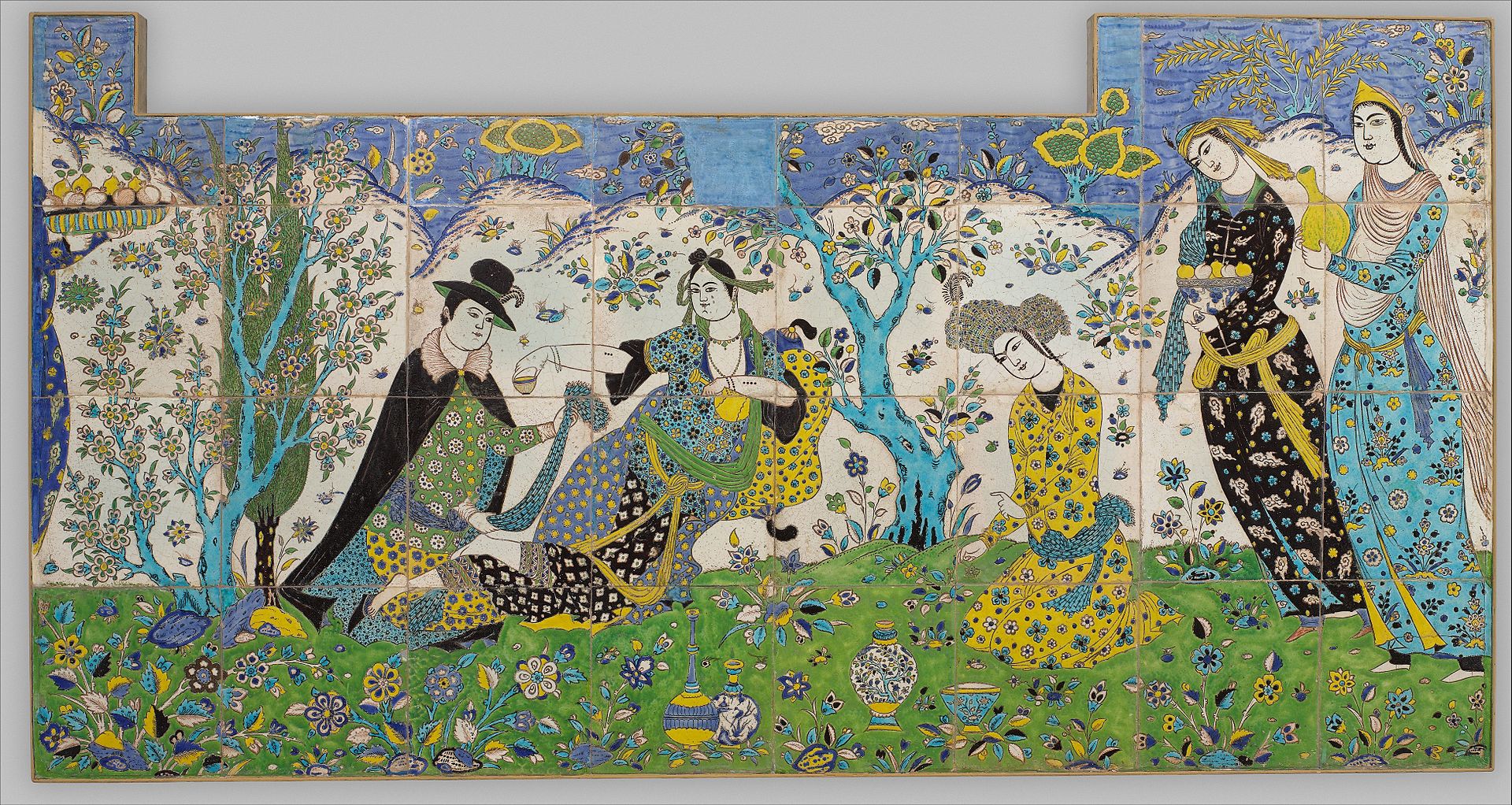
Courtesy: Rogers Fund, 1903. “https://www.metmuseum.org/art/collection/search/455082” is licensed under CC0 1.0.
Museum Note about the Painting
“At the center of this scene, a lady leans on a bolster pillow and languidly holds out a filled cup. Making somewhat immodest eye contact with the viewer, she displays burn marks, associated with mystics and lovers, on her lower arms. A male figure in European dress and hat, perhaps a merchant, kneels before her. The other figures offer refreshments and conversation.”
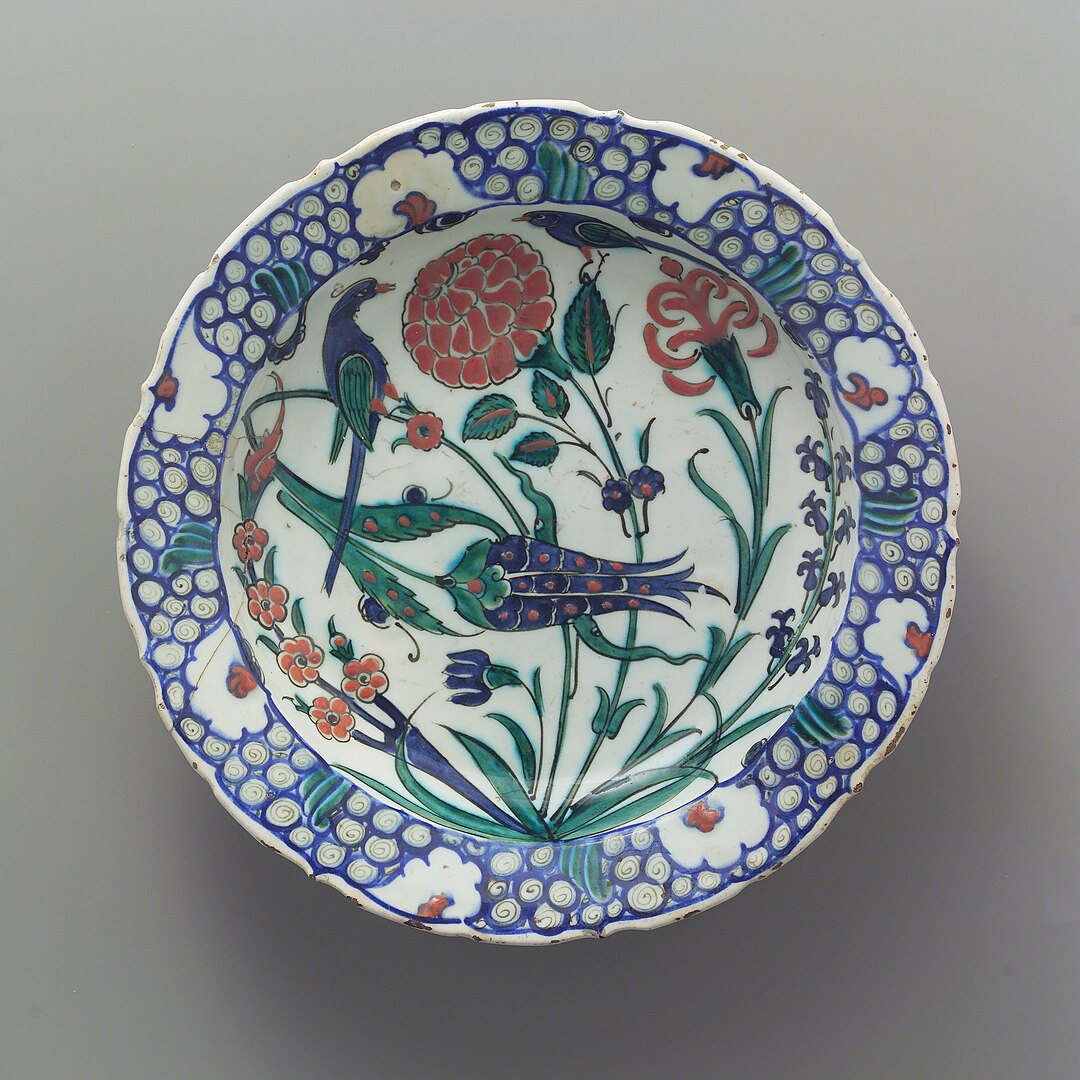
Courtesy: Gift of James J. Rorimer in appreciation of Maurice S. Dimand’s curatorship, 1933–1959, 1959. “https://www.metmuseum.org/art/collection/search/451490” is licensed under CC0 1.0.
“Two small birds are perched within the tangle of carnation, tulip, and hyacinth stems on this colorful plate. A popular literary Ottoman literary trope, bird and flower designs were a pervasive decorative element on Iznik pottery of the sixteenth and seventeenth centuries.”
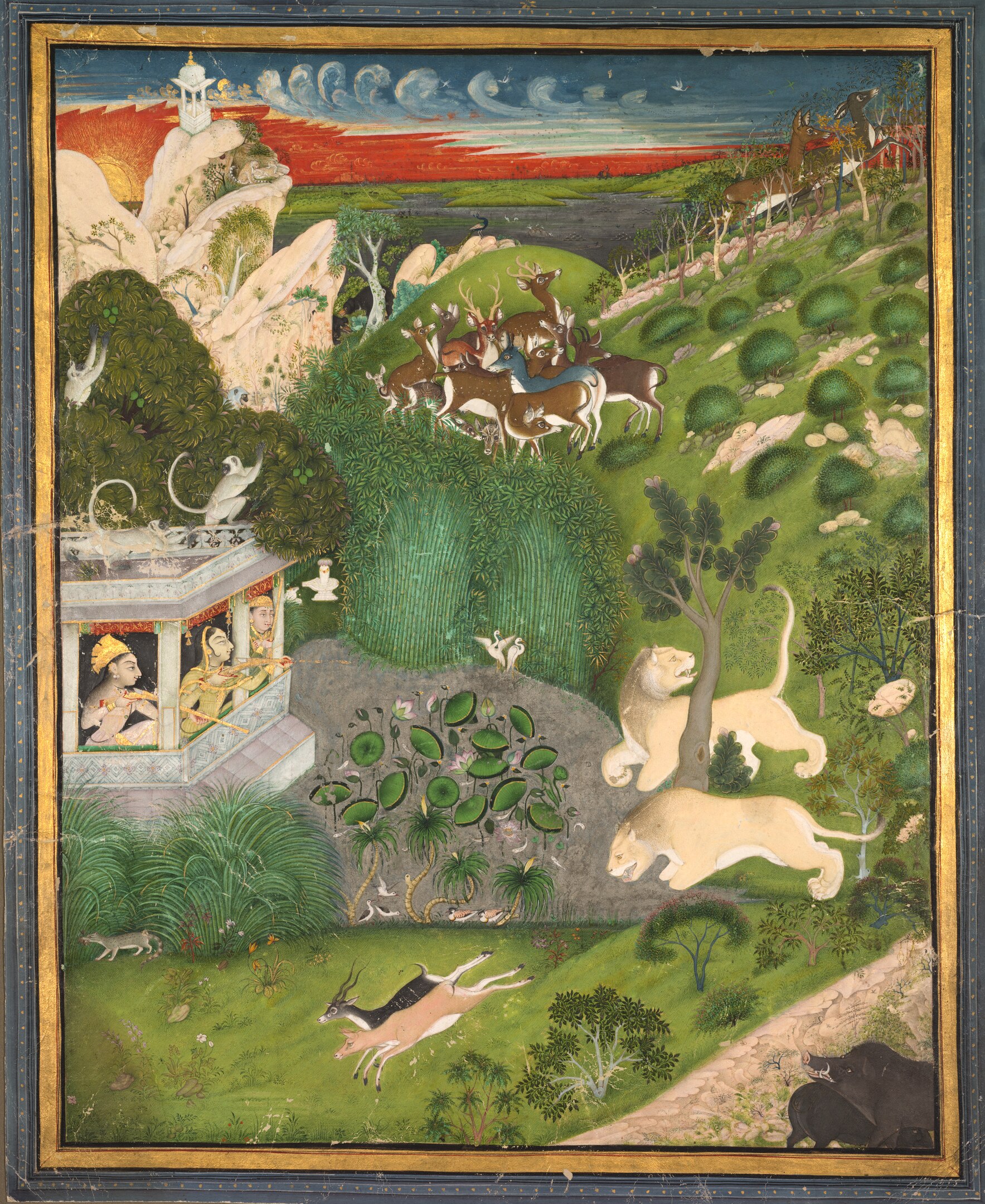
Courtesy: Purchase from the J. H. Wade Fund. “https://www.clevelandart.org/art/1955.48” is licensed under CC0 1.0.
Connections and Impressions
“There Will Come Soft Rains” by Sara Teasdale
(War Time)
There will come soft rains and the smell of the ground,
And swallows circling with their shimmering sound;
And frogs in the pools singing at night,
And wild plum trees in tremulous white,
Robins will wear their feathery fire
Whistling their whims on a low fence-wire;
And not one will know of the war, not one
Will care at last when it is done.
Not one would mind, neither bird nor tree
If mankind perished utterly;
And Spring herself, when she woke at dawn,
Would scarcely know that we were gone.
The Nature Poems of Theodore Roethke
Poets and novelists can be inspired by a painting or sculpture and likewise, a painter can describe a story in richly detailed ways that highlight new insights and understandings. Poems by Theodore Roethke (1908-1963) reflect an intermediary world as we travel through waking and sleeping. Roethke’s poem addresses existential themes that challenge readers to explore the delicate balance and interplay between our waking world, the world of nature, the world of work, the world of contemplation. The transitory world of life and the cycles and seasons of nature reflect our own inner spiritual journeys. Roethke’s poems illuminate sacred landscapes; the visual imagery in his poems enable us to imagine an idyllic place of peace and contemplation. Each flower, each root, each plant, or vine is a microcosm of life. Joy Harjo writes that “each (Roethke) poem is constructed of lines, of rhythms, and words that are sounds. Each poem is full of energy There’s form and there’s shape, like a house or a jukebox. Some formsare of contemporary design, like fee verse. “The Waking” is in an old French form, the villanelle. The form has to fit the content. The content needs a place to live.” (Harjo, in Paschen and Mosby, C. 2001 p. 181).
“Genesis” by Theodore Roethke
This elemental force
Was wrested from the sun;
A river’s leaping source
Is locked in narrow bone.
This wisdom floods the mind,
Invades quiescent blood;
A seed that swells the rind
To burst the fruit of good.
A pearl within the brain
Secretion of the sense,
Around a central grain
New meaning grows immense.
(from: The collected poems of Theodore Roethke, p. 17, Anchor Books, 1975).
“Self-Reliance” by Ralph Waldo Emerson
“Man is his own star, and the soul that can
Render an honest and a perfect man,
Commands all light, all influence, all fate;
Nothing to him falls early or too late.
Our acts our angels are, or good or ill,
Our fatal shadows that walk by us still….”
“Moving Forward” by Rainer Maria Rilke
The deep parts of my life pour onward,
as if the river shores were opening out.
It seems that things are more like me now,
That I can see farther into paintings.
I feel closer to what language can’t reach.
With my senses, as with birds, I climb
into the windy heaven, out of the oak,
in the ponds broken off from the sky
my falling sinks, as if standing on fishes
“The Far Field” by Theodore Roethke
I dream of journeys repeatedly:
Of flying like a bat deep into a narrowing tunnel,
Of driving alone, without luggage, out a long peninsula,
The road lined with snow-laden second growth,
A fine dry snow ticking the windshield,
Alternate snow and sleet, no on-coming traffic,
And no lights behind, in the blurred side-mirror,
The road changing from glazed tarface to a rubble of stone,
Ending at last in a hopeless sand-rut,
Where the car stalls,
Churning in a snowdrift
Until the headlights darken.
Landscapes with Trees
As you view the following landscapes, you can explore some of these questions:
- What is your relationship to nature? What values does your connection to nature represent to you?
- How is the artist portraying the natural scenery that might include mountains, valleys, skies, clouds, trees, rivers, and forests?
- Some of the artists depict animals in their natural habitat. How have the habitats of many animals
- Is the landscape more realistic or imaginary?
- To what extent was “nature” viewed as something frightening and that needed to be controlled or destroyed? How have different attitudes towards nature impacted ecosystems?
- How do the artists and writers evoke mood and emotion through their work?
- Do any of the landscape images evoke memories that you have of similar places?
- How are colours used to create emotions?
- How do poets use symbolism and imagery to evoke emotion?
- Is the artist portraying a particular season of the year (spring, summer, autumn, winter)?
- How have our geographical landscapes changed over time? What factors contributed to these changes (e.g. erosion, climate change, industrialization, etc.).
- To what extent are natural landscapes threatened today?
- How do we repair the damage and build resilient ecosystems?
- How do we mobilize individuals to take a greater initiative in sustainability?
For additional resources please click on the links below:
The Power of Nature: Nature Conservancy
Manitoba Education Curriculum Links:
“Education for Sustainable Development involves incorporating key themes of sustainable development – such as poverty alleviation, human rights, health and environmental protection, climate change – into the education system. ESD is a complex and evolving concept and requires learning about key themes from a social, cultural, environmental and economic perspective and explores how those factors are inter-related and inter-dependent. The Venn diagram below represents the inter-relationship of the themes” (Manitoba Education)
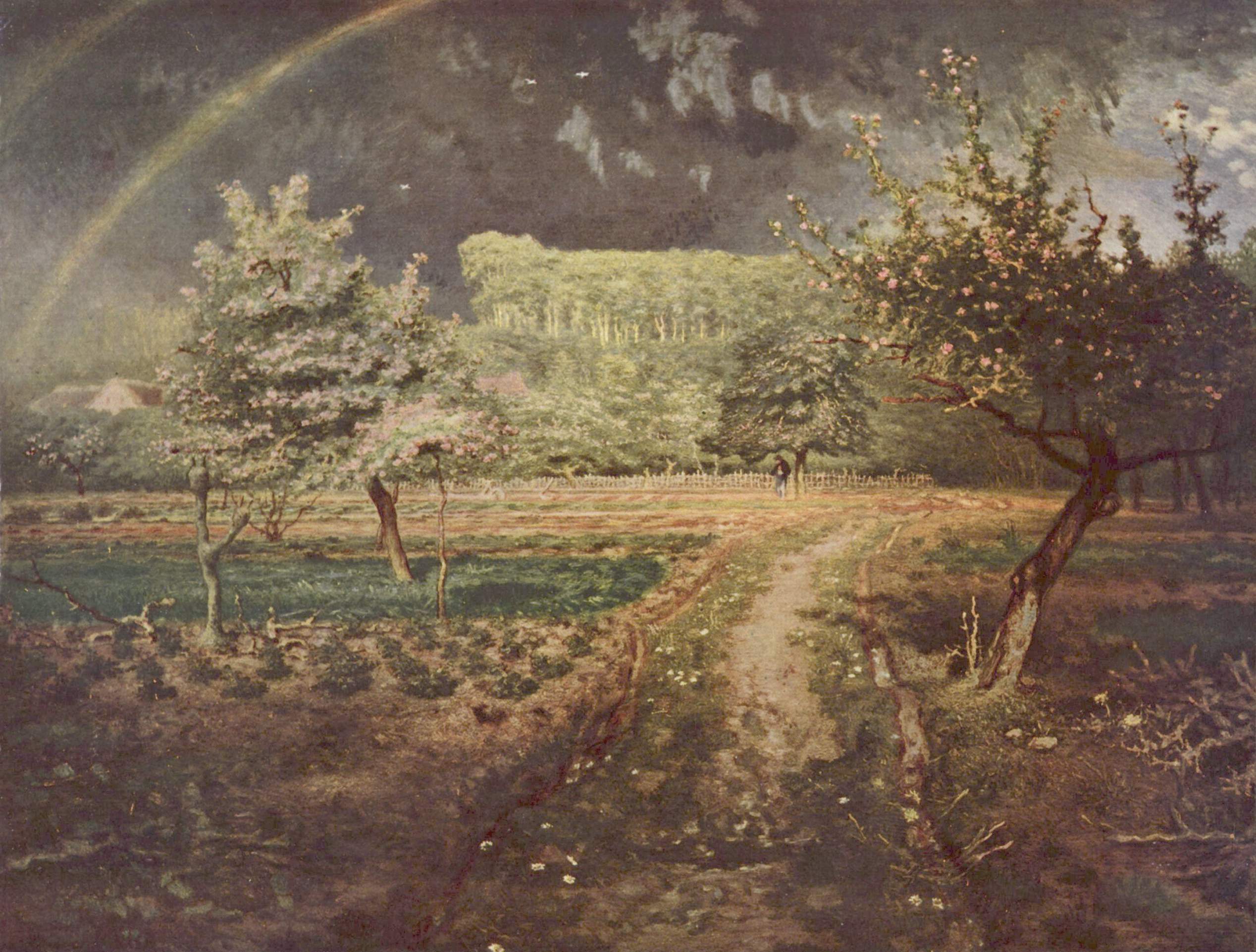
Courtesy: By Jean-François Millet – The Yorck Project (2002) 10.000 Meisterwerke der Malerei (DVD-ROM), distributed by DIRECTMEDIA Publishing GmbH. ISBN: 3936122202., Public Domain, https://commons.wikimedia.org/w/index.php?curid=155686
“A Birthday” by Christina Rossetti
My heart is like a singing bird
Whose nest is in a watered shoot;
My heart is like an apple-tree
Whose boughs are bent with thick-set fruit;
My heart is like a rainbow shell
That paddles in a halcyon sea;
My heart is gladder than all these
Because my love is come to me.
Raise me a dais of silk and down;
Hang it with vair and purple dyes;
Carve it in doves and pomegranates,
And peacocks with a hundred eyes;
Work it in gold and silver grapes,
In leaves and silver fleurs-de-lys;
Because the birthday of my life
Is come, my love is come to me.
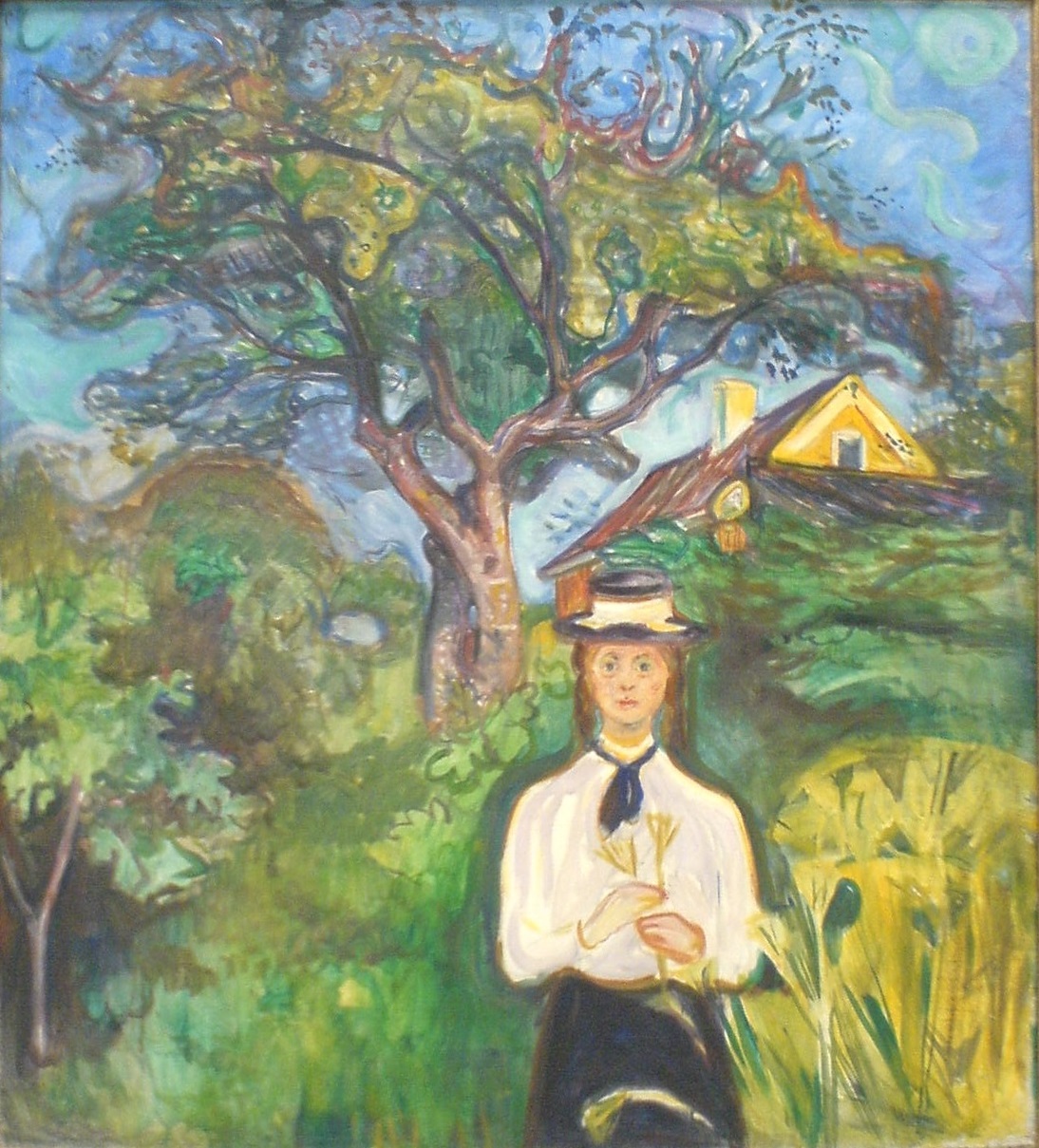
Courtesy: By Edvard Munch – Photo of painting in Carnegie Museum, Pittsburgh, Public Domain, https://commons.wikimedia.org/w/index.php?curid=76959979
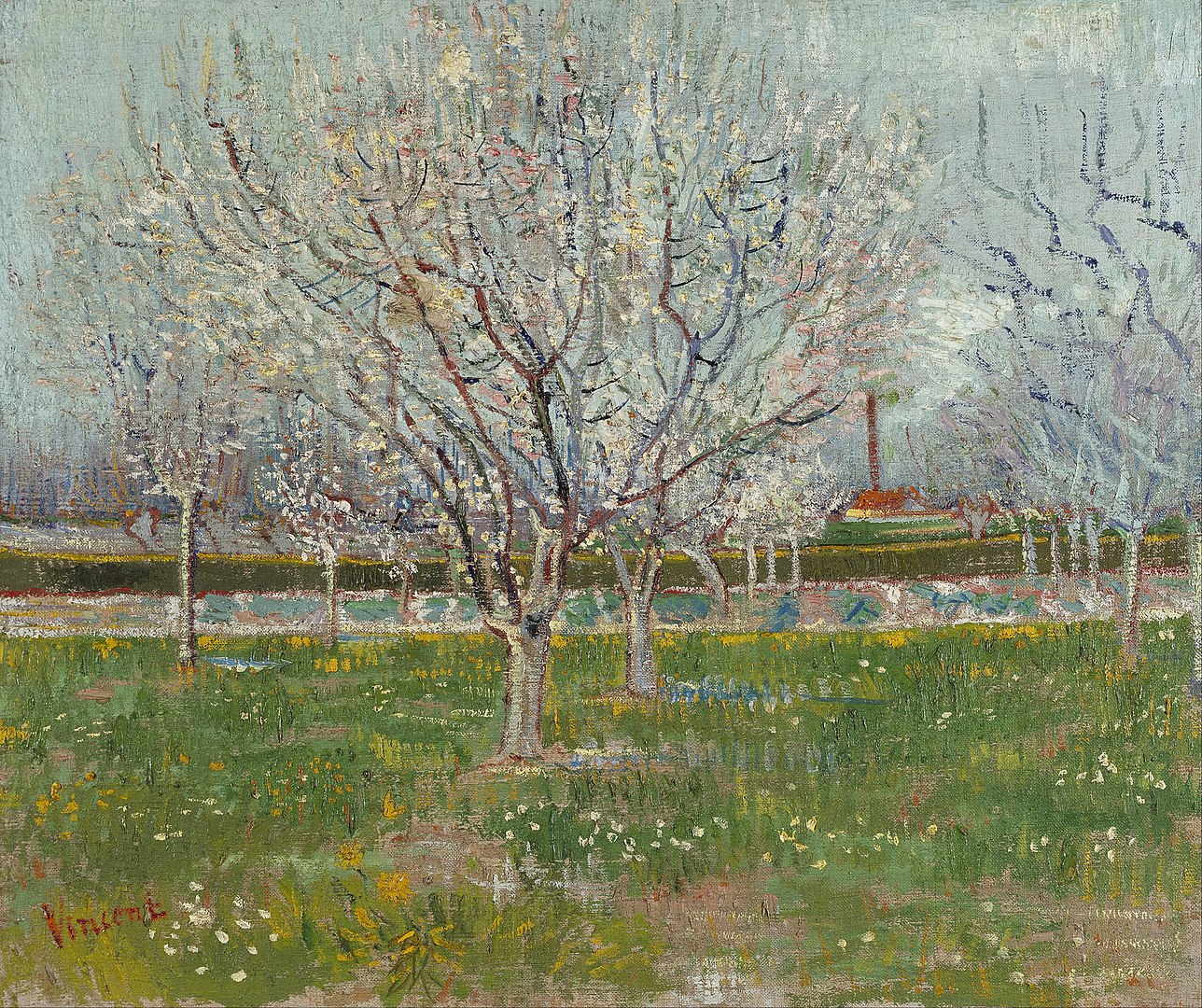
Courtesy: Presented by Sir Alexander Maitland in memory of his wife Rosalind 1960. Artwork photographed by Antonia Reeve. “https://www.nationalgalleries.org/art-and-artists/4973” is licensed under CC BY-NC 3.0.
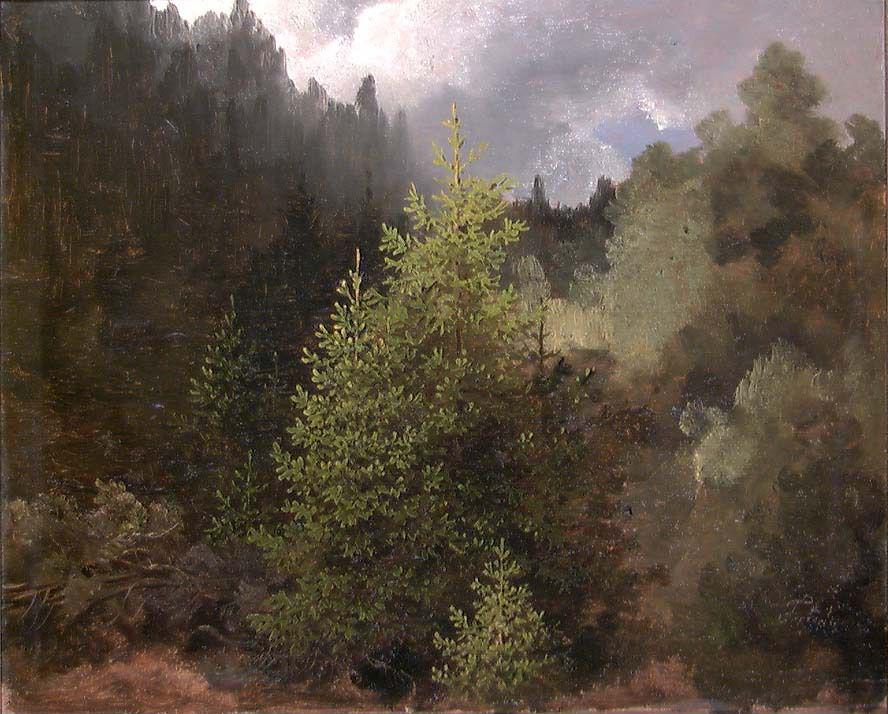
Courtesy: Nasjonalmuseet for kunst, arkitektur og design, The Fine Art Collections. “https://www.nasjonalmuseet.no//en/collection/object/NG.M.04174” is licensed under CC BY 4.0.
“The Trees’ Counselling” by Christina Rossetti
I was strolling sorrowfully
Thro’ the corn fields and the meadows;
The stream sounded melancholy,
And I walked among the shadows;
While the ancient forest trees
Talked together in the breeze;
In the breeze that waved and blew them,
With a strange weird rustle thro’ them.
Said the oak unto the others
In a leafy voice and pleasant:
“Here we all are equal brothers,
“Here we have nor lord nor peasant.
“Summer, Autumn, Winter, Spring,
“Pass in happy following.
“Little winds may whistle by us,
“Little birds may overfly us;
“But the sun still waits in heaven
“To look down on us in splendour;
“When he goes the moon is given,
“Full of rays that he doth lend her:
“And tho’ sometimes in the night
“Mists may hide her from our sight,
“She comes out in the calm weather,
“With the glorious stars together.”
From the fruitage, from the blossom,
From the trees came no denying;
Then my heart said in my bosom:
“Wherefore art thou sad and sighing?
“Learn contentment from this wood
“That proclaimeth all states good;
“Go not from it as it found thee;
“Turn thyself and gaze around thee.”
And I turned: behold the shading
But showed forth the light more clearly;
The wild bees were honey-lading;
The stream sounded hushing merely,
And the wind not murmuring
Seemed, but gently whispering:
“Get thee patience; and thy spirit
“Shall discern in all things merit.”
The Ancient Life of Trees: Necessary for a Post-Human Era
New York Times Excerpt (Dr. Jared Farmer, 2022, Elderflora: A Modern History of Ancient Trees.” Basic Books, 2022.)
Whole forests with fire-resistant giant sequoias up to 3,000 years in age have recently gone up in flames. Whole stands of drought-resistant Great Basin bristlecone pine, a species that can reach 5,000 years in age, have been sucked dry by bark beetles. Monumental baobabs, the longest-living flowering plants, buckle under the stress of drought in southern Africa. The iconic cedars of Mount Lebanon, ancient symbols of longevity, struggle in warmer, drier conditions. Millennial kauris in New Zealand and centenarian olive trees in Italy succumb to invasive diseases.
Cumulatively, this is more than a cyclical turnover. This is a great diminution: fewer megaflora (massive trees), fewer elderflora (ancient trees), fewer old-growth forests, fewer ancient species, fewer species overall.
Although Earth’s “tree cover” — three trillion plants covering roughly 30 percent of all land — has expanded of late, the canopy increasingly consists of trees planted for timber, paper pulp and cooking oil and for services such as protecting soil from wind erosion and offsetting carbon emissions. It’s young stuff. Old-growth communities are scarce and getting scarce. Ancient trees provide services too, but really, they are gift givers. Of all their gifts, the greatest are temporal and ethical. They inspire long-term thinking and encourage us to be sapient. They engage our deepest faculties: to revere, analyze and meditate. If we can recognize how they call upon our ethical imperative to care for them, then we should slow down climate change now, and pay forward to people who will need a future planet with chronodiversity as well as biodiversity.
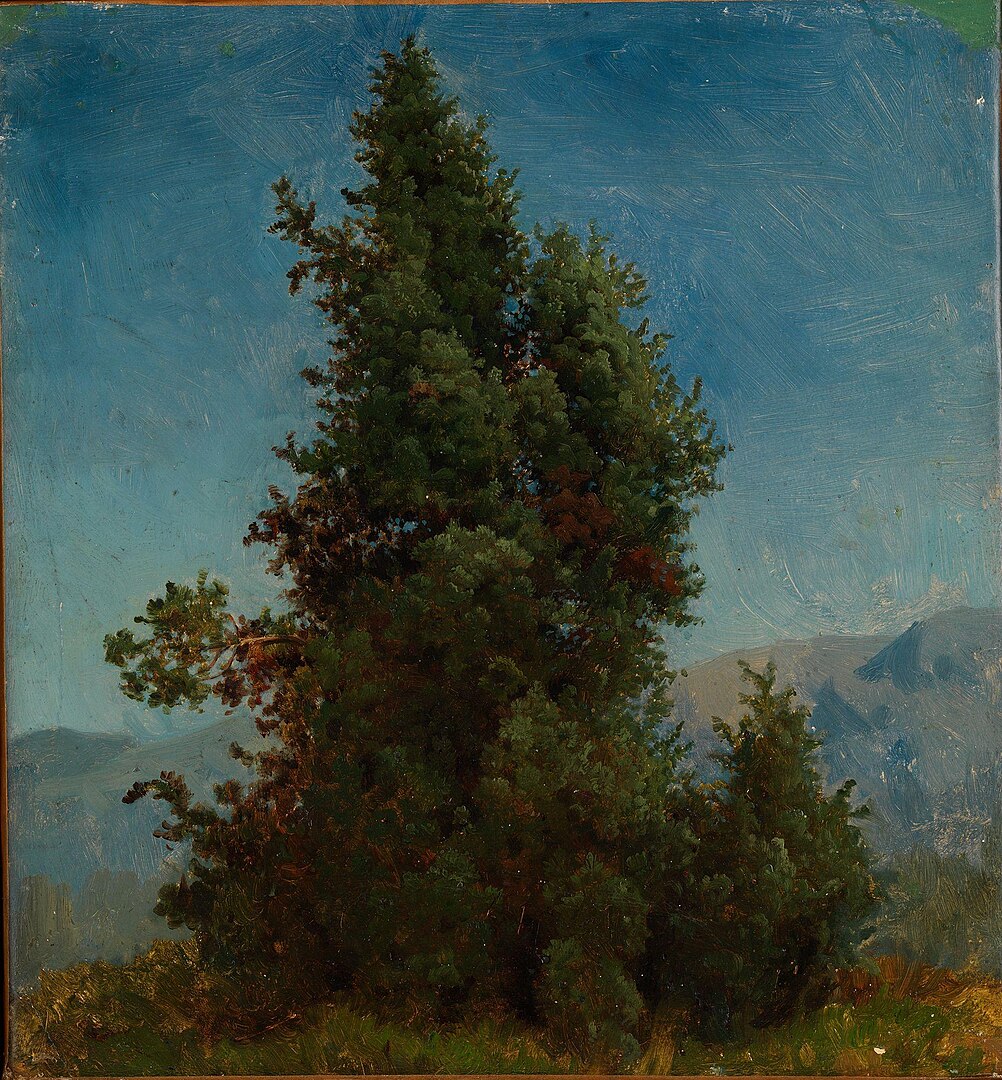
Courtesy: Nasjonalmuseet for kunst, arkitektur og design, The Fine Art Collections. “https://www.nasjonalmuseet.no//en/collection/object/NG.M.02410” is licensed under CC BY 4.0.
In Robert Frost’s poem “An Encounter” the tree is personified:
“An Encounter” by Robert Frost
Once on the kind of day called “weather breeder,”
When the heat slowly hazes and the sun
By its own power seems to be undone,
I was half boring through, half climbing through,
A swamp of cedar. Choked with oil of cedar
And scurf of plants, and weary and over-heated,
And sorry I ever left the road I knew,
I paused and rested on a sort of hook
That had me by the coat as good as seated,
And since there was no other way to look,
Looked up toward heaven, and there against the blue
Stood over me a resurrected tree,
A tree that had been down and raised again—
A barkless spectre. He had halted too,
As if for fear of treading upon me.
I saw the strange position of his hands—
Up at his shoulders, dragging yellow strands
Of wire with something in it from men to men.
“You here?” I said. “Where aren’t you nowadays?
And what’s the news you carry—if you know?
And tell me where you’re off for—Montreal?
Me? I’m not off for anywhere at all.
Sometimes I wander out of beaten ways
Half looking for the orchid Calypso.”
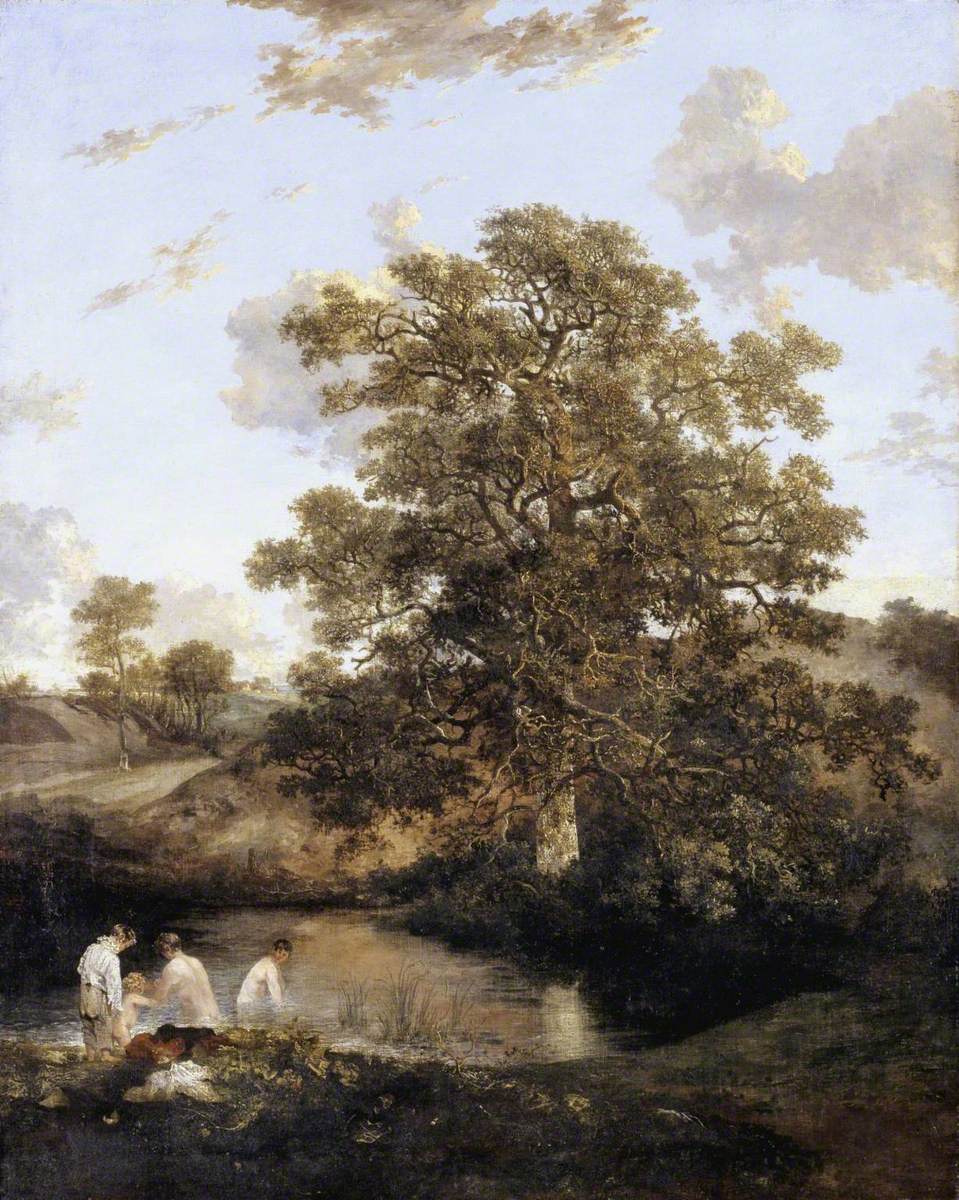
Courtesy: Photo © Tate.
“https://www.tate.org.uk/art/artworks/crome-the-poringland-oak-n02674” is licensed under CC-BY-NC-ND 3.0 (Unported).
“Trees in the Garden” by D.H. Lawrence
Ah in the thunder air
how still the trees are!
And the lime-tree, lovely and tall, every leaf silent
hardly looses even a last breath of perfume.
And the ghostly, creamy coloured little tree of leaves
white, ivory white among the rambling greens
how evanescent, variegated elder, she hesitates on the green grass
as if, in another moment, she would disappear
with all her grace of foam!
And the larch that is only a column, it goes up too tall to see:
and the balsam-pines that are blue with the grey-blue blueness of
things from the sea,
and the young copper beech, its leaves red-rosy at the ends
how still they are together, they stand so still
in the thunder air, all strangers to one another
as the green grass glows upwards, strangers in the silent garden.
Note about John Crome’s The Poringland Oak
“The Poringland Oak is one of the most celebrated paintings by the Norfolk artist John Crome, a member of the Norwich school….The picture, made in 1818, is dominated by a young, straight, and lightly branched oak. It rises beside a pond in which four village youngsters are bathing, or maybe just paddling. They are half clothed and facing away from the viewer, adding to their sense of rural informality. Whether the tree exists is uncertain. There is an oak beside a pond in Poringland (an expanding village south of Norwich) which may well be Crome’s tree grown on for a couple of centuries, and is championed by some locals as a candidate. The land around the pond has been developed, and the tree rises in the garden of a modern, bungalow- sized Free Church with attached café…” (Richard Mabey, The Cabaret of plants, W.W. Norton & Co. p. 99).
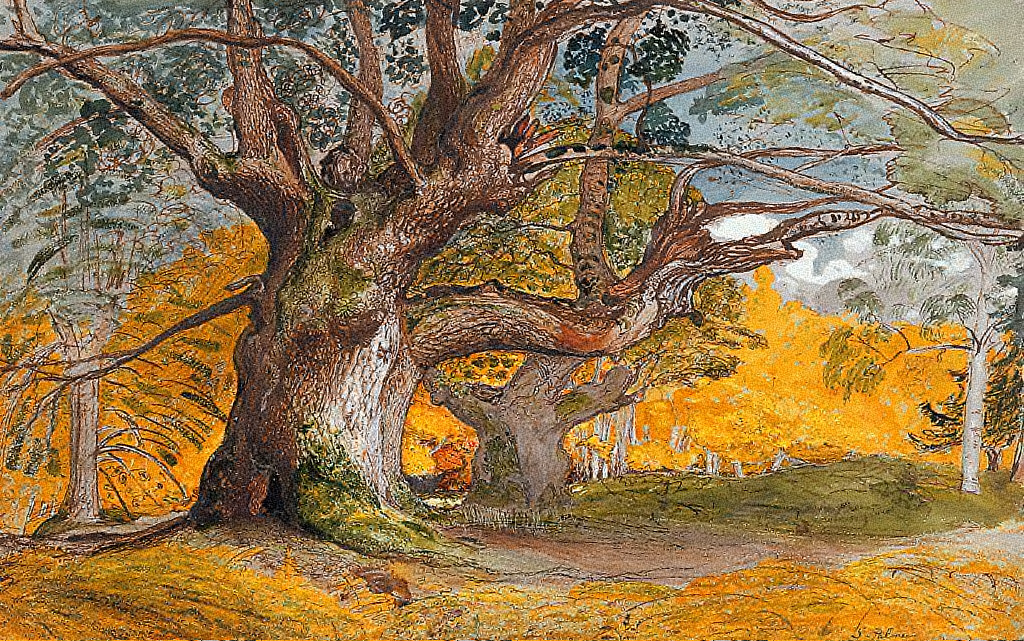
Courtesy: By Samuel Palmer – The AMICA Library, Public Domain, https://commons.wikimedia.org/w/index.php?curid=29964143
“Trees” by Bliss Carman
IN the Garden of Eden, planted by God,
There were goodly trees in the springing sod,-
Trees of beauty and height and grace,
To stand in splendor before His face.
Apple and hickory, ash and pear,
Oak and beech and the tulip rare,
The trembling aspen, the noble pine,
The sweeping elm by the river line;
Trees for the birds to build and sing,
And the lilac tree for a joy in spring;
Trees to turn at the frosty call
And carpet the ground for their Lord’s footfall;
Trees for fruitage and fire and shade,
Trees for the cunning builder’s trade;
Wood for the bow, the spear, and the flail,
The keel and the mast of the daring sail;
He made them of every grain and girth
For the use of man in the Garden of Earth.
Then lest the soul should not lift her eyes
From the gift to the Giver of Paradise,
On the crown of a hill, for all to see,
God planted a scarlet maple tree.
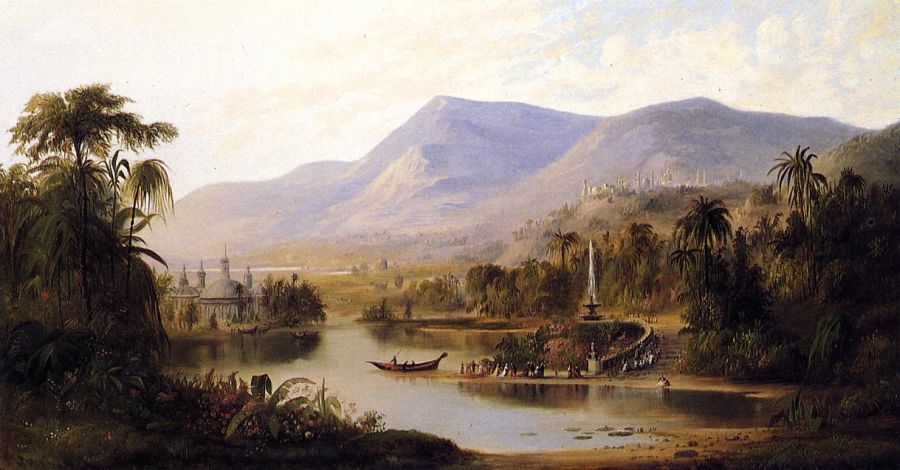
Courtesy: Sundry Purchase Fund. “https://www.clevelandart.org/art/2014.12” is licensed under CC0 1.0.
“The Mountain” by Emily Dickinson
The mountain sat upon the plain
In his eternal chair,
His observation omnifold,
His inquest everywhere.
The seasons prayed around his knees,
Like children round a sire:
Grandfather of the days is he,
Of dawn the ancestor.
For more information about poems related to mountains please open the link here.
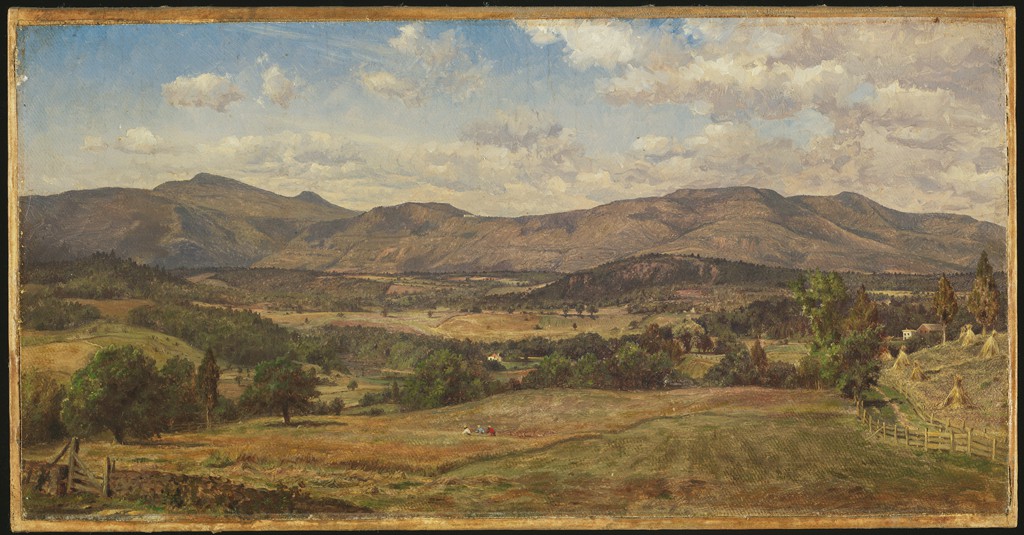
Courtesy: By Charles Herbert Moore – Harvard Art Museums, Public Domain, https://commons.wikimedia.org/w/index.php?curid=105517818
Think about the landscapes surrounding your community/city/town.
- How has the landscape changed today?
- Think of areas in your own neighbourhood that had recently been forests.
- Why were the forests destroyed?
- Which building were made in place?
- How necessary were these buildings?
- Was nature destroyed to make way for more commercial space?
- What are your thoughts about this?
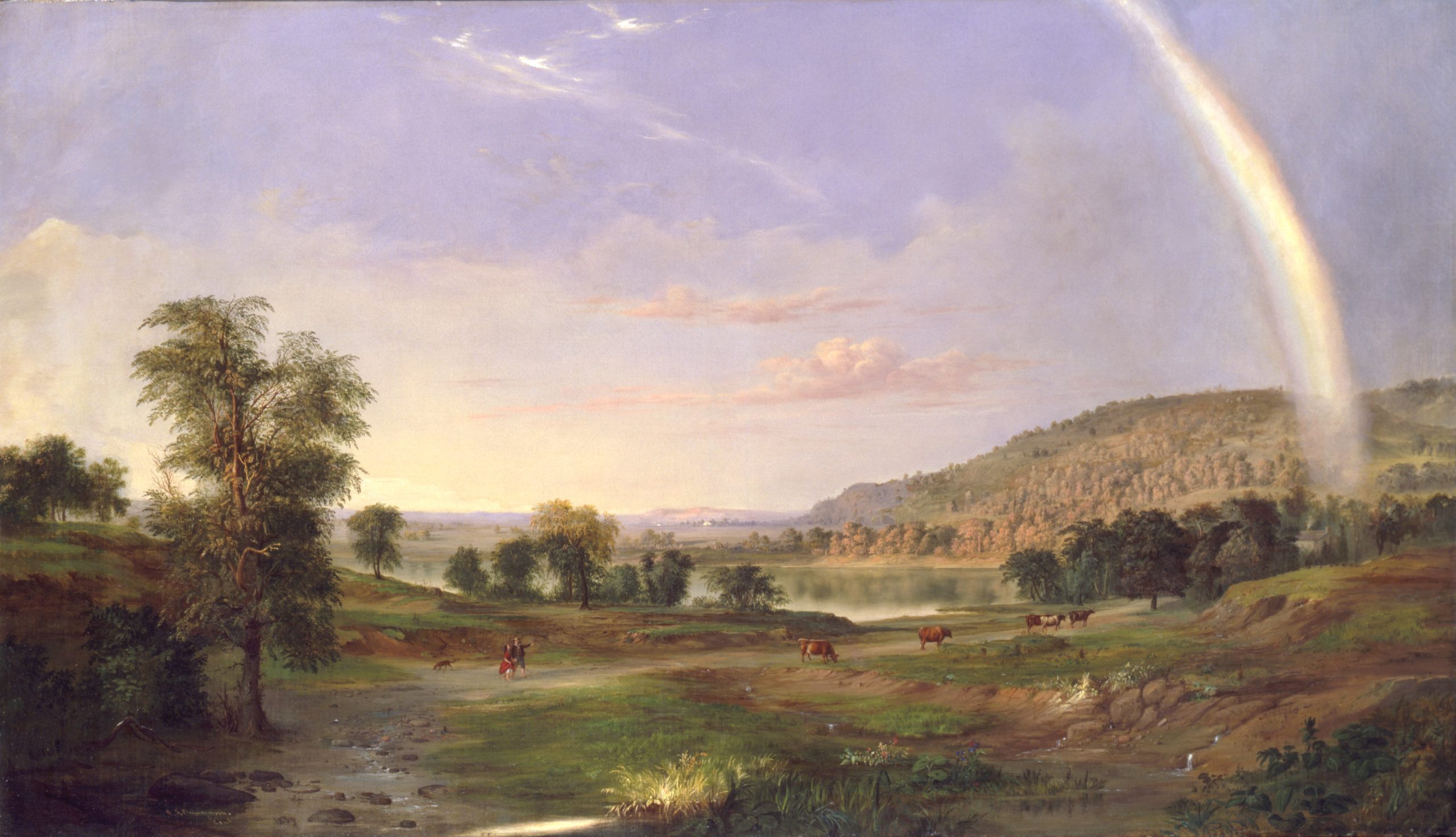
Courtesy: Gift of Leonard and Paula Granoff, 1983. “https://americanart.si.edu/artwork/landscape-rainbow-7601” is licensed under CC0 1.0.
“The Rainbow” by Christina Rossetti
Boats sail on the rivers,
And ships sail on the seas;
But clouds that sail across the sky
Are prettier than these.
There are bridges on the rivers,
As pretty as you please;
But the bow that bridges heaven,
And overtops the trees,
And builds a road from earth to sky
Is prettier far than these.
(From Evans, F. (2016), Favourite Poems: A Selection of the World’s Best-Loved Verse. Arcturus (Ed.). p.87.)
“The River” by Ralph Waldo Emerson
And I behold once more
My old familiar haunts; here the blue river,
The same blue wonder that my infant eye
Admired, sage doubting whence the traveller came,—
Whence brought his sunny bubbles ere he washed
The fragrant flag-roots in my father’s fields,
And where thereafter in the world he went.
Look, here he is, unaltered, save that now
He hath broke his banks and flooded all the vales
With his redundant waves……
Here is the rock where, yet a simple child,
I caught with bended pin my earliest fish,
Much triumphing, —and these the fields
Over whose flowers I chased the butterfly,
A blooming hunter of a fairy fine.
And hark! where overhead the ancient crows
Hold their sour conversation in the sky:—
These are the same, but I am not the same,
But wiser than I was, and wise enough
Not to regret the changes, tho’ they cost
Me many a sigh. Oh, call not Nature dumb;
These trees and stones are audible to me,
These idle flowers, that tremble in the wind,
I understand their faery syllables,
And all their sad significance. The wind,
That rustles down the well-known forest road—
It hath a sound more eloquent than speech.
The stream, the trees, the grass, the sighing wind,
All of them utter sounds of ’monishment
And grave parental love.
They are not of our race, they seem to say,
And yet have knowledge of our moral race,
And somewhat of majestic sympathy,
Something of pity for the puny clay,
That holds and boasts the immeasurable mind.
I feel as I were welcome to these trees
After long months of weary wandering,
Acknowledged by their hospitable boughs;
They know me as their son, for side by side,
They were coeval with my ancestors,
Adorned with them my country’s primitive times,
And soon may give my dust their funeral shade.
Type your textbox content here.
The Nature Poetry of Rainer Maria Rilke (1875-1926)
The mystical poems of Austrian poet Rainer Maria Rilke (1875-1926) also speak to a reciprocal, mysterious, and life affirming relationships to the Divine and to life itself. Rilke’s poems reflect a deep passion at the core of life ad a strong, connective energy that bonds all living things in the cosmos and beyond. Anita Barrow (1996) writes about Rilke’s ability to transform the ordinary into the extraordinary through greater self-awarenss and empathy. She explains that Rilke’s poems helped her realize that she is “in the world to love the world” (p.15) and this include the dramatic geographic landscapes that change as well as the intricate patterns and connections of life itself. “Rilke’s love for things of this world, his insistence that they, we, are sacred, his capacity to see the holy in the ordinary—all these have continued to inform my own poetry for thirty years”(Barrow, p.14). Rilke’s poems reflect a journey into the human heart, loneliness, suffering, redemption, and a search for deeper understanding of the divine throughout.” His poems stood in contast to a growing age of mechanization, alienation, war, suffering, class divisions, and poverty. Poems by Rainer Maria Rilke, Theodore Roethke, and the group of transcendentalist poets from the Romantic Age and throughout the 19th century and early 20th century can find new light and appreciation in the disruptive times we are living in. Poetry complemented with artistic images can serve as an inspiration and catalyst for deeper level emotional, cognitive, and spiritual learning.
References
Barrow, A. & May, J. (1996), Rilke’s Book of Hours. Riverhead Books.
Additional Source
- To read more poetry by Rainer Maria Rilke, please open the link here.
- Poems of Rainer Maria Rilke
“I Live My Life in Widening Circles” by Rainer Maria Rilke
and I still don’t know: am I a falcon,
a storm, or a great song?
Retrieved-see the link here and here.
Additional Source: Anita Barrow and Joanna May, 1996, Rilke’s Book of Hours, Riverhead Books.
“The Life Being Lived” by Rainer Maria Rilke
And yet, though we strain
Against the deadening grip
Of daily necessity,
I sense that there is this mystery:
All life is being lived.
Who is living it, then?
Is it the things themselves,
Or something waiting inside them,
Like an unplayed melody in a flute?
Is it the winds blowing over the waters?
Is it the branches that signal to each other?
Is it flower
Interweaving their fragrances,
Or streets, as they wind through time?
(From Anita Barrow and Joanna May, 1996, Rilke’s Book of Hours Riverhead Books, p.48).
“Evening” by Rainer Maria Rilke
The bleak fields are asleep,
My heart alone wakes;
The evening in the harbour
Down his red sails takes.
Night, guardian of dreams,
Now wanders through the land;
The moon, a lily white,
Blossoms within her hand.
“Autumn” by Rainer Maria Rilke
The leaves fall, fall as from far,
Like distant gardens withered in the heavens;
They fall with slow and lingering descent.
And in the nights the heavy Earth, too, falls
From out the stars into the Solitude.
Thus all doth fall. This hand of mine must fall
And lo! the other one:—it is the law.
But there is One who holds this falling
Infinitely softly in His hands.
“Solitude” by Rainer Maria Rilke
Solitude is like a rain
That from the sea at dusk begins to rise;
It floats remote across the far-off plain
Upward into its dwelling-place, the skies,
Then o’er the town it slowly sinks again.
Like rain it softly falls at that dim hour
When ghostly lanes turn toward the shadowy morn;
When bodies weighed with satiate passion’s power
Sad, disappointed from each other turn;
When men with quiet hatred burning deep
Together in a common bed must sleep—
Through the gray, phantom shadows of the dawn
Lo! Solitude floats down the river wan …
Thus all doth fall. This hand of mine must fall
And lo! the other one:—it is the law.
But there is One who holds this falling
Infinitely softly in His hands.
‘In April” by Rainer Maria Rilke
Again the woods are odorous, the lark
Lifts on upsoaring wings the heaven gray
That hung above the tree-tops, veiled and dark,
Where branches bare disclosed the empty day.
After long rainy afternoons an hour
Comes with its shafts of golden light and flings
Them at the windows in a radiant shower,
And rain drops beat the panes like timorous wings.
Then all is still. The stones are crooned to sleep
By the soft sound of rain that slowly dies;
And cradled in the branches, hidden deep
In each bright bud, a slumbering silence lies.
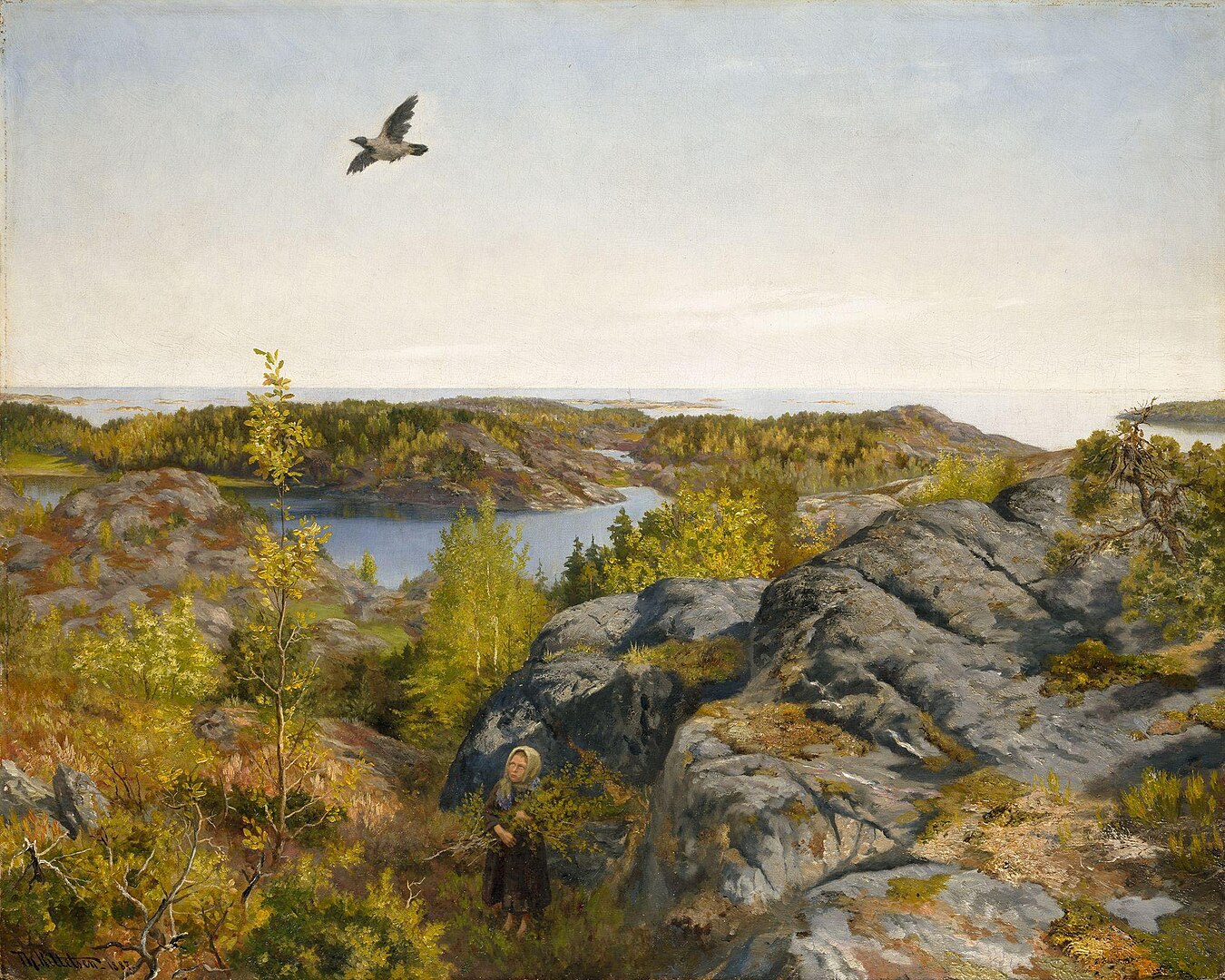
Courtesy: Nasjonalmuseet for kunst, arkitektur og design, The Fine Art Collections. “https://www.nasjonalmuseet.no/en/collection/object/NG.M.02099” is licensed under CC BY 4.0.
“Nothing Gold Can Stay” by Robert Frost
“What are Heavy?” by Christina Rossetti
What are heavy? Sea-sand and sorrow;
What are brief? To-day and to-morrow;
What are frail? Spring blossoms and youth;
What are deep? The ocean and truth.
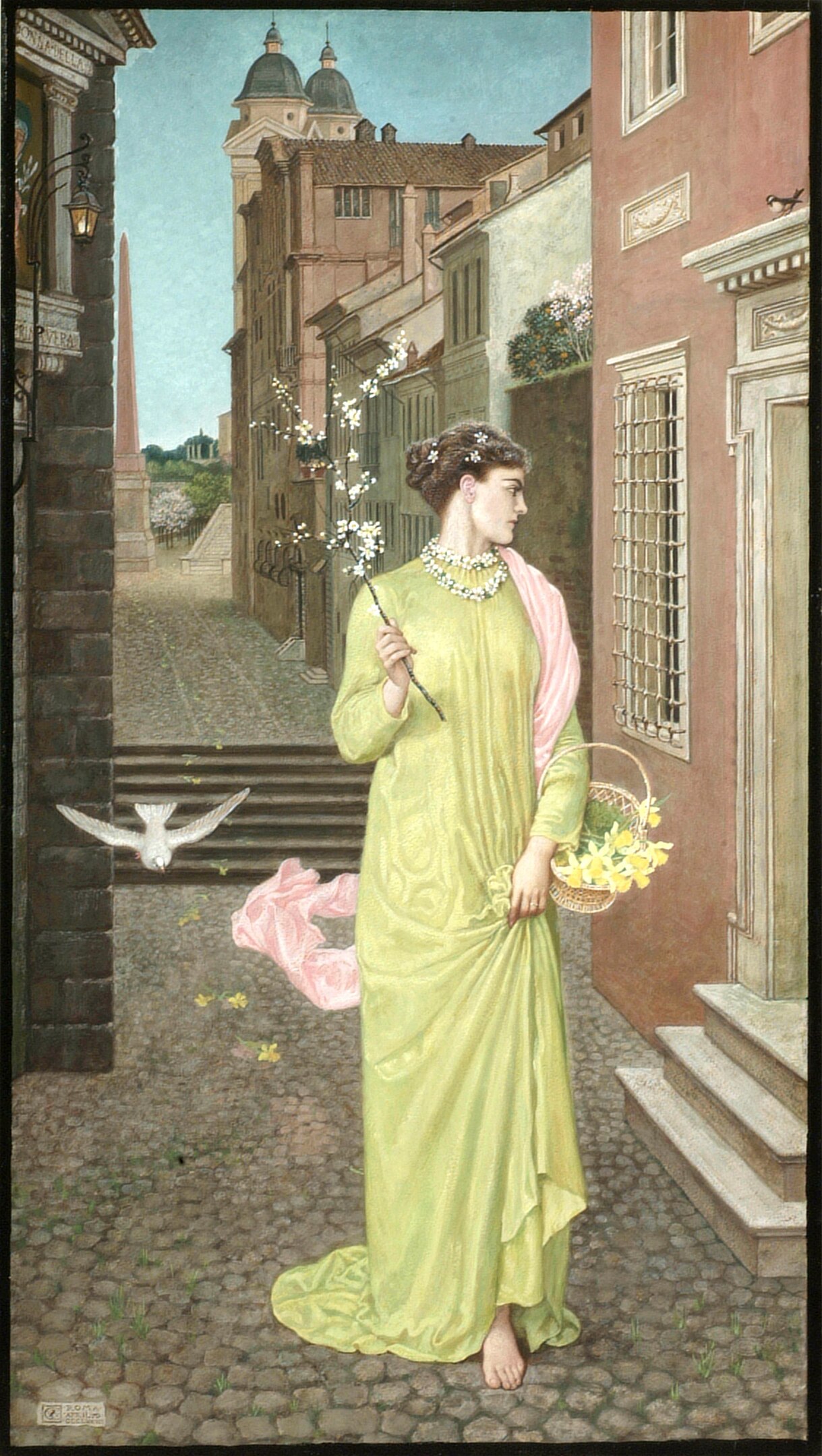
Courtesy: By Walter Crane – Birmingham Museums Trust, Public Domain, https://commons.wikimedia.org/w/index.php?curid=120047574
“Counting-Out Rhyme” by Edna St. Vincent Millay
Silver bark of beech, and sallow
Bark of yellow birch and yellow
Twig of willow.
Stripe of green in moosewood maple,
Colour seen in leaf of apple,
Bark of popple.
Wood of popple pale as moonbeam,
Wood of oak for yoke and barn-beam,
Wood of hornbeam.
Silver bark of beech, and hollow
Stem of elder, tall and yellow
Twig of willow.
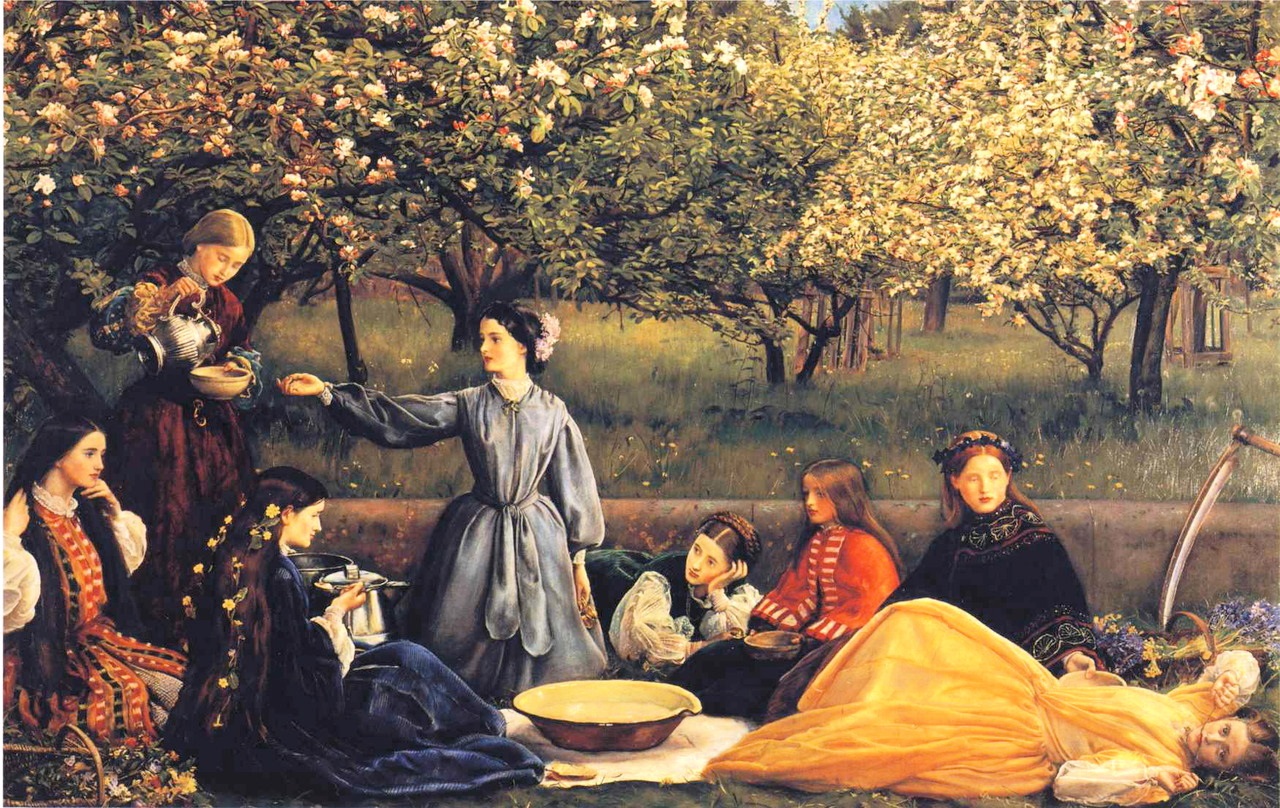
Courtesy: By John Everett Millais – scan of painting, Public Domain, https://commons.wikimedia.org/w/index.php?curid=6619278
“The Trees in the Garden Rained Flowers” by Stephen Crane
The trees in the garden rained flowers.
Children ran there joyously.
They gathered the flowers
Each to himself.
Now there were some
Who gathered heaps—
Having opportunity and skill—
Until, behold, only chance blossoms
Remained for the feeble.
Then a little spindling tutor
Ran importantly to her father, crying:
“Pray, come hither!”
See this unjust thing in your garden!”
But when the father had surveyed,
He admonished the tutor:
“Not so, small sage!
This thing is just.
For look you,
Are not they who possess the flowers
Stronger, bolder, shrewder
Than they who have none?
Why should the strong—
The beautiful strong—
Why should not they have the flowers?”
Upon reflection, the tutor bowed to the ground,
“My lord,” he said,
“The stars are displaced
By this towering wisdom.”
“Summer” by John Clare
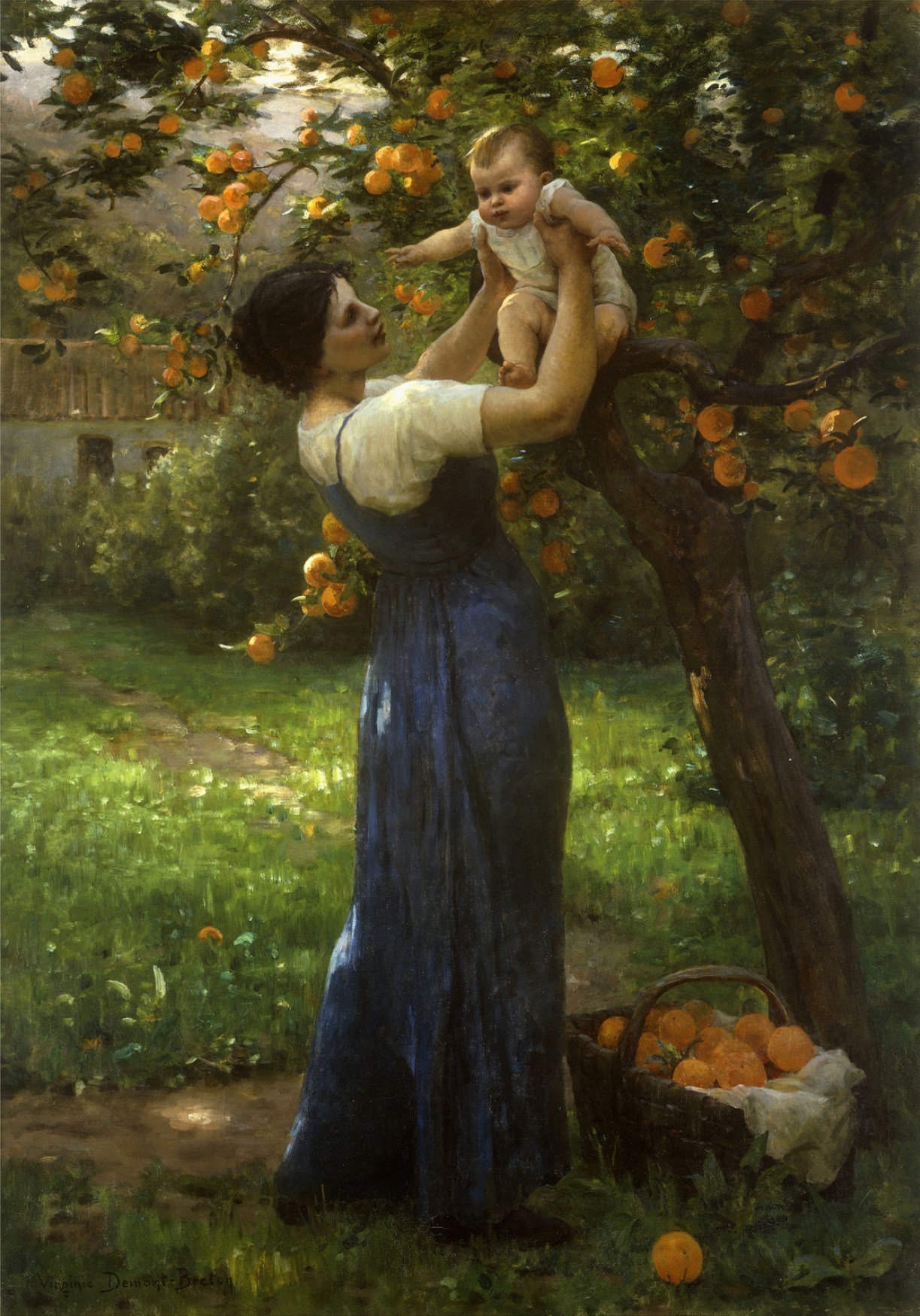
Courtesy: By Virginie Demont-Breton – Bridgeman Art Library: Object 487572, Public Domain, https://commons.wikimedia.org/w/index.php?curid=31803837
“The Orange Tree” by John Shaw Neilson
The young girl stood beside me. I
Saw not what her young eyes could see:
– A light, she said, not of the sky
Lives somewhere in the Orange Tree.
– Is it, I said, of east or west?
The heartbeat of a luminous boy
Who with his faltering flute confessed
Only the edges of his joy?
Was he, I said, borne to the blue
In a mad escapade of Spring
Ere he could make a fond adieu
To his love in the blossoming?
– Listen! the young girl said. There calls
No voice, no music beats on me;
But it is almost sound: it falls
This evening on the Orange Tree.
– Does he, I said, so fear the Spring
Ere the white sap too far can climb?
See in the full gold evening
All happenings of the olden time?
Is he so goaded by the green?
Does the compulsion of the dew
Make him unknowable but keen
Asking with beauty of the blue?
– Listen! the young girl said. For all
Your hapless talk you fail to see
There is a light, a step, a call
This evening on the Orange Tree.
– Is it, I said, a waste of love
Imperishably old in pain,
Moving as an affrighted dove
Under the sunlight or the rain?
Is it a fluttering heart that gave
Too willingly and was reviled?
Is it the stammering at a grave,
The last word of a little child?
– Silence! the young girl said. Oh, why,
Why will you talk to weary me?
Plague me no longer now,
for I am listening like the Orange Tree
“The Tree” by Ezra Pound
I stood still and was a tree amid the wood,
Knowing the truth of things unseen before;
Of Daphne and the laurel bow
And that god-feasting couple old
that grew elm-oak amid the wold.
‘Twas not until the gods had been
Kindly entreated, and been brought within
Unto the hearth of their heart’s home
That they might do this wonder thing;
Nathless I have been a tree amid the wood
And many a new thing understood
That was rank folly to my head before.
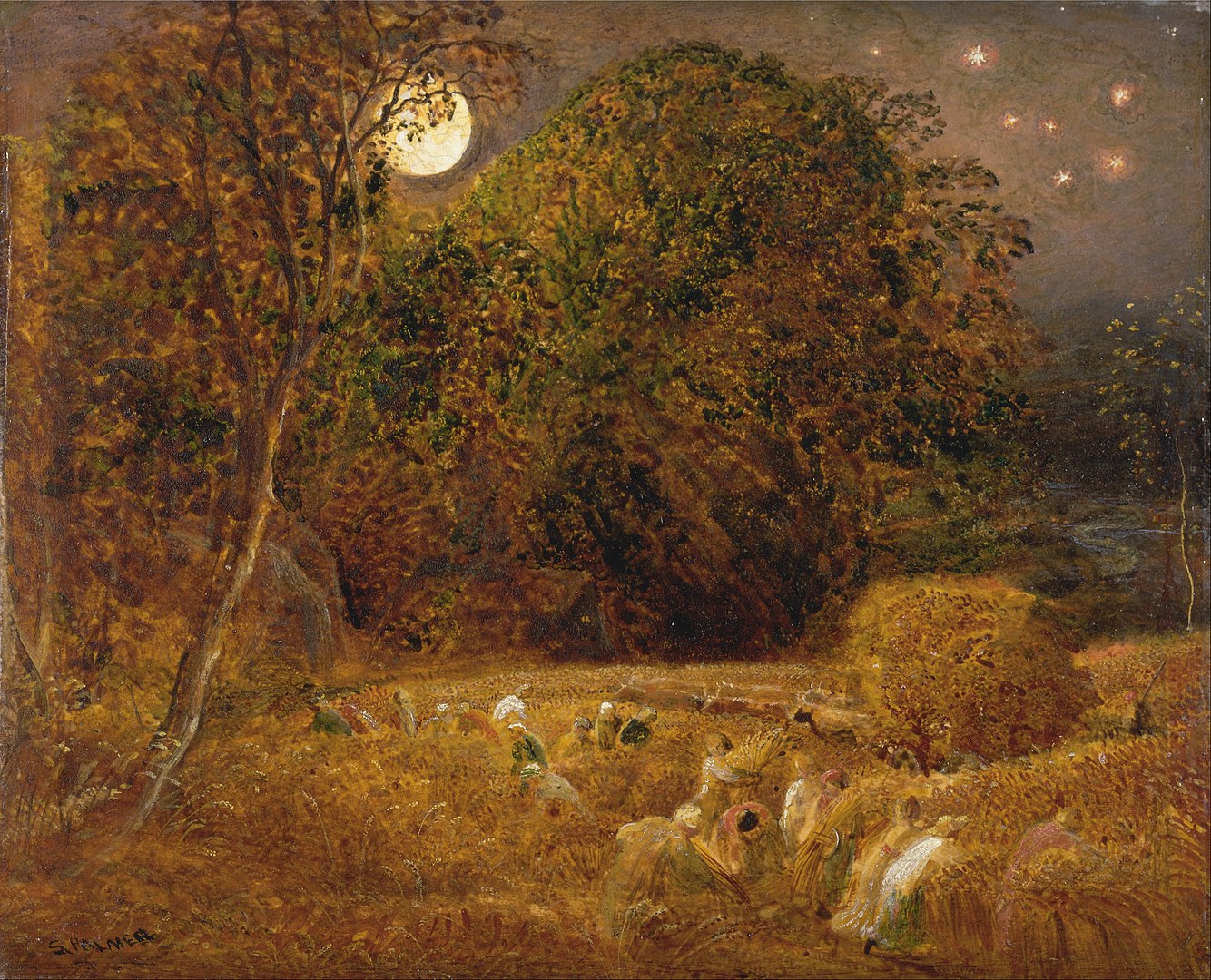
Courtesy: Yale Center for British Art, Paul Mellon Collection. “https://collections.britishart.yale.edu/catalog/tms:414” is licensed under CC0 1.0.
“Theme in Yellow” by Carl Sandburg
I spot the hills
With yellow balls in autumn.
I light the prairie cornfields
Orange and tawny gold clusters
And I am called pumpkins.
On the last of October
When dusk is fallen
Children join hands
And circle round me
Singing ghost songs
And love to the harvest moon;
I am a jack-o’-lantern
With terrible teeth
And the children know
I am fooling.
Additional Sources
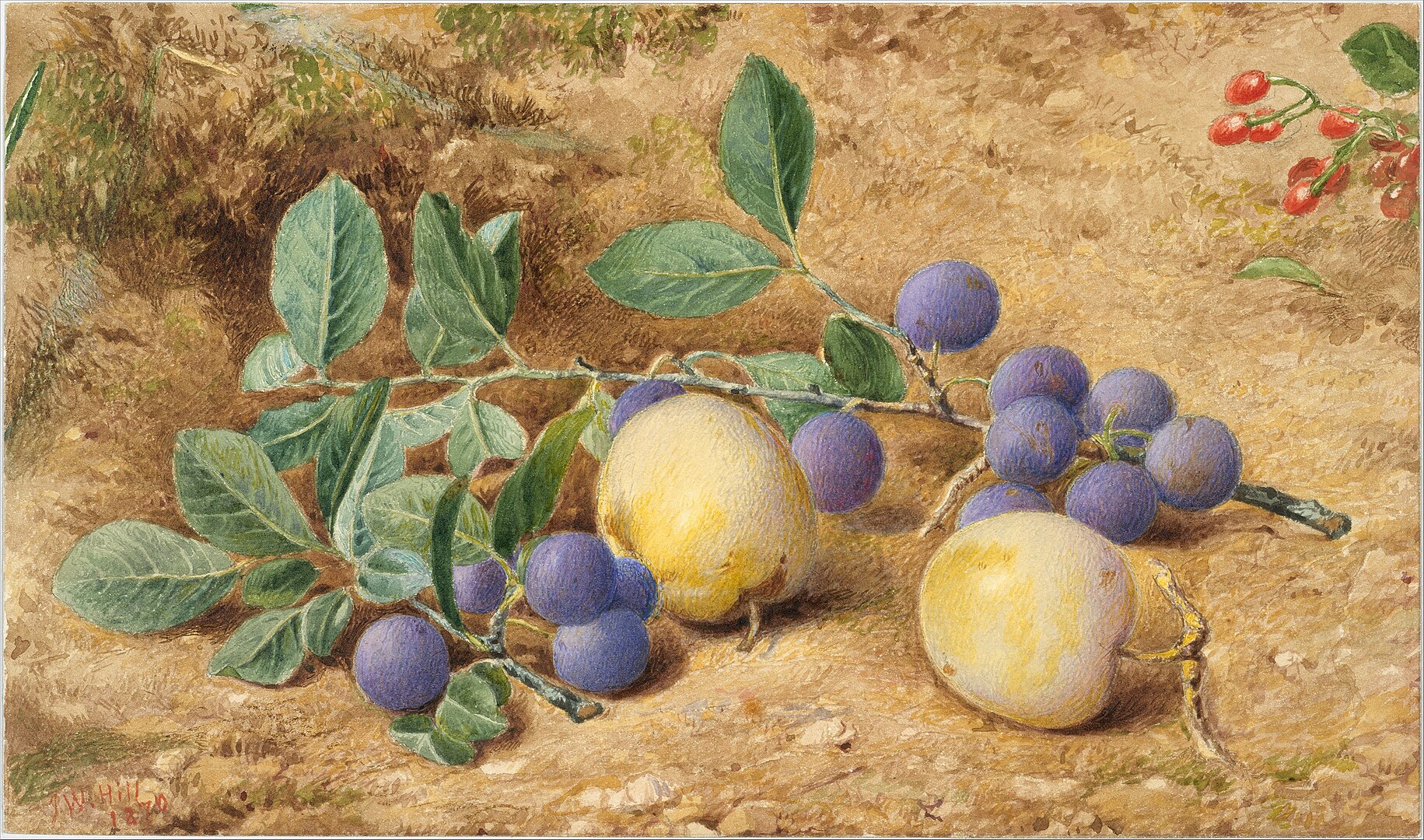
Courtesy: Gift of J. Henry Hill, 1882. “https://www.metmuseum.org/art/collection/search/11096” is licensed under CC0 1.0.
Additional Resources about Flowers
Allen, M. (1979). The family of flowers (illustrated by Julia Morland and Andrew Crane). Pitman.
Besler, B. (2001). The book of botanical prints. Tashen.
Besler, B. (1561-1629). Botanical illustrations, 2023, Wikimedia.
Biodiversity Heritage Library. The artistry of flowers. https://www.biodiversitylibrary.org/browse/collection/LanguageofFlowers
Chatfield, J. (1991). The classic Italian garden (photographs by Umberto Perugi). Rizzola.
Crane, W. Flowers from Shakespeare’s garden, 2020, Project Gutenberg, https://www.gutenberg.org/files/64102/64102-h/64102-h.htm
Foley, C. (2006). Country poems. Capella.
Harkness, P. (2003). The rose: A colourful inheritance. The Royal Horticultural Society (Scriptum Edition).
Kew Gardens, Richmond, Surrey, UK. Botanical Library.https://www.kew.org/science/collections-and-resources/collections/library
Morley, B. (1970). B. Wild flowers in the world: A thousand plants painted by Barabara Everard. Rainbird Reference Books.
Muir, J. (1916).A thousand mile walk to the gulf. Project Gutenberg, 2019. https://www.gutenberg.org/files/60749/60749-h/60749-h.htm
Fahy, E. (1982). Metropolitan flowers (design by Alvin Grossman). The Metropolitan Museum of Art, New York.
Foshay, E.M. (1984) Reflections of nature: Flowers in American art. Weathervane Books.
Greenaway, K. (2021). The language of flowers, 2021, Project Gutenberg, https://www.gutenberg.org/cache/epub/31591/pg31591-images.html. (originally published in 1884 by John Routledge & Co.).
Hunt, D. (1980). The flowers of Shakespeare (foreword by Flora Robson). Webb & Bower.
King, R. (1979). Botanical Illustrations. C.N. Potter distributed by Crown Publications.
Knapp, S. (2003). Flora: An artistic voyage through the world of plants. Natural History Museum, London.
Lawrence, L. (1981). The seasons. Nelson Canada Ltd.
Michale, E. (2020). Things you should know about Maryanne North. Kew Gardens Library, Richmond, Surrey, UK. https://www.kew.org/read-and-watch/marianne-north-botanical-artist
Murray, A. J. A (1980). A regency lady’s faery bower. Holt, Rinehart, & Co.
Richardson, D. L. Flowers and flower-gardens, 2023, Internet Archive, https://archive.org/details/flowersandflowe00richgoog/mode/2up. University of Michigan. (originally published in 1855 by D’Rozario & Co.
Sanders, R. (1980). Portrait of a country garden. Aurum Press.
Thornton, R. J. (2023). The temple of flora, Garden of the botanist, poet, painter, and philosopher Dr. Robert John Thornton(1768-1837), 2023, Internet Archive. https://archive.org/details/gri_33125012607053 (originally published in 1812). Getty Research Institute.
- Biodiversity Heritage Library Language of Flowers
- The Project Gutenberg eBook of Flowers from Shakespeare’s Garden by William Shakespeare
- The Project Gutenberg eBook of Language of Flowers
- Things you should know about Marianne North
- Flowers and Flower-gardens
- Temple of Flora, or, Garden of the botanist, poet, painter, and philosopher
- For more information about the German botanical artist Basilius Belser (1561-1629), please open the link here.
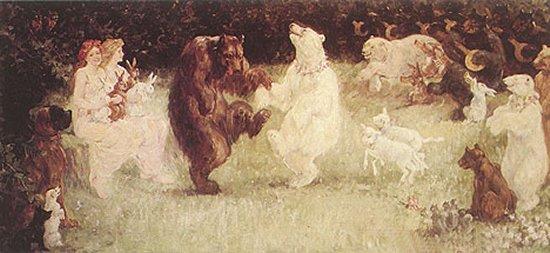
Courtesy: By Frederick Stuart Church – http://1.bp.blogspot.com/_EcfQTb3MMxw/Sd9i4EvnbkI/AAAAAAAAF0Y/0FGCVkN1x2I/s1600-h/Frederick+Stuart+Church.jpg, Public Domain, https://commons.wikimedia.org/w/index.php?curid=6878328

